

25,000+ students realised their study abroad dream with us. Take the first step today
Here’s your new year gift, one app for all your, study abroad needs, start your journey, track your progress, grow with the community and so much more.

Verification Code
An OTP has been sent to your registered mobile no. Please verify

Thanks for your comment !
Our team will review it before it's shown to our readers.

Essay on Sustainable Development: Samples in 250, 300 and 500 Words
- Updated on
- Nov 18, 2023
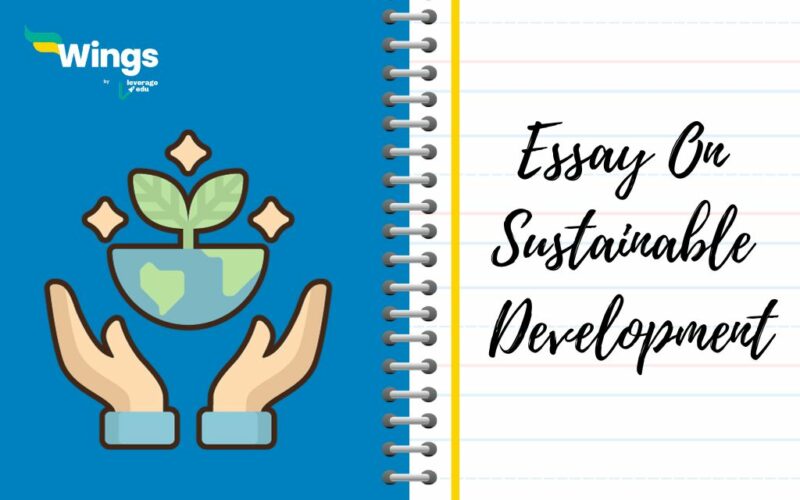
On 3rd August 2023, the Indian Government released its Net zero emissions target policy to reduce its carbon footprints. To achieve the sustainable development goals (SDG) , as specified by the UN, India is determined for its long-term low-carbon development strategy. Selfishly pursuing modernization, humans have frequently compromised with the requirements of a more sustainable environment.
As a result, the increased environmental depletion is evident with the prevalence of deforestation, pollution, greenhouse gases, climate change etc. To combat these challenges, the Ministry of Environment, Forest and Climate Change launched the National Clean Air Programme (NCAP) in 2019. The objective was to improve air quality in 131 cities in 24 States/UTs by engaging multiple stakeholders.
‘Development is not real until and unless it is sustainable development.’ – Ban Ki-Moon
The concept of Sustainable Development in India has even greater relevance due to the controversy surrounding the big dams and mega projects and related long-term growth. Since it is quite a frequently asked topic in school tests as well as competitive exams , we are here to help you understand what this concept means as well as the mantras to drafting a well-written essay on Sustainable Development with format and examples.
This Blog Includes:
What is sustainable development, 250-300 words essay on sustainable development, 300 words essay on sustainable development, 500 words essay on sustainable development, introduction, conclusion of sustainable development essay, importance of sustainable development, examples of sustainable development.
As the term simply explains, Sustainable Development aims to bring a balance between meeting the requirements of what the present demands while not overlooking the needs of future generations. It acknowledges nature’s requirements along with the human’s aim to work towards the development of different aspects of the world. It aims to efficiently utilise resources while also meticulously planning the accomplishment of immediate as well as long-term goals for human beings, the planet as well and future generations. In the present time, the need for Sustainable Development is not only for the survival of mankind but also for its future protection.
Looking for ideas to incorporate in your Essay on Sustainable Development? Read our blog on Energy Management – Find Your Sustainable Career Path and find out!
To give you an idea of the way to deliver a well-written essay, we have curated a sample on sustainable development below, with 250-300 words:
To give you an idea of the way to deliver a well-written essay, we have curated a sample on sustainable development below, with 300 + words:

Must Read: Article Writing
To give you an idea of the way to deliver a well-written essay, we have curated a sample on sustainable development below, with 500 + words:

Essay Format
Before drafting an essay on Sustainable Development, students need to get familiarised with the format of essay writing, to know how to structure the essay on a given topic. Take a look at the following pointers which elaborate upon the format of a 300-350 word essay.
Introduction (50-60 words) In the introduction, students must introduce or provide an overview of the given topic, i.e. highlighting and adding recent instances and questions related to sustainable development. Body of Content (100-150 words) The area of the content after the introduction can be explained in detail about why sustainable development is important, its objectives and highlighting the efforts made by the government and various institutions towards it. Conclusion (30-40 words) In the essay on Sustainable Development, you must add a conclusion wrapping up the content in about 2-3 lines, either with an optimistic touch to it or just summarizing what has been talked about above.
How to write the introduction of a sustainable development essay? To begin with your essay on sustainable development, you must mention the following points:
- What is sustainable development?
- What does sustainable development focus on?
- Why is it useful for the environment?
How to write the conclusion of a sustainable development essay? To conclude your essay on sustainable development, mention why it has become the need of the hour. Wrap up all the key points you have mentioned in your essay and provide some important suggestions to implement sustainable development.
The importance of sustainable development is that it meets the needs of the present generations without compromising on the needs of the coming future generations. Sustainable development teaches us to use our resources in the correct manner. Listed below are some points which tell us the importance of sustainable development.
- Focuses on Sustainable Agricultural Methods – Sustainable development is important because it takes care of the needs of future generations and makes sure that the increasing population does not put a burden on Mother Earth. It promotes agricultural techniques such as crop rotation and effective seeding techniques.
- Manages Stabilizing the Climate – We are facing the problem of climate change due to the excessive use of fossil fuels and the killing of the natural habitat of animals. Sustainable development plays a major role in preventing climate change by developing practices that are sustainable. It promotes reducing the use of fossil fuels which release greenhouse gases that destroy the atmosphere.
- Provides Important Human Needs – Sustainable development promotes the idea of saving for future generations and making sure that resources are allocated to everybody. It is based on the principle of developing an infrastructure that is can be sustained for a long period of time.
- Sustain Biodiversity – If the process of sustainable development is followed, the home and habitat of all other living animals will not be depleted. As sustainable development focuses on preserving the ecosystem it automatically helps in sustaining and preserving biodiversity.
- Financial Stability – As sustainable development promises steady development the economies of countries can become stronger by using renewable sources of energy as compared to using fossil fuels, of which there is only a particular amount on our planet.
Mentioned below are some important examples of sustainable development. Have a look:
- Wind Energy – Wind energy is an easily available resource. It is also a free resource. It is a renewable source of energy and the energy which can be produced by harnessing the power of wind will be beneficial for everyone. Windmills can produce energy which can be used to our benefit. It can be a helpful source of reducing the cost of grid power and is a fine example of sustainable development.
- Solar Energy – Solar energy is also a source of energy which is readily available and there is no limit to it. Solar energy is being used to replace and do many things which were first being done by using non-renewable sources of energy. Solar water heaters are a good example. It is cost-effective and sustainable at the same time.
- Crop Rotation – To increase the potential of growth of gardening land, crop rotation is an ideal and sustainable way. It is rid of any chemicals and reduces the chances of disease in the soil. This form of sustainable development is beneficial to both commercial farmers and home gardeners.
- Efficient Water Fixtures – The installation of hand and head showers in our toilets which are efficient and do not waste or leak water is a method of conserving water. Water is essential for us and conserving every drop is important. Spending less time under the shower is also a way of sustainable development and conserving water.
- Sustainable Forestry – This is an amazing way of sustainable development where the timber trees that are cut by factories are replaced by another tree. A new tree is planted in place of the one which was cut down. This way, soil erosion is prevented and we have hope of having a better, greener future.
Related Articles
The Sustainable Development Goals (SDGs) are a set of 17 global goals established by the United Nations in 2015. These include: No Poverty Zero Hunger Good Health and Well-being Quality Education Gender Equality Clean Water and Sanitation Affordable and Clean Energy Decent Work and Economic Growth Industry, Innovation, and Infrastructure Reduced Inequality Sustainable Cities and Communities Responsible Consumption and Production Climate Action Life Below Water Life on Land Peace, Justice, and Strong Institutions Partnerships for the Goals
The SDGs are designed to address a wide range of global challenges, such as eradicating extreme poverty globally, achieving food security, focusing on promoting good health and well-being, inclusive and equitable quality education, etc.
India is ranked #111 in the Sustainable Development Goal Index 2023 with a score of 63.45.
Hence, we hope that this blog helped you understand the key features of an essay on sustainable development. If you are interested in Environmental studies and planning to pursue sustainable tourism courses , take the assistance of Leverage Edu ’s AI-based tool to browse through a plethora of programs available in this specialised field across the globe and find the best course and university combination that fits your interests, preferences and aspirations. Call us immediately at 1800 57 2000 for a free 30-minute counselling session
Team Leverage Edu
Leave a Reply Cancel reply
Save my name, email, and website in this browser for the next time I comment.
Contact no. *
Thanks a lot for this important essay.
NICELY AND WRITTEN WITH CLARITY TO CONCEIVE THE CONCEPTS BEHIND SUSTAINABLE DEVELOPMENT IN SCIENCE AND TECHNOLOGY.
Thankyou so much!

Leaving already?
8 Universities with higher ROI than IITs and IIMs
Grab this one-time opportunity to download this ebook
Connect With Us
25,000+ students realised their study abroad dream with us. take the first step today..

Resend OTP in

Need help with?
Study abroad.
UK, Canada, US & More
IELTS, GRE, GMAT & More
Scholarship, Loans & Forex
Country Preference
New Zealand
Which English test are you planning to take?
Which academic test are you planning to take.
Not Sure yet
When are you planning to take the exam?
Already booked my exam slot
Within 2 Months
Want to learn about the test
Which Degree do you wish to pursue?
When do you want to start studying abroad.
September 2024
January 2025
What is your budget to study abroad?

How would you describe this article ?
Please rate this article
We would like to hear more.
Sustainable Development Essay
500+ words essay on sustainable development.
Sustainable development is a central concept. It is a way of understanding the world and a method for solving global problems. The world population continues to rise rapidly. This increasing population needs basic essential things for their survival such as food, safe water, health care and shelter. This is where the concept of sustainable development comes into play. Sustainable development means meeting the needs of people without compromising the ability of future generations. In this essay on sustainable development, students will understand what sustainable development means and how we can practise sustainable development. Students can also access the list of CBSE essay topics to practise more essays.
What Does Sustainable Development Means?
The term “Sustainable Development” is defined as the development that meets the needs of the present generation without excessive use or abuse of natural resources so that they can be preserved for the next generation. There are three aims of sustainable development; first, the “Economic” which will help to attain balanced growth, second, the “Environment”, to preserve the ecosystem, and third, “Society” which will guarantee equal access to resources to all human beings. The key principle of sustainable development is the integration of environmental, social, and economic concerns into all aspects of decision-making.
Need for Sustainable Development?
There are several challenges that need attention in the arena of economic development and environmental depletion. Hence the idea of sustainable development is essential to address these issues. The need for sustainable development arises to curb or prevent environmental degradation. It will check the overexploitation and wastage of natural resources. It will help in finding alternative sources to regenerate renewable energy resources. It ensures a safer human life and a safer future for the next generation.
The COVID-19 pandemic has underscored the need to keep sustainable development at the very core of any development strategy. The pandemic has challenged the health infrastructure, adversely impacted livelihoods and exacerbated the inequality in the food and nutritional availability in the country. The immediate impact of the COVID-19 pandemic enabled the country to focus on sustainable development. In these difficult times, several reform measures have been taken by the Government. The State Governments also responded with several measures to support those affected by the pandemic through various initiatives and reliefs to fight against this pandemic.
How to Practise Sustainable Development?
The concept of sustainable development was born to address the growing and changing environmental challenges that our planet is facing. In order to do this, awareness must be spread among the people with the help of many campaigns and social activities. People can adopt a sustainable lifestyle by taking care of a few things such as switching off the lights when not in use; thus, they save electricity. People must use public transport as it will reduce greenhouse gas emissions and air pollution. They should save water and not waste food. They build a habit of using eco-friendly products. They should minimise waste generation by adapting to the principle of the 4 R’s which stands for refuse, reduce, reuse and recycle.
The concept of sustainable development must be included in the education system so that students get aware of it and start practising a sustainable lifestyle. With the help of empowered youth and local communities, many educational institutions should be opened to educate people about sustainable development. Thus, adapting to a sustainable lifestyle will help to save our Earth for future generations. Moreover, the Government of India has taken a number of initiatives on both mitigation and adaptation strategies with an emphasis on clean and efficient energy systems; resilient urban infrastructure; water conservation & preservation; safe, smart & sustainable green transportation networks; planned afforestation etc. The Government has also supported various sectors such as agriculture, forestry, coastal and low-lying systems and disaster management.
Students must have found this essay on sustainable development useful for practising their essay writing skills. They can get the study material and the latest updates on CBSE/ICSE/State Board/Competitive Exams, at BYJU’S.
Frequently Asked Questions on Sustainable development Essay
Why is sustainable development a hot topic for discussion.
Environment change and constant usage of renewable energy have become a concern for all of us around the globe. Sustainable development must be inculcated in young adults so that they make the Earth a better place.
What will happen if we do not practise sustainable development?
Landfills with waste products will increase and thereby there will be no space and land for humans and other species/organisms to thrive on.
What are the advantages of sustainable development?
Sustainable development helps secure a proper lifestyle for future generations. It reduces various kinds of pollution on Earth and ensures economic growth and development.
Leave a Comment Cancel reply
Your Mobile number and Email id will not be published. Required fields are marked *
Request OTP on Voice Call
Post My Comment
- Share Share
Register with BYJU'S & Download Free PDFs
Register with byju's & watch live videos.

Counselling
Sustainable Development Goals
The Sustainable Development Goals were adopted by the United Nations in 2015 as a call-to-action for people worldwide to address five critical areas of importance by 2030: people, planet, prosperity, peace, and partnership.
Biology, Health, Conservation, Geography, Human Geography, Social Studies, Civics
Set forward by the United Nations (UN) in 2015, the Sustainable Development Goals (SDG) are a collection of 17 global goals aimed at improving the planet and the quality of human life around the world by the year 2030.
Image courtesy of the United Nations
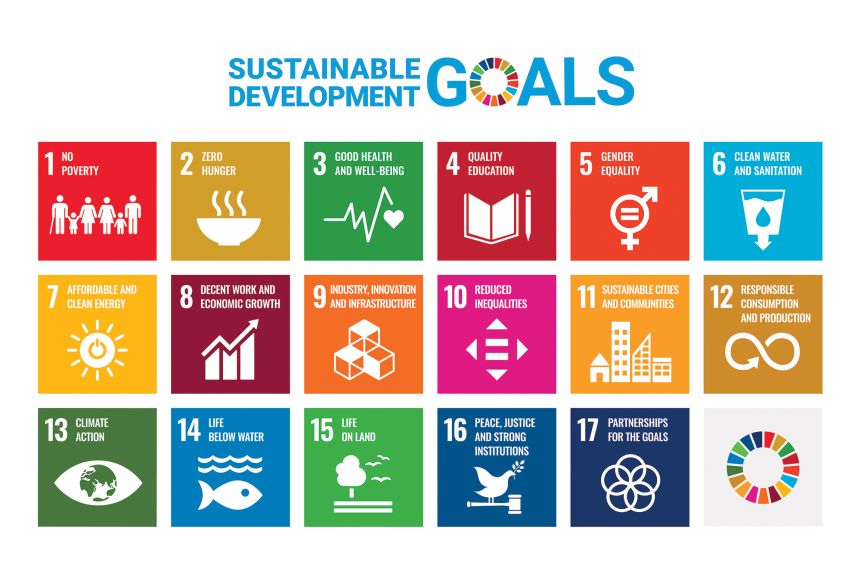
In 2015, the 193 countries that make up the United Nations (UN) agreed to adopt the 2030 Agenda for Sustainable Development. The historic agenda lays out 17 Sustainable Development Goals (SDGs) and targets for dignity, peace, and prosperity for the planet and humankind, to be completed by the year 2030. The agenda targets multiple areas for action, such as poverty and sanitation , and plans to build up local economies while addressing people's social needs.
In short, the 17 SDGs are:
Goal 1: No Poverty: End poverty in all its forms everywhere.
Goal 2: Zero Hunger: End hunger, achieve food security and improved nutrition and promote sustainable agriculture.
Goal 3: Good Health and Well-being: Ensure healthy lives and promote well-being for all at all ages.
Goal 4: Quality Education: Ensure inclusive and equitable quality education and promote lifelong learning opportunities for all.
Goal 5: Gender Equality : Achieve gender equality and empower all women and girls.
Goal 6: Clean Water and Sanitation: Ensure availability and sustainable management of water and sanitation for all.
Goal 7: Affordable and Clean Energy: Ensure access to affordable, reliable, sustainable and modern energy for all.
Goal 8: Decent Work and Economic Growth: Promote sustained, inclusive and sustainable economic growth, full and productive employment and decent work for all.
Goal 9: Industry, Innovation, and Infrastructure: Build resilient infrastructure, promote inclusive and sustainable industrialization, and foster innovation.
Goal 10: Reduced Inequality : Reduce in equality within and among countries.
Goal 11: Sustainable Cities and Communities: Make cities and human settlements inclusive, safe, resilient, and sustainable.
Goal 12: Responsible Consumption and Production: Ensure sustainable consumption and production patterns.
Goal 13: Climate Action: Take urgent action to combat climate change and its impacts.
Goal 14: Life Below Water: Conserve and sustainably use the oceans, seas, and marine resources for sustainable development.
Goal 15: Life on Land: Protect, restore, and promote sustainable use of terrestrial ecosystems, sustainably manage forests, combat desertification, and halt and reverse land degradation and halt biodiversity loss.
Goal 16: Peace, Justice , and Strong Institutions: Promote peaceful and inclusive societies for sustainable development, provide access to justice for all and build effective, accountable, and inclusive institutions at all levels.
Goal 17: Partnerships to Achieve the Goal: Strengthen the means of implementation and revitalize the global partnership for sustainable development.
The SDGs build on over a decade of work by participating countries. In essence, the SDGs are a continuation of the eight Millennium Development Goals (MDGs), which began in the year 2000 and ended in 2015. The MDGs helped to lift nearly one billion people out of extreme poverty, combat hunger, and allow more girls to attend school. The MDGs, specifically goal seven, helped to protect the planet by practically eliminating global consumption of ozone-depleting substances; planting trees to offset the loss of forests; and increasing the percent of total land and coastal marine areas worldwide. The SDGs carry on the momentum generated by the MDGs with an ambitious post-2015 development agenda that may cost over $4 trillion each year. The SDGs were a result of the 2012 Rio+20 Earth Summit, which demanded the creation of an open working group to develop a draft agenda for 2015 and onward.
Unlike the MDGs, which relied exclusively on funding from governments and nonprofit organizations, the SDGs also rely on the private business sector to make contributions that change impractical and unsustainable consumption and production patterns. Novozymes, a purported world leader in biological solutions, is just one example of a business that has aligned its goals with the SDGs. Novozymes has prioritized development of technology that reduces the amount of water required for waste treatment. However, the UN must find more ways to meaningfully engage the private sector to reach the goals, and more businesses need to step up to the plate to address these goals.
Overall, limited progress has been made with the SDGs. According to the UN, many people are living healthier lives now compared to the start of the millennium, representing one area of progress made by the MDGs and SDGs. For example, the UN reported that between 2012 and 2017, 80 percent of live births worldwide had assistance from a skilled health professional—an improvement from 62 percent between 2000 and 2005.
While some progress has been made, representatives who attended sustainable development meetings claimed that the SDGs are not being accomplished at the speed, or with the appropriate momentum, needed to meet the 2030 deadline. On some measures of poverty, only slight improvements have been made: The 2018 SDGs Report states that 9.2 percent of the world's workers who live with family members made less than $1.90 per person per day in 2017, representing less than a 1 percent improvement from 2015. Another issue is the recent rise in world hunger. Rates had been steadily declining, but the 2018 SDGs Report stated that over 800 million people were undernourished worldwide in 2016, which is up from 777 million people in 2015.
Another area of the SDGs that lacks progress is gender equality. Multiple news outlets have recently reported that no country is on track to achieve gender equality by 2030 based on the SDG gender index. On a scale of zero to 100, where a score of 100 means equality has been achieved, Denmark was the top performing country out of 129 countries with score slightly under 90. A score of 90 or above means a country is making excellent progress in achieving the goals, and 59 or less is considered poor headway. Countries were scored against SDGs targets that particularly affect women, such as access to safe water or the Internet. The majority of the top 20 countries with a good ranking were European countries, while sub-Saharan Africa had some of the lowest-ranking countries. The overall average score of all countries is a poor score of 65.7.
In fall of 2019, heads of state and government will convene at the United Nations Headquarters in New York to assess the progress in the 17 SDGs. The following year—2020—marks the deadline for 21 of the 169 SDG targets. At this time, UN member states will meet to make a decision to update these targets.
In addition to global efforts to achieve the SDGs, according to the UN, there are ways that an individual can contribute to progress: save on electricity while home by unplugging appliances when not in use; go online and opt in for paperless statements instead of having bills mailed to the house; and report bullying online when seen in a chat room or on social media.
Media Credits
The audio, illustrations, photos, and videos are credited beneath the media asset, except for promotional images, which generally link to another page that contains the media credit. The Rights Holder for media is the person or group credited.
Production Managers
Program specialists, last updated.
October 19, 2023
User Permissions
For information on user permissions, please read our Terms of Service. If you have questions about how to cite anything on our website in your project or classroom presentation, please contact your teacher. They will best know the preferred format. When you reach out to them, you will need the page title, URL, and the date you accessed the resource.
If a media asset is downloadable, a download button appears in the corner of the media viewer. If no button appears, you cannot download or save the media.
Text on this page is printable and can be used according to our Terms of Service .
Interactives
Any interactives on this page can only be played while you are visiting our website. You cannot download interactives.
Related Resources

The Sustainable Development Agenda

17 Goals for People, for Planet
World leaders came together in 2015 and made a historic promise to secure the rights and well-being of everyone on a healthy, thriving planet when they adopted the 2030 Agenda for Sustainable Development and its 17 Sustainable Development Goals (SDGs) .
The Agenda remains the world’s roadmap for ending poverty, protecting the planet and tackling inequalities. The 17 SDGs, the cornerstone of the Agenda, offer the most practical and effective pathway to tackle the causes of violent conflict, human rights abuses, climate change and environmental degradation and aim to ensure that no one will be left behind. The SDGs reflect an understanding that sustainable development everywhere must integrate economic growth, social well-being and environmental protection.
Keeping the Promise
While a fragile global economy, rising conflicts and the climate emergency have placed the promise of the Goals in peril, we can still turn things around in the remaining seven years. Notably, there has been some SDG success since 2015 with improvements in key areas, including poverty reduction, child mortality, electricity access and the battle against certain diseases.
Countries continue to supercharge efforts to achieve the SDGs. We see this at the annual High-Level Political Forum on Sustainable Development — the central platform for reviewing progress on the SDGs — where for the last eight years, countries, civil society and businesses have gathered to showcase the bold actions they are taking to achieve the SDGs.
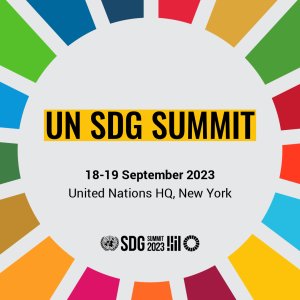
Every four years, the High-Level Political Forum meets under the auspices of the UN General Assembly, known as the SDG Summit . In 2023, the second SDG Summit took place on September 18-19, bringing together Heads of State and Government to catalyze renewed efforts towards accelerating progress on the SDGs. The Summit culminated in the adoption of a political declaration to accelerate action to achieve the 17 goals.
A Decade of Action

The UN Secretary-General called on all sectors of society to mobilize for a decade of action on three levels: global action to secure greater leadership, more resources and smarter solutions for the Sustainable Development Goals; local action embedding the needed transitions in the policies, budgets, institutions and regulatory frameworks of governments, cities and local authorities; and people action , including by youth, civil society, the media, the private sector, unions, academia and other stakeholders, to generate an unstoppable movement pushing for the required transformations.
Numerous civil society leaders and organizations have also called for a “super year of activism” to accelerate progress on the Sustainable Development Goals, urging world leaders to redouble efforts to reach the people furthest behind, support local action and innovation, strengthen data systems and institutions, rebalance the relationship between people and nature, and unlock more financing for sustainable development.
At the core of the 2020-2030 decade is the need for action to tackle growing poverty , empower women and girls , and address the climate emergency .
More people around the world are living better lives compared to just a decade ago. More people have access to better healthcare, decent work, and education than ever before. But inequalities and climate change are threatening to undo the gains. Investment in inclusive and sustainable economies can unleash significant opportunities for shared prosperity. And the political, technological and financial solutions are within reach. But much greater leadership and rapid, unprecedented changes are needed to align these levers of change with sustainable development objectives. #ForPeopleForPlanet
SDG Report 2023

The annual SDG reports provide an overview of the world’s implementation efforts to date, highlighting areas of progress and where more action needs to be taken. They are prepared by the UN Department of Economic and Social Affairs, with input from international and regional organizations and the United Nations system of agencies, funds and programmes. Several national statisticians, experts from civil society and academia also contribute to the reports.
Frequently Asked Questions

What is sustainable development?
- Sustainable development has been defined as development that meets the needs of the present without compromising the ability of future generations to meet their own needs.
- Sustainable development calls for concerted efforts towards building an inclusive, sustainable and resilient future for people and planet.
- For sustainable development to be achieved, it is crucial to harmonize three core elements: economic growth, social inclusion and environmental protection. These elements are interconnected and all are crucial for the well-being of individuals and societies.
- Eradicating poverty in all its forms and dimensions is an indispensable requirement for sustainable development. To this end, there must be promotion of sustainable, inclusive and equitable economic growth, creating greater opportunities for all, reducing inequalities, raising basic standards of living, fostering equitable social development and inclusion, and promoting integrated and sustainable management of natural resources and ecosystems.
How will the Sustainable Development Goals be implemented?
- The Addis Ababa Action Agenda that came out of the Third International Conference on Financing for Development provided concrete policies and actions to support the implementation of the new agenda.
- Implementation and success will rely on countries’ own sustainable development policies, plans and programmes, and will be led by countries. The Sustainable Development Goals (SDGs) will be a compass for aligning countries’ plans with their global commitments.
- Nationally owned and country-led sustainable development strategies will require resource mobilization and financing strategies.
- All stakeholders: governments, civil society, the private sector, and others, are expected to contribute to the realisation of the new agenda.
- A revitalized global partnership at the global level is needed to support national efforts. This is recognized in the 2030 Agenda.
- Multi-stakeholder partnerships have been recognized as an important component of strategies that seek to mobilize all stakeholders around the new agenda.
How will the Sustainable Development Goals be monitored?
- At the global level, the 17 Sustainable Development Goals (SDGs) and 169 targets of the new agenda will be monitored and reviewed using a set of global indicators. The global indicator framework for Sustainable Development Goals was developed by the Inter-Agency and Expert Group on SDG Indicators (IAEG-SDGs) and agreed upon at the 48 th session of the United Nations Statistical Commission held in March 2017.
- Governments will also develop their own national indicators to assist in monitoring progress made on the goals and targets.
- Chief statisticians from Member States are working on the identification of the targets with the aim to have 2 indicators for each target. There will be approximately 300 indicators for all the targets. Where the targets cover cross-cutting issues, however, the number of indicators may be reduced.
- The follow-up and review process will be informed by an annual SDG Progress Report to be prepared by the Secretary-General.
- The annual meetings of the High-level Political Forum on sustainable development will play a central role in reviewing progress towards the SDGs at the global level. The means of implementation of the SDGs will be monitored and reviewed as outlined in the Addis Ababa Action Agenda, the outcome document of the Third International Conference on Financing for Development, to ensure that financial resources are effectively mobilized to support the new sustainable development agenda.
How much will the implementation of this sustainable development agenda cost?
- To achieve the Sustainable Development Goals, annual investment requirements across all sectors have been estimated at around $5-7 trillion. Current investment levels are far from the scale needed. With global financial assets estimated at over $200 trillion, financing is available, but most of these resources are not being channeled towards sustainable development at the scale and speed necessary to achieve the SDGs and objectives of the Paris Agreement on climate change.
- Interest and investment in the Sustainable Development Goals are growing and investment in the Goals makes economic sense. Achieving the SDGs could open up US$12 trillion of market opportunities and create 380 million new jobs by 2030.
- The Global Investors for Sustainable Development Alliance , a UN-supported coalition of 30 business leaders announced in October 2019, works to provide decisive leadership in mobilizing resources for sustainable development and identifying incentives for long-term sustainable investments.Net Official Development Assistance totaled $149 billion in 2018, down by 2.7% in real terms from 2017.
How does climate change relate to sustainable development?
- Climate change is already impacting public health, food and water security, migration, peace and security. Climate change, left unchecked, will roll back the development gains we have made over the last decades and will make further gains impossible.
- Investments in sustainable development will help address climate change by reducing greenhouse gas emissions and building climate resilience.
- Conversely, action on climate change will drive sustainable development.
- Tackling climate change and fostering sustainable development are two mutually reinforcing sides of the same coin; sustainable development cannot be achieved without climate action. Conversely, many of the SDGs are addressing the core drivers of climate change.
Are the Sustainable Development Goals legally binding?
- No. The Sustainable Development Goals (SDGs) are not legally binding.
- Nevertheless, countries are expected to take ownership and establish a national framework for achieving the 17 Goals.
- Implementation and success will rely on countries’ own sustainable development policies, plans and programmes.
- Countries have the primary responsibility for follow-up and review, at the national, regional and global levels, with regard to the progress made in implementing the Goals and targets by 2030.
- Actions at the national level to monitor progress will require quality, accessible and timely data collection and regional follow-up and review.
How are the Sustainable Development Goals different from the MDGs?
- The 17 Sustainable Development Goals (SDGs) with 169 targets are broader in scope and go further than the MDGs by addressing the root causes of poverty and the universal need for development that works for all people. The goals cover the three dimensions of sustainable development: economic growth, social inclusion and environmental protection.
- Building on the success and momentum of the MDGs, the new goals cover more ground, with ambitions to address inequalities, economic growth, decent jobs, cities and human settlements, industrialization, oceans, ecosystems, energy, climate change, sustainable consumption and production, peace and justice.
- The new Goals are universal and apply to all countries, whereas the MDGs were intended for action in developing countries only.
- A core feature of the SDGs is their strong focus on means of implementation—the mobilization of financial resources—capacity-building and technology, as well as data and institutions.
- The new Goals recognize that tackling climate change is essential for sustainable development and poverty eradication. SDG 13 aims to promote urgent action to combat climate change and its impacts.
- Get involved
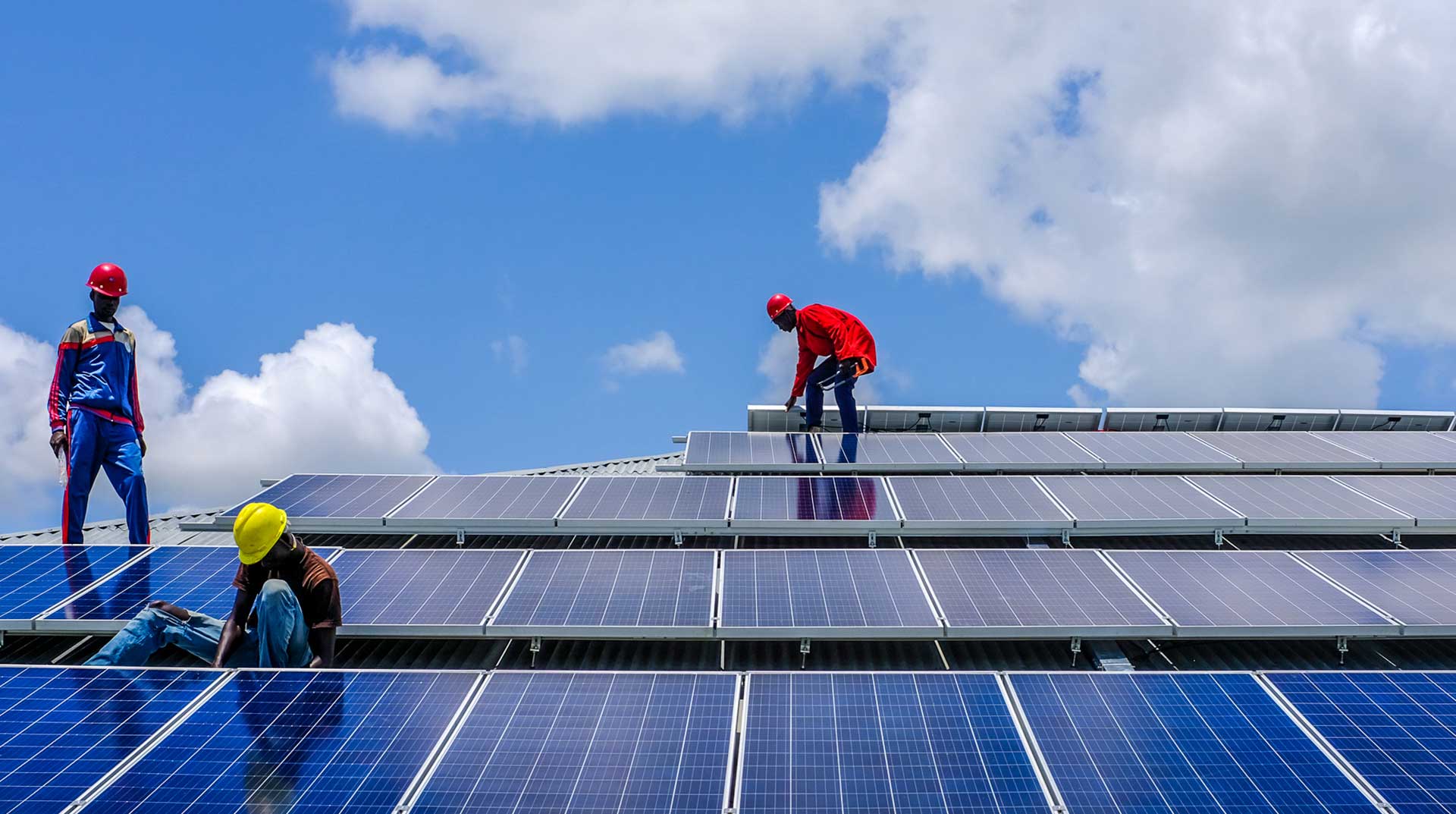
THE SDGS IN ACTION.
What are the sustainable development goals.
The Sustainable Development Goals (SDGs), also known as the Global Goals, were adopted by the United Nations in 2015 as a universal call to action to end poverty, protect the planet, and ensure that by 2030 all people enjoy peace and prosperity.
The 17 SDGs are integrated—they recognize that action in one area will affect outcomes in others, and that development must balance social, economic and environmental sustainability.
Countries have committed to prioritize progress for those who're furthest behind. The SDGs are designed to end poverty, hunger, AIDS, and discrimination against women and girls.
The creativity, knowhow, technology and financial resources from all of society is necessary to achieve the SDGs in every context.

Eradicating poverty in all its forms remains one of the greatest challenges facing humanity. While the number of people living in extreme poverty dropped by more than half between 1990 and 2015, too many are still struggling for the most basic human needs.
As of 2015, about 736 million people still lived on less than US$1.90 a day; many lack food, clean drinking water and sanitation. Rapid growth in countries such as China and India has lifted millions out of poverty, but progress has been uneven. Women are more likely to be poor than men because they have less paid work, education, and own less property.
Progress has also been limited in other regions, such as South Asia and sub-Saharan Africa, which account for 80 percent of those living in extreme poverty. New threats brought on by climate change, conflict and food insecurity, mean even more work is needed to bring people out of poverty.
The SDGs are a bold commitment to finish what we started, and end poverty in all forms and dimensions by 2030. This involves targeting the most vulnerable, increasing basic resources and services, and supporting communities affected by conflict and climate-related disasters.

736 million people still live in extreme poverty.
10 percent of the world’s population live in extreme poverty, down from 36 percent in 1990.
Some 1.3 billion people live in multidimensional poverty.
Half of all people living in poverty are under 18.
One person in every 10 is extremely poor.
Goal targets
- By 2030, reduce at least by half the proportion of men, women and children of all ages living in poverty in all its dimensions according to national definitions
- Implement nationally appropriate social protection systems and measures for all, including floors, and by 2030 achieve substantial coverage of the poor and the vulnerable
- By 2030, ensure that all men and women, in particular the poor and the vulnerable, have equal rights to economic resources, as well as access to basic services, ownership and control over land and other forms of property, inheritance, natural resources, appropriate new technology and financial services, including microfinance
- By 2030, build the resilience of the poor and those in vulnerable situations and reduce their exposure and vulnerability to climate-related extreme events and other economic, social and environmental shocks and disasters
- Ensure significant mobilization of resources from a variety of sources, including through enhanced development cooperation, in order to provide adequate and predictable means for developing countries, in particular least developed countries, to implement programmes and policies to end poverty in all its dimensions
- Create sound policy frameworks at the national, regional and international levels, based on pro-poor and gender-sensitive development strategies, to support accelerated investment in poverty eradication actions
SDGs in Action
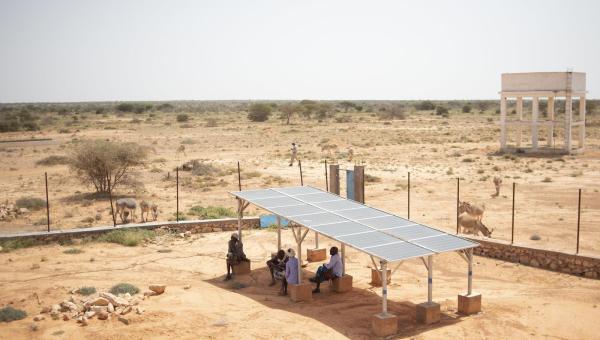
Building a new, secure climate...
Publications.
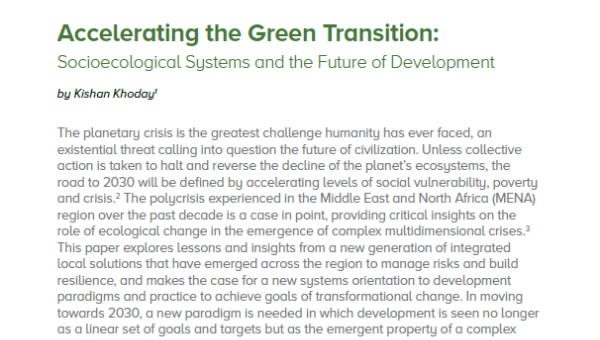
Accelerating the Green Transit...
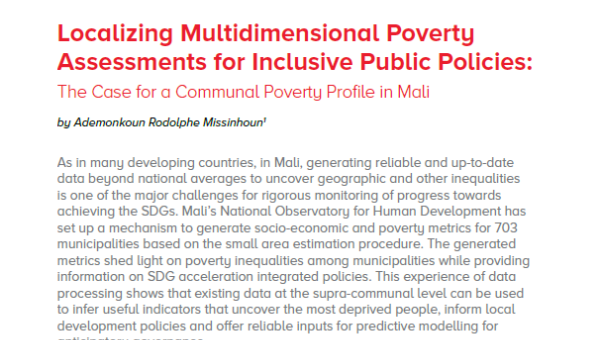
Localizing Multidimensional Po...
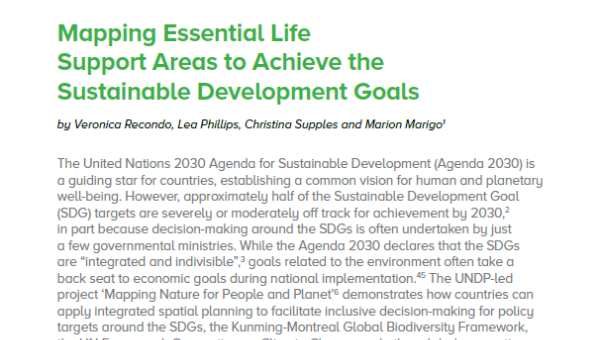
Mapping Essential Life Support...
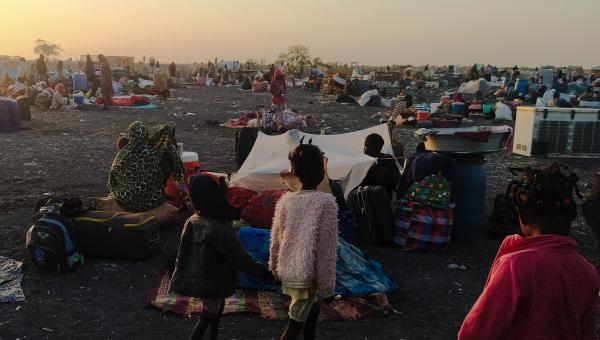
One year into war, much remain...
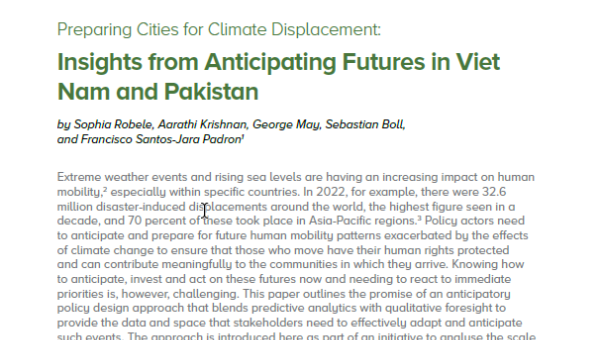
Preparing Cities for Climate D...
Zero hunger.

Zero Hunger
The number of undernourished people has dropped by almost half in the past two decades because of rapid economic growth and increased agricultural productivity. Many developing countries that used to suffer from famine and hunger can now meet their nutritional needs. Central and East Asia, Latin America and the Caribbean have all made huge progress in eradicating extreme hunger.
Unfortunately, extreme hunger and malnutrition remain a huge barrier to development in many countries. There are 821 million people estimated to be chronically undernourished as of 2017, often as a direct consequence of environmental degradation, drought and biodiversity loss. Over 90 million children under five are dangerously underweight. Undernourishment and severe food insecurity appear to be increasing in almost all regions of Africa, as well as in South America.
The SDGs aim to end all forms of hunger and malnutrition by 2030, making sure all people–especially children–have sufficient and nutritious food all year. This involves promoting sustainable agricultural, supporting small-scale farmers and equal access to land, technology and markets. It also requires international cooperation to ensure investment in infrastructure and technology to improve agricultural productivity.

The number of undernourished people reached 821 million in 2017.
In 2017 Asia accounted for nearly two thirds, 63 percent, of the world’s hungry.
Nearly 151 million children under five, 22 percent, were still stunted in 2017.
More than 1 in 8 adults is obese.
1 in 3 women of reproductive age is anemic.
26 percent of workers are employed in agriculture.
- By 2030, end all forms of malnutrition, including achieving, by 2025, the internationally agreed targets on stunting and wasting in children under 5 years of age, and address the nutritional needs of adolescent girls, pregnant and lactating women and older persons
- By 2030, double the agricultural productivity and incomes of small-scale food producers, in particular women, indigenous peoples, family farmers, pastoralists and fishers, including through secure and equal access to land, other productive resources and inputs, knowledge, financial services, markets and opportunities for value addition and non-farm employment
- By 2030, ensure sustainable food production systems and implement resilient agricultural practices that increase productivity and production, that help maintain ecosystems, that strengthen capacity for adaptation to climate change, extreme weather, drought, flooding and other disasters and that progressively improve land and soil quality
- By 2020, maintain the genetic diversity of seeds, cultivated plants and farmed and domesticated animals and their related wild species, including through soundly managed and diversified seed and plant banks at the national, regional and international levels, and promote access to and fair and equitable sharing of benefits arising from the utilization of genetic resources and associated traditional knowledge, as internationally agreed
- Increase investment, including through enhanced international cooperation, in rural infrastructure, agricultural research and extension services, technology development and plant and livestock gene banks in order to enhance agricultural productive capacity in developing countries, in particular least developed countries
- Correct and prevent trade restrictions and distortions in world agricultural markets, including through the parallel elimination of all forms of agricultural export subsidies and all export measures with equivalent effect, in accordance with the mandate of the Doha Development Round
- Adopt measures to ensure the proper functioning of food commodity markets and their derivatives and facilitate timely access to market information, including on food reserves, in order to help limit extreme food price volatility.

UNDP at the 4th International ...

UNDP at the UN ECOSOC Youth Fo...

"We felt very welcome and acce...

Recovery and hope in Myanmar's...
Good health and well-being.

We have made great progress against several leading causes of death and disease. Life expectancy has increased dramatically; infant and maternal mortality rates have declined, we’ve turned the tide on HIV and malaria deaths have halved.
Good health is essential to sustainable development and the 2030 Agenda reflects the complexity and interconnectedness of the two. It takes into account widening economic and social inequalities, rapid urbanization, threats to the climate and the environment, the continuing burden of HIV and other infectious diseases, and emerging challenges such as noncommunicable diseases. Universal health coverage will be integral to achieving SDG 3, ending poverty and reducing inequalities. Emerging global health priorities not explicitly included in the SDGs, including antimicrobial resistance, also demand action.
But the world is off-track to achieve the health-related SDGs. Progress has been uneven, both between and within countries. There’s a 31-year gap between the countries with the shortest and longest life expectancies. And while some countries have made impressive gains, national averages hide that many are being left behind. Multisectoral, rights-based and gender-sensitive approaches are essential to address inequalities and to build good health for all.

At least 400 million people have no basic healthcare, and 40 percent lack social protection.
More than 1.6 billion people live in fragile settings where protracted crises, combined with weak national capacity to deliver basic health services, present a significant challenge to global health.
By the end of 2017, 21.7 million people living with HIV were receiving antiretroviral therapy. Yet more than 15 million people are still waiting for treatment.
Every 2 seconds someone aged 30 to 70 years dies prematurely from noncommunicable diseases - cardiovascular disease, chronic respiratory disease, diabetes or cancer.
7 million people die every year from exposure to fine particles in polluted air.
More than one of every three women have experienced either physical or sexual violence at some point in their life resulting in both short- and long-term consequences for their physical, mental, and sexual and reproductive health.
- By 2030, reduce the global maternal mortality ratio to less than 70 per 100,000 live births
- By 2030, end preventable deaths of newborns and children under 5 years of age, with all countries aiming to reduce neonatal mortality to at least as low as 12 per 1,000 live births and under-5 mortality to at least as low as 25 per 1,000 live births
- By 2030, end the epidemics of AIDS, tuberculosis, malaria and neglected tropical diseases and combat hepatitis, water-borne diseases and other communicable diseases
- By 2030, reduce by one third premature mortality from non-communicable diseases through prevention and treatment and promote mental health and well-being
- Strengthen the prevention and treatment of substance abuse, including narcotic drug abuse and harmful use of alcohol
- By 2020, halve the number of global deaths and injuries from road traffic accidents
- By 2030, ensure universal access to sexual and reproductive health-care services, including for family planning, information and education, and the integration of reproductive health into national strategies and programmes
- Achieve universal health coverage, including financial risk protection, access to quality essential health-care services and access to safe, effective, quality and affordable essential medicines and vaccines for all
- By 2030, substantially reduce the number of deaths and illnesses from hazardous chemicals and air, water and soil pollution and contamination
- Strengthen the implementation of the World Health Organization Framework Convention on Tobacco Control in all countries, as appropriate
- Support the research and development of vaccines and medicines for the communicable and noncommunicable diseases that primarily affect developing countries, provide access to affordable essential medicines and vaccines, in accordance with the Doha Declaration on the TRIPS Agreement and Public Health, which affirms the right of developing countries to use to the full the provisions in the Agreement on Trade Related Aspects of Intellectual Property Rights regarding flexibilities to protect public health, and, in particular, provide access to medicines for all
- Substantially increase health financing and the recruitment, development, training and retention of the health workforce in developing countries, especially in least developed countries and small island developing States
- Strengthen the capacity of all countries, in particular developing countries, for early warning, risk reduction and management of national and global health risks
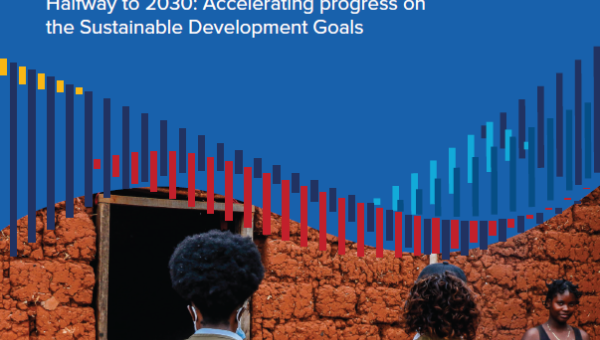
HIV and Health Annual Report 2...
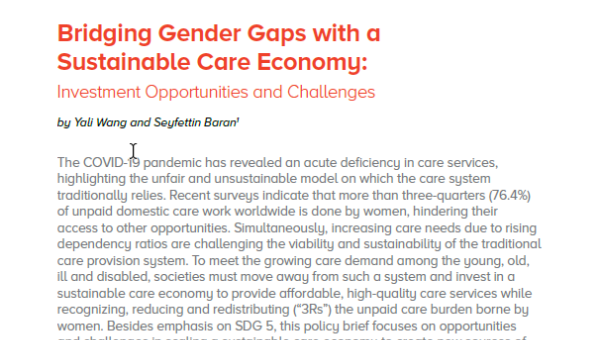
Bridging Gender Gaps with a Su...
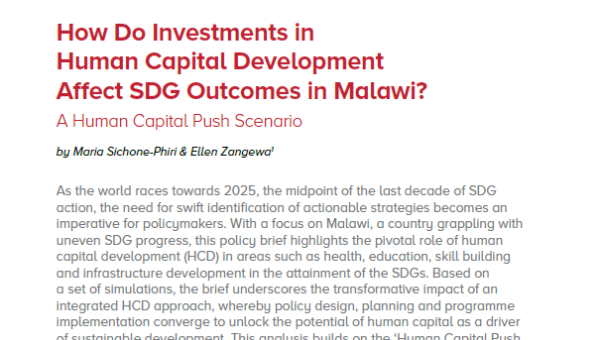
How Do Investments in Human Ca...
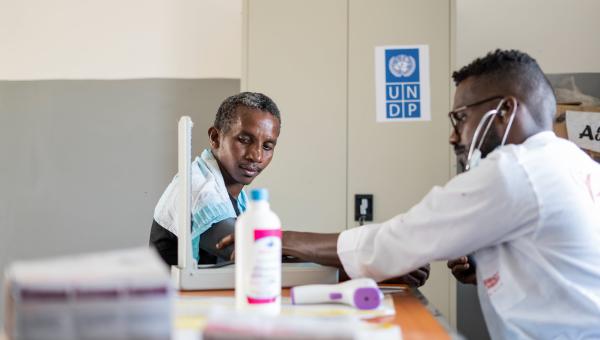
The right environment for heal...
Quality education.

Since 2000, there has been enormous progress in achieving the target of universal primary education. The total enrollment rate in developing regions reached 91 percent in 2015, and the worldwide number of children out of school has dropped by almost half. There has also been a dramatic increase in literacy rates, and many more girls are in school than ever before. These are all remarkable successes.
Progress has also been tough in some developing regions due to high levels of poverty, armed conflicts and other emergencies. In Western Asia and North Africa, ongoing armed conflict has seen an increase in the number of children out of school. This is a worrying trend. While Sub-Saharan Africa made the greatest progress in primary school enrollment among all developing regions – from 52 percent in 1990, up to 78 percent in 2012 – large disparities still remain. Children from the poorest households are up to four times more likely to be out of school than those of the richest households. Disparities between rural and urban areas also remain high.
Achieving inclusive and quality education for all reaffirms the belief that education is one of the most powerful and proven vehicles for sustainable development. This goal ensures that all girls and boys complete free primary and secondary schooling by 2030. It also aims to provide equal access to affordable vocational training, to eliminate gender and wealth disparities, and achieve universal access to a quality higher education.

Enrollment in primary education in developing countries has reached 91 percent.
Still, 57 million primary-aged children remain out of school, more than half of them in sub-Saharan Africa.
In developing countries, one in four girls is not in school.
About half of all out-of-school children of primary school age live in conflict-affected areas.
103 million youth worldwide lack basic literacy skills, and more than 60 percent of them are women.
6 out of 10 children and adolescents are not achieving a minimum level of proficiency in reading and math.
- By 2030, ensure that all girls and boys complete free, equitable and quality primary and secondary education leading to relevant and Goal-4 effective learning outcomes
- By 2030, ensure that all girls and boys have access to quality early childhood development, care and preprimary education so that they are ready for primary education
- By 2030, ensure equal access for all women and men to affordable and quality technical, vocational and tertiary education, including university
- By 2030, substantially increase the number of youth and adults who have relevant skills, including technical and vocational skills, for employment, decent jobs and entrepreneurship
- By 2030, eliminate gender disparities in education and ensure equal access to all levels of education and vocational training for the vulnerable, including persons with disabilities, indigenous peoples and children in vulnerable situations
- By 2030, ensure that all youth and a substantial proportion of adults, both men and women, achieve literacy and numeracy
- By 2030, ensure that all learners acquire the knowledge and skills needed to promote sustainable development, including, among others, through education for sustainable development and sustainable lifestyles, human rights, gender equality, promotion of a culture of peace and non-violence, global citizenship and appreciation of cultural diversity and of culture’s contribution to sustainable development
- Build and upgrade education facilities that are child, disability and gender sensitive and provide safe, nonviolent, inclusive and effective learning environments for all
- By 2020, substantially expand globally the number of scholarships available to developing countries, in particular least developed countries, small island developing States and African countries, for enrolment in higher education, including vocational training and information and communications technology, technical, engineering and scientific programmes, in developed countries and other developing countries
- By 2030, substantially increase the supply of qualified teachers, including through international cooperation for teacher training in developing countries, especially least developed countries and small island developing states

Using technology to support ne...

The future of education

A brighter future: Lillian

Three reasons climate change e...
Gender equality.

Gender Equality
Ending all discrimination against women and girls is not only a basic human right, it’s crucial for sustainable future; it’s proven that empowering women and girls helps economic growth and development.
UNDP has made gender equality central to its work and we’ve seen remarkable progress in the past 20 years. There are more girls in school now compared to 15 years ago, and most regions have reached gender parity in primary education.
But although there are more women than ever in the labour market, there are still large inequalities in some regions, with women systematically denied the same work rights as men. Sexual violence and exploitation, the unequal division of unpaid care and domestic work, and discrimination in public office all remain huge barriers. Climate change and disasters continue to have a disproportionate effect on women and children, as do conflict and migration.
It is vital to give women equal rights land and property, sexual and reproductive health, and to technology and the internet. Today there are more women in public office than ever before, but encouraging more women leaders will help achieve greater gender equality.

Women earn only 77 cents for every dollar that men get for the same work.
35 percent of women have experienced physical and/or sexual violence.
Women represent just 13 percent of agricultural landholders.
Almost 750 million women and girls alive today were married before their 18th birthday.
Two thirds of developing countries have achieved gender parity in primary education.
Only 24 percent of national parliamentarians were women as of November 2018, a small increase from 11.3 percent in 1995.
- End all forms of discrimination against all women and girls everywhere
- Eliminate all forms of violence against all women and girls in the public and private spheres, including trafficking and sexual and other types of exploitation
- Eliminate all harmful practices, such as child, early and forced marriage and female genital mutilation
- Recognize and value unpaid care and domestic work through the provision of public services, infrastructure and social protection policies and the promotion of shared responsibility within the household and the family as nationally appropriate
- Ensure women’s full and effective participation and equal opportunities for leadership at all levels of decisionmaking in political, economic and public life
- Ensure universal access to sexual and reproductive health and reproductive rights as agreed in accordance with the Programme of Action of the International Conference on Population and Development and the Beijing Platform for Action and the outcome documents of their review conferences
- Undertake reforms to give women equal rights to economic resources, as well as access to ownership and control over land and other forms of property, financial services, inheritance and natural resources, in accordance with national laws
- Enhance the use of enabling technology, in particular information and communications technology, to promote the empowerment of women
- Adopt and strengthen sound policies and enforceable legislation for the promotion of gender equality and the empowerment of all women and girls at all levels
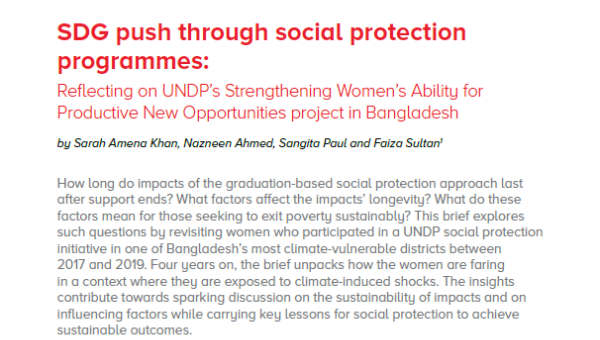
SDG Push through Social Protec...

Climate governance, adaptation...

"The work might be hard, but I...
Clean water and sanitation.

Water scarcity affects more than 40 percent of people, an alarming figure that is projected to rise as temperatures do. Although 2.1 billion people have improved water sanitation since 1990, dwindling drinking water supplies are affecting every continent.
More and more countries are experiencing water stress, and increasing drought and desertification is already worsening these trends. By 2050, it is projected that at least one in four people will suffer recurring water shortages.
Safe and affordable drinking water for all by 2030 requires we invest in adequate infrastructure, provide sanitation facilities, and encourage hygiene. Protecting and restoring water-related ecosystems is essential.
Ensuring universal safe and affordable drinking water involves reaching over 800 million people who lack basic services and improving accessibility and safety of services for over two billion.
In 2015, 4.5 billion people lacked safely managed sanitation services (with adequately disposed or treated excreta) and 2.3 billion lacked even basic sanitation.

71 percent of the global population, 5.2 billion people, had safely-managed drinking water in 2015, but 844 million people still lacked even basic drinking water.
39 percent of the global population, 2.9 billion people, had safe sanitation in 2015, but 2.3 billion people still lacked basic sanitation. 892 million people practiced open defecation.
80 percent of wastewater goes into waterways without adequate treatment.
Water stress affects more than 2 billion people, with this figure projected to increase.
80 percent of countries have laid the foundations for integrated water resources management.
The world has lost 70 percent of its natural wetlands over the last century.
- By 2030, achieve universal and equitable access to safe and affordable drinking water for all
- By 2030, achieve access to adequate and equitable sanitation and hygiene for all and end open defecation, paying special attention to the needs of women and girls and those in vulnerable situations
- By 2030, improve water quality by reducing pollution, eliminating dumping and minimizing release of hazardous chemicals and materials, halving the proportion of untreated wastewater and substantially increasing recycling and safe reuse globally
- By 2030, substantially increase water-use efficiency across all sectors and ensure sustainable withdrawals and supply of freshwater to address water scarcity and substantially reduce the number of people suffering from water scarcity
- By 2030, implement integrated water resources management at all levels, including through transboundary cooperation as appropriate
- By 2020, protect and restore water-related ecosystems, including mountains, forests, wetlands, rivers, aquifers and lakes
- By 2030, expand international cooperation and capacity-building support to developing countries in water- and sanitation-related activities and programmes, including water harvesting, desalination, water efficiency, wastewater treatment, recycling and reuse technologies
- Support and strengthen the participation of local communities in improving water and sanitation management

The challenges facing Sudan
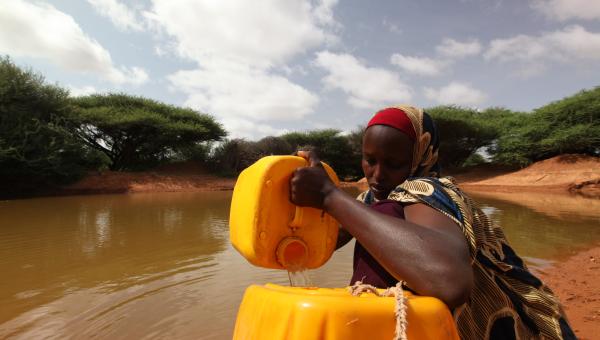
Navigating the crossroads of c...

Preserving the laboratory of e...
Affordable and clean energy.

Between 2000 and 2018, the number of people with electricity increased from 78 to 90 percent, and the numbers without electricity dipped to 789 million.
Yet as the population continues to grow, so will the demand for cheap energy, and an economy reliant on fossil fuels is creating drastic changes to our climate.
Investing in solar, wind and thermal power, improving energy productivity, and ensuring energy for all is vital if we are to achieve SDG 7 by 2030.
Expanding infrastructure and upgrading technology to provide clean and more efficient energy in all countries will encourage growth and help the environment.
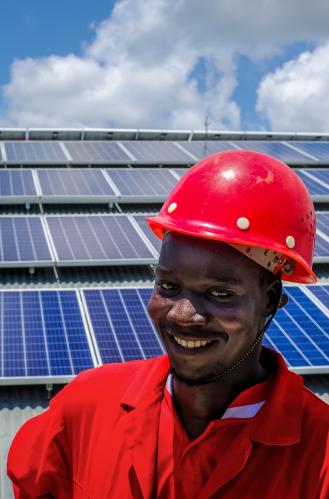
One out of 10 people still lacks electricity, and most live in rural areas of the developing world. More than half are in sub-Saharan Africa.
Energy is by far the main contributor to climate change. It accounts for 73 percent of human-caused greenhouse gases.
Energy efficiency is key; the right efficiency policies could enable the world to achieve more than 40 percent of the emissions cuts needed to reach its climate goals without new technology.
Almost a third of the world’s population—2.8 billion—rely on polluting and unhealthy fuels for cooking.
As of 2017, 17.5 percent of power was generated through renewable sources.
The renewable energy sector employed a record 11.5 million people in 2019. The changes needed in energy production and uses to achieve the Paris Agreement target of limiting the rise in temperature to below 2C can create 18 million jobs.
- By 2030, ensure universal access to affordable, reliable and modern energy services
- By 2030, increase substantially the share of renewable energy in the global energy mix
- By 2030, double the global rate of improvement in energy efficiency
- By 2030, enhance international cooperation to facilitate access to clean energy research and technology, including renewable energy, energy efficiency and advanced and cleaner fossil-fuel technology, and promote investment in energy infrastructure and clean energy technology
- By 2030, expand infrastructure and upgrade technology for supplying modern and sustainable energy services for all in developing countries, in particular least developed countries, small island developing States, and land-locked developing coun
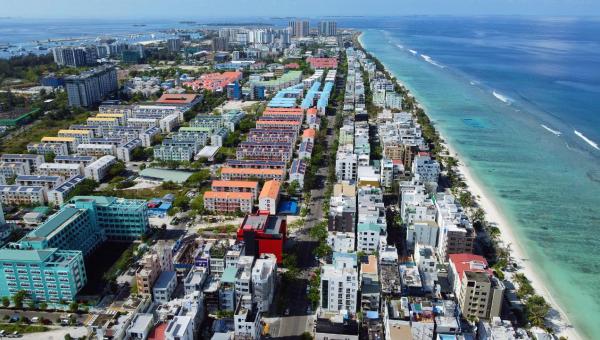
The big switch
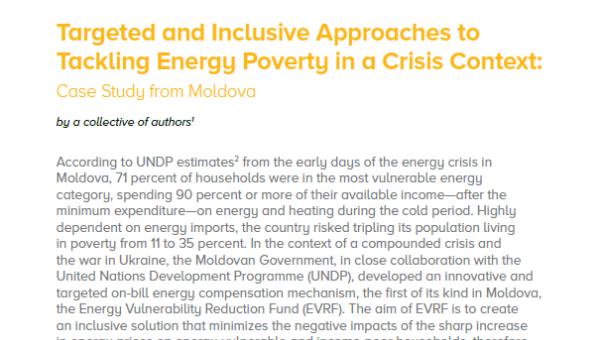
Targeted and Inclusive Approac...
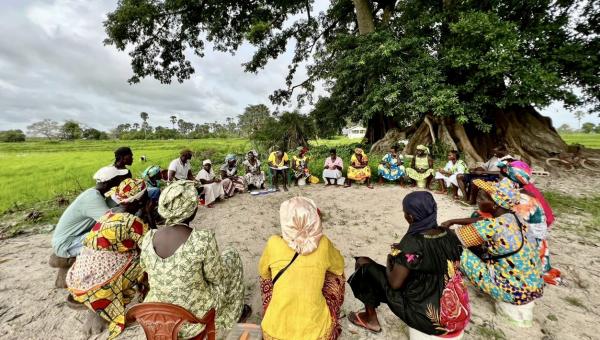
Breaking the cycle of poverty ...
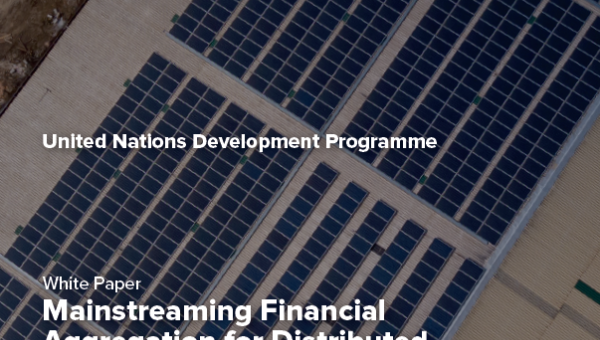
Mainstreaming Financial Aggreg...
Decent work and economic growth.

Over the past 25 years the number of workers living in extreme poverty has declined dramatically, despite the lasting impact of the 2008 economic crisis and global recession. In developing countries, the middle class now makes up more than 34 percent of total employment – a number that has almost tripled between 1991 and 2015.
However, as the global economy continues to recover we are seeing slower growth, widening inequalities, and not enough jobs to keep up with a growing labour force. According to the International Labour Organization, more than 204 million people were unemployed in 2015.
The SDGs promote sustained economic growth, higher levels of productivity and technological innovation. Encouraging entrepreneurship and job creation are key to this, as are effective measures to eradicate forced labour, slavery and human trafficking. With these targets in mind, the goal is to achieve full and productive employment, and decent work, for all women and men by 2030.

An estimated 172 million people worldwide were without work in 2018 - an unemployment rate of 5 percent.
As a result of an expanding labour force, the number of unemployed is projected to increase by 1 million every year and reach 174 million by 2020.
Some 700 million workers lived in extreme or moderate poverty in 2018, with less than US$3.20 per day.
Women’s participation in the labour force stood at 48 per cent in 2018, compared with 75 percent for men. Around 3 in 5 of the 3.5 billion people in the labour force in 2018 were men.
Overall, 2 billion workers were in informal employment in 2016, accounting for 61 per cent of the world’s workforce.
Many more women than men are underutilized in the labour force—85 million compared to 55 million.
- Sustain per capita economic growth in accordance with national circumstances and, in particular, at least 7 per cent gross domestic product growth per annum in the least developed countries
- Achieve higher levels of economic productivity through diversification, technological upgrading and innovation, including through a focus on high-value added and labour-intensive sectors
- Promote development-oriented policies that support productive activities, decent job creation, entrepreneurship, creativity and innovation, and encourage the formalization and growth of micro-, small- and medium-sized enterprises, including through access to financial services
- Improve progressively, through 2030, global resource efficiency in consumption and production and endeavour to decouple economic growth from environmental degradation, in accordance with the 10-year framework of programmes on sustainable consumption and production, with developed countries taking the lead
- By 2030, achieve full and productive employment and decent work for all women and men, including for young people and persons with disabilities, and equal pay for work of equal value
- By 2020, substantially reduce the proportion of youth not in employment, education or training
- Take immediate and effective measures to eradicate forced labour, end modern slavery and human trafficking and secure the prohibition and elimination of the worst forms of child labour, including recruitment and use of child soldiers, and by 2025 end child labour in all its forms
- Protect labour rights and promote safe and secure working environments for all workers, including migrant workers, in particular women migrants, and those in precarious employment
- By 2030, devise and implement policies to promote sustainable tourism that creates jobs and promotes local culture and products
- Strengthen the capacity of domestic financial institutions to encourage and expand access to banking, insurance and financial services for all
- Increase Aid for Trade support for developing countries, in particular least developed countries, including through the Enhanced Integrated Framework for Trade-Related Technical Assistance to Least Developed Countries
- By 2020, develop and operationalize a global strategy for youth employment and implement the Global Jobs Pact of the International Labour Organization
Industry, innovation and infrastructure

Investment in infrastructure and innovation are crucial drivers of economic growth and development. With over half the world population now living in cities, mass transport and renewable energy are becoming ever more important, as are the growth of new industries and information and communication technologies.
Technological progress is also key to finding lasting solutions to both economic and environmental challenges, such as providing new jobs and promoting energy efficiency. Promoting sustainable industries, and investing in scientific research and innovation, are all important ways to facilitate sustainable development.
More than 4 billion people still do not have access to the Internet, and 90 percent are from the developing world. Bridging this digital divide is crucial to ensure equal access to information and knowledge, as well as foster innovation and entrepreneurship.

Worldwide, 2.3 billion people lack access to basic sanitation.
In some low-income African countries, infrastructure constraints cut businesses’ productivity by around 40 percent.
2.6 billion people in developing countries do not have access to constant electricity.
More than 4 billion people still do not have access to the Internet; 90 percent of them are in the developing world.
The renewable energy sectors currently employ more than 2.3 million people; the number could reach 20 million by 2030.
In developing countries, barely 30 percent of agricultural products undergo industrial processing, compared to 98 percent high-income countries.
- Develop quality, reliable, sustainable and resilient infrastructure, including regional and transborder infrastructure, to support economic development and human well-being, with a focus on affordable and equitable access for all
- Promote inclusive and sustainable industrialization and, by 2030, significantly raise industry’s share of employment and gross domestic product, in line with national circumstances, and double its share in least developed countries
- Increase the access of small-scale industrial and other enterprises, in particular in developing countries, to financial services, including affordable credit, and their integration into value chains and markets
- By 2030, upgrade infrastructure and retrofit industries to make them sustainable, with increased resource-use efficiency and greater adoption of clean and environmentally sound technologies and industrial processes, with all countries taking action in accordance with their respective capabilities
- Enhance scientific research, upgrade the technological capabilities of industrial sectors in all countries, in particular developing countries, including, by 2030, encouraging innovation and substantially increasing the number of research and development workers per 1 million people and public and private research and development spending
- Facilitate sustainable and resilient infrastructure development in developing countries through enhanced financial, technological and technical support to African countries, least developed countries, landlocked developing countries and small island developing States 18
- Support domestic technology development, research and innovation in developing countries, including by ensuring a conducive policy environment for, inter alia, industrial diversification and value addition to commodities
- Significantly increase access to information and communications technology and strive to provide universal and affordable access to the Internet in least developed countries by 2020

How Digital is Transforming th...

Popping the bottle
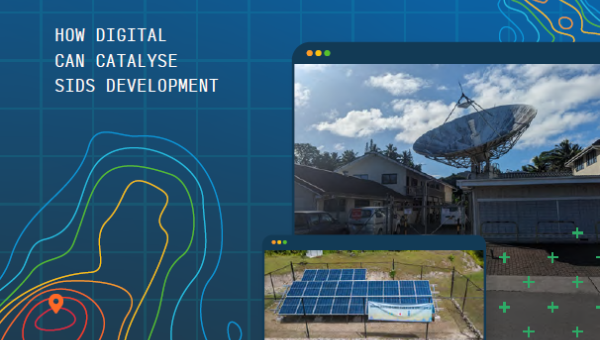
Small Island Digital States: H...

Harnessing technology for posi...
Reduced inequalities.

Income inequality is on the rise—the richest 10 percent have up to 40 percent of global income whereas the poorest 10 percent earn only between 2 to 7 percent. If we take into account population growth inequality in developing countries, inequality has increased by 11 percent.
Income inequality has increased in nearly everywhere in recent decades, but at different speeds. It’s lowest in Europe and highest in the Middle East.
These widening disparities require sound policies to empower lower income earners, and promote economic inclusion of all regardless of sex, race or ethnicity.
Income inequality requires global solutions. This involves improving the regulation and monitoring of financial markets and institutions, encouraging development assistance and foreign direct investment to regions where the need is greatest. Facilitating the safe migration and mobility of people is also key to bridging the widening divide.

In 2016, 22 percent of global income was received by the top 1 percent compared with 10 percent of income for the bottom 50 percent.
In 1980, the top one percent had 16 percent of global income. The bottom 50 percent had 8 percent of income.
Economic inequality is largely driven by the unequal ownership of capital. Since 1980, very large transfers of public to private wealth occurred in nearly all countries. The global wealth share of the top 1 percent was 33 percent in 2016.
Under "business as usual", the top 1 percent global wealth will reach 39 percent by 2050.
Women spend, on average, twice as much time on unpaid housework as men.
Women have as much access to financial services as men in just 60 percent of the countries assessed and to land ownership in just 42 percent of the countries assessed.
- By 2030, progressively achieve and sustain income growth of the bottom 40 per cent of the population at a rate higher than the national average
- By 2030, empower and promote the social, economic and political inclusion of all, irrespective of age, sex, disability, race, ethnicity, origin, religion or economic or other status
- Ensure equal opportunity and reduce inequalities of outcome, including by eliminating discriminatory laws, policies and practices and promoting appropriate legislation, policies and action in this regard
- Adopt policies, especially fiscal, wage and social protection policies, and progressively achieve greater equality
- Improve the regulation and monitoring of global financial markets and institutions and strengthen the implementation of such regulations
- Ensure enhanced representation and voice for developing countries in decision-making in global international economic and financial institutions in order to deliver more effective, credible, accountable and legitimate institutions
- Facilitate orderly, safe, regular and responsible migration and mobility of people, including through the implementation of planned and well-managed migration policies
- Implement the principle of special and differential treatment for developing countries, in particular least developed countries, in accordance with World Trade Organization agreements
- Encourage official development assistance and financial flows, including foreign direct investment, to States where the need is greatest, in particular least developed countries, African countries, small island developing States and landlocked developing countries, in accordance with their national plans and programmes
- By 2030, reduce to less than 3 per cent the transaction costs of migrant remittances and eliminate remittance corridors with costs higher than 5 per cent
Sustainable cities and communities

More than half of us live in cities. By 2050, two-thirds of all humanity—6.5 billion people—will be urban. Sustainable development cannot be achieved without significantly transforming the way we build and manage our urban spaces.
The rapid growth of cities—a result of rising populations and increasing migration—has led to a boom in mega-cities, especially in the developing world, and slums are becoming a more significant feature of urban life.
Making cities sustainable means creating career and business opportunities, safe and affordable housing, and building resilient societies and economies. It involves investment in public transport, creating green public spaces, and improving urban planning and management in participatory and inclusive ways.

In 2018, 4.2 billion people, 55 percent of the world’s population, lived in cities. By 2050, the urban population is expected to reach 6.5 billion.
Cities occupy just 3 percent of the Earth’s land but account for 60 to 80 percent of energy consumption and at least 70 percent of carbon emissions.
828 million people are estimated to live in slums, and the number is rising.
In 1990, there were 10 cities with 10 million people or more; by 2014, the number of mega-cities rose to 28, and was expected to reach 33 by 2018. In the future, 9 out of 10 mega-cities will be in the developing world.
In the coming decades, 90 percent of urban expansion will be in the developing world.
The economic role of cities is significant. They generate about 80 percent of the global GDP.
- By 2030, ensure access for all to adequate, safe and affordable housing and basic services and upgrade slums
- By 2030, provide access to safe, affordable, accessible and sustainable transport systems for all, improving road safety, notably by expanding public transport, with special attention to the needs of those in vulnerable situations, women, children, persons with disabilities and older persons
- By 2030, enhance inclusive and sustainable urbanization and capacity for participatory, integrated and sustainable human settlement planning and management in all countries
- Strengthen efforts to protect and safeguard the world’s cultural and natural heritage
- By 2030, significantly reduce the number of deaths and the number of people affected and substantially decrease the direct economic losses relative to global gross domestic product caused by disasters, including water-related disasters, with a focus on protecting the poor and people in vulnerable situations
- By 2030, reduce the adverse per capita environmental impact of cities, including by paying special attention to air quality and municipal and other waste management
- By 2030, provide universal access to safe, inclusive and accessible, green and public spaces, in particular for women and children, older persons and persons with disabilities
- Support positive economic, social and environmental links between urban, peri-urban and rural areas by strengthening national and regional development planning
- By 2020, substantially increase the number of cities and human settlements adopting and implementing integrated policies and plans towards inclusion, resource efficiency, mitigation and adaptation to climate change, resilience to disasters, and develop and implement, in line with the Sendai Framework for Disaster Risk Reduction 2015-2030, holistic disaster risk management at all levels
- Support least developed countries, including through financial and technical assistance, in building sustainable and resilient buildings utilizing local materials
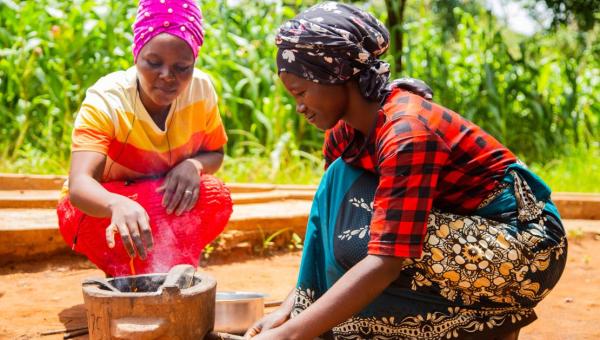
Unlocking barriers to a sustai...
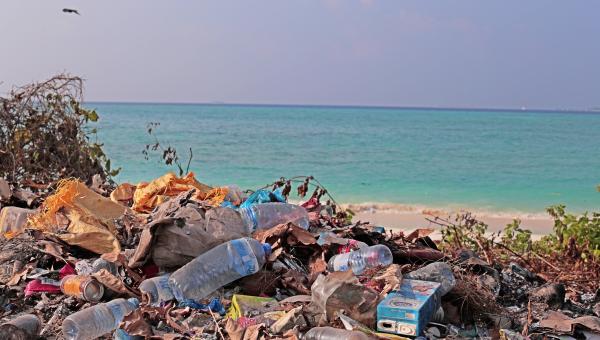
The beginning of the end for p...
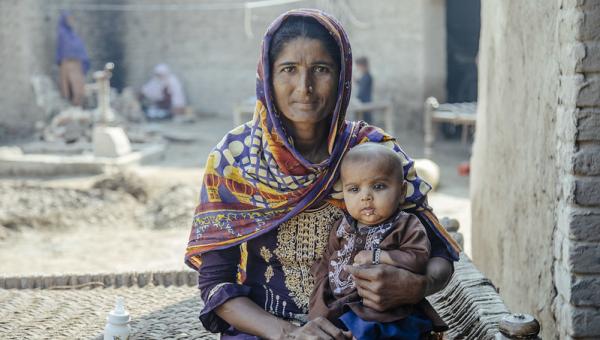
"I want my old life back."
Responsible consumption and production.

Achieving economic growth and sustainable development requires that we urgently reduce our ecological footprint by changing the way we produce and consume goods and resources. Agriculture is the biggest user of water worldwide, and irrigation now claims close to 70 percent of all freshwater for human use.
The efficient management of our shared natural resources, and the way we dispose of toxic waste and pollutants, are important targets to achieve this goal. Encouraging industries, businesses and consumers to recycle and reduce waste is equally important, as is supporting developing countries to move towards more sustainable patterns of consumption by 2030.
A large share of the world population is still consuming far too little to meet even their basic needs. Halving the per capita of global food waste at the retailer and consumer levels is also important for creating more efficient production and supply chains. This can help with food security, and shift us towards a more resource efficient economy.
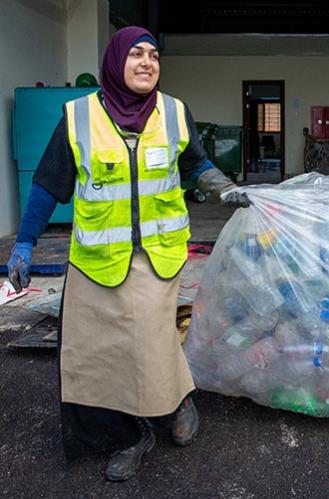
1.3 billion tonnes of food is wasted every year, while almost 2 billion people go hungry or undernourished.
The food sector accounts for around 22 percent of total greenhouse gas emissions, largely from the conversion of forests into farmland.
Globally, 2 billion people are overweight or obese.
Only 3 percent of the world’s water is fresh (drinkable), and humans are using it faster than nature can replenish it.
If people everywhere switched to energy efficient lightbulbs, the world would save US$120 billion annually.
One-fifth of the world’s final energy consumption in 2013 was from renewable sources.
- Implement the 10-year framework of programmes on sustainable consumption and production, all countries taking action, with developed countries taking the lead, taking into account the development and capabilities of developing countries
- By 2030, achieve the sustainable management and efficient use of natural resources
- By 2030, halve per capita global food waste at the retail and consumer levels and reduce food losses along production and supply chains, including post-harvest losses
- By 2020, achieve the environmentally sound management of chemicals and all wastes throughout their life cycle, in accordance with agreed international frameworks, and significantly reduce their release to air, water and soil in order to minimize their adverse impacts on human health and the environment
- By 2030, substantially reduce waste generation through prevention, reduction, recycling and reuse
- Encourage companies, especially large and transnational companies, to adopt sustainable practices and to integrate sustainability information into their reporting cycle
- Promote public procurement practices that are sustainable, in accordance with national policies and priorities
- By 2030, ensure that people everywhere have the relevant information and awareness for sustainable development and lifestyles in harmony with nature
- Support developing countries to strengthen their scientific and technological capacity to move towards more sustainable patterns of consumption and production
- Develop and implement tools to monitor sustainable development impacts for sustainable tourism that creates jobs and promotes local culture and products
- Rationalize inefficient fossil-fuel subsidies that encourage wasteful consumption by removing market distortions, in accordance with national circumstances, including by restructuring taxation and phasing out those harmful subsidies, where they exist, to reflect their environmental impacts, taking fully into account the specific needs and conditions of developing countries and minimizing the possible adverse impacts on their development in a manner that protects the poor and the affected communities
Generic web page
Popping the bottle.
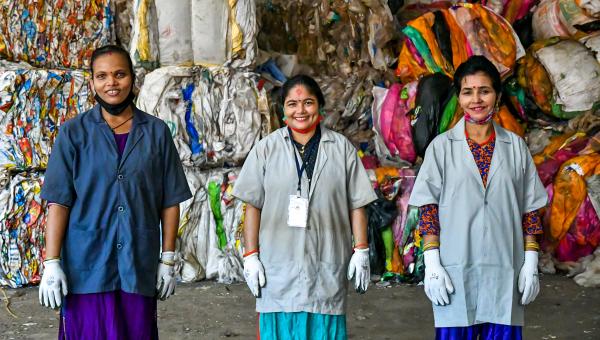
Unsung heroes: Four things pol...
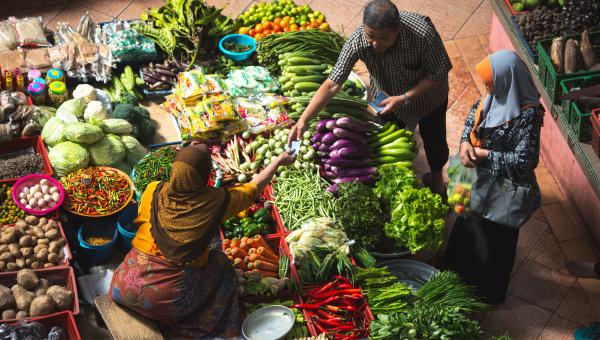
10 ways forward to transform f...
Climate action.

There is no country that is not experiencing the drastic effects of climate change. Greenhouse gas emissions are more than 50 percent higher than in 1990. Global warming is causing long-lasting changes to our climate system, which threatens irreversible consequences if we do not act.
The annual average economic losses from climate-related disasters are in the hundreds of billions of dollars. This is not to mention the human impact of geo-physical disasters, which are 91 percent climate-related, and which between 1998 and 2017 killed 1.3 million people, and left 4.4 billion injured. The goal aims to mobilize US$100 billion annually by 2020 to address the needs of developing countries to both adapt to climate change and invest in low-carbon development.
Supporting vulnerable regions will directly contribute not only to Goal 13 but also to the other SDGs. These actions must also go hand in hand with efforts to integrate disaster risk measures, sustainable natural resource management, and human security into national development strategies. It is still possible, with strong political will, increased investment, and using existing technology, to limit the increase in global mean temperature to two degrees Celsius above pre-industrial levels, aiming at 1.5 ° C, but this requires urgent and ambitious collective action.
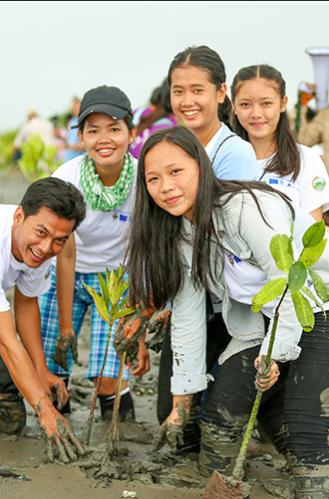
As of 2017 humans are estimated to have caused approximately 1.0°C of global warming above pre-industrial levels.
Sea levels have risen by about 20 cm (8 inches) since 1880 and are projected to rise another 30–122 cm (1 to 4 feet) by 2100.
To limit warming to 1.5C, global net CO2 emissions must drop by 45% between 2010 and 2030, and reach net zero around 2050.
Climate pledges under The Paris Agreement cover only one third of the emissions reductions needed to keep the world below 2°C.
Bold climate action could trigger at least US$26 trillion in economic benefits by 2030.
The energy sector alone will create around 18 million more jobs by 2030, focused specifically on sustainable energy.
- Strengthen resilience and adaptive capacity to climate-related hazards and natural disasters in all countries
- Integrate climate change measures into national policies, strategies and planning
- Improve education, awareness-raising and human and institutional capacity on climate change mitigation, adaptation, impact reduction and early warning
- Implement the commitment undertaken by developed-country parties to the United Nations Framework Convention on Climate Change to a goal of mobilizing jointly $100 billion annually by 2020 from all sources to address the needs of developing countries in the context of meaningful mitigation actions and transparency on implementation and fully operationalize the Green Climate Fund through its capitalization as soon as possible
- Promote mechanisms for raising capacity for effective climate change-related planning and management in least developed countries and small island developing States, including focusing on women, youth and local and marginalized communities
Life Below Water

The world’s oceans – their temperature, chemistry, currents and life – drive global systems that make the Earth habitable for humankind. How we manage this vital resource is essential for humanity as a whole, and to counterbalance the effects of climate change.
Over three billion people depend on marine and coastal biodiversity for their livelihoods. However, today we are seeing 30 percent of the world’s fish stocks overexploited, reaching below the level at which they can produce sustainable yields.
Oceans also absorb about 30 percent of the carbon dioxide produced by humans, and we are seeing a 26 percent rise in ocean acidification since the beginning of the industrial revolution. Marine pollution, an overwhelming majority of which comes from land-based sources, is reaching alarming levels, with an average of 13,000 pieces of plastic litter to be found on every square kilometre of ocean.
The SDGs aim to sustainably manage and protect marine and coastal ecosystems from pollution, as well as address the impacts of ocean acidification. Enhancing conservation and the sustainable use of ocean-based resources through international law will also help mitigate some of the challenges facing our oceans.

The ocean covers three quarters of the Earth’s surface and represents 99 percent of the living space on the planet by volume.
The ocean contains nearly 200,000 identified species, but actual numbers may lie in the millions.
As much as 40 percent of the ocean is heavily affected by pollution, depleted fisheries, loss of coastal habitats and other human activities.
The ocean absorbs about 30 percent of carbon dioxide produced by humans, buffering the impacts of global warming.
More than 3 billion people depend on marine and coastal biodiversity for their livelihoods.
The market value of marine and coastal resources and industries is estimated at US$3 trillion per year, about 5 percent of global GDP.
- By 2025, prevent and significantly reduce marine pollution of all kinds, in particular from land-based activities, including marine debris and nutrient pollution
- By 2020, sustainably manage and protect marine and coastal ecosystems to avoid significant adverse impacts, including by strengthening their resilience, and take action for their restoration in order to achieve healthy and productive oceans
- Minimize and address the impacts of ocean acidification, including through enhanced scientific cooperation at all levels
- By 2020, effectively regulate harvesting and end overfishing, illegal, unreported and unregulated fishing and destructive fishing practices and implement science-based management plans, in order to restore fish stocks in the shortest time feasible, at least to levels that can produce maximum sustainable yield as determined by their biological characteristics
- By 2020, conserve at least 10 per cent of coastal and marine areas, consistent with national and international law and based on the best available scientific information
- By 2020, prohibit certain forms of fisheries subsidies which contribute to overcapacity and overfishing, eliminate subsidies that contribute to illegal, unreported and unregulated fishing and refrain from introducing new such subsidies, recognizing that appropriate and effective special and differential treatment for developing and least developed countries should be an integral part of the World Trade Organization fisheries subsidies negotiation
- By 2030, increase the economic benefits to Small Island developing States and least developed countries from the sustainable use of marine resources, including through sustainable management of fisheries, aquaculture and tourism
- Increase scientific knowledge, develop research capacity and transfer marine technology, taking into account the Intergovernmental Oceanographic Commission Criteria and Guidelines on the Transfer of Marine Technology, in order to improve ocean health and to enhance the contribution of marine biodiversity to the development of developing countries, in particular small island developing States and least developed countries
- Provide access for small-scale artisanal fishers to marine resources and markets
- Enhance the conservation and sustainable use of oceans and their resources by implementing international law as reflected in UNCLOS, which provides the legal framework for the conservation and sustainable use of oceans and their resources, as recalled in paragraph 158 of The Future We Want

Investing in SIDS and LLDCs is...
Small island developing states and pathways t..., life on land.

Human life depends on the earth as much as the ocean for our sustenance and livelihoods. Plant life provides 80 percent of the human diet, and we rely on agriculture as an important economic resources. Forests cover 30 percent of the Earth’s surface, provide vital habitats for millions of species, and important sources for clean air and water, as well as being crucial for combating climate change.
Every year, 13 million hectares of forests are lost, while the persistent degradation of drylands has led to the desertification of 3.6 billion hectares, disproportionately affecting poor communities.
While 15 percent of land is protected, biodiversity is still at risk. Nearly 7,000 species of animals and plants have been illegally traded. Wildlife trafficking not only erodes biodiversity, but creates insecurity, fuels conflict, and feeds corruption.
Urgent action must be taken to reduce the loss of natural habitats and biodiversity which are part of our common heritage and support global food and water security, climate change mitigation and adaptation, and peace and security.

Around 1.6 billion people depend on forests for their livelihoods.
Forests are home to more than 80 percent of all terrestrial species of animals, plants and insects.
2.6 billion people depend directly on agriculture for a living.
Nature-based climate solutions can contribute about a third of CO2 reductions by 2030.
The value of ecosystems to human livelihoods and well-being is $US125 trillion per year.v
Mountain regions provide 60-80 percent of the Earth's fresh water.
- By 2020, ensure the conservation, restoration and sustainable use of terrestrial and inland freshwater ecosystems and their services, in particular forests, wetlands, mountains and drylands, in line with obligations under international agreements
- By 2020, promote the implementation of sustainable management of all types of forests, halt deforestation, restore degraded forests and substantially increase afforestation and reforestation globally
- By 2030, combat desertification, restore degraded land and soil, including land affected by desertification, drought and floods, and strive to achieve a land degradation-neutral world
- By 2030, ensure the conservation of mountain ecosystems, including their biodiversity, in order to enhance their capacity to provide benefits that are essential for sustainable development
- Take urgent and significant action to reduce the degradation of natural habitats, halt the loss of biodiversity and, by 2020, protect and prevent the extinction of threatened species
- Promote fair and equitable sharing of the benefits arising from the utilization of genetic resources and promote appropriate access to such resources, as internationally agreed
- Take urgent action to end poaching and trafficking of protected species of flora and fauna and address both demand and supply of illegal wildlife products
- By 2020, introduce measures to prevent the introduction and significantly reduce the impact of invasive alien species on land and water ecosystems and control or eradicate the priority species
- By 2020, integrate ecosystem and biodiversity values into national and local planning, development processes, poverty reduction strategies and accounts
- Mobilize and significantly increase financial resources from all sources to conserve and sustainably use biodiversity and ecosystems
- Mobilize significant resources from all sources and at all levels to finance sustainable forest management and provide adequate incentives to developing countries to advance such management, including for conservation and reforestation
- Enhance global support for efforts to combat poaching and trafficking of protected species, including by increasing the capacity of local communities to pursue sustainable livelihood opportunities

Over the hump
Peace, justice and strong institutions.

We cannot hope for sustainable development without peace, stability, human rights and effective governance, based on the rule of law. Yet our world is increasingly divided. Some regions enjoy peace, security and prosperity, while others fall into seemingly endless cycles of conflict and violence. This is not inevitable and must be addressed.
Armed violence and insecurity have a destructive impact on a country’s development, affecting economic growth, and often resulting in grievances that last for generations. Sexual violence, crime, exploitation and torture are also prevalent where there is conflict, or no rule of law, and countries must take measures to protect those who are most at risk
The SDGs aim to significantly reduce all forms of violence, and work with governments and communities to end conflict and insecurity. Promoting the rule of law and human rights are key to this process, as is reducing the flow of illicit arms and strengthening the participation of developing countries in the institutions of global governance.
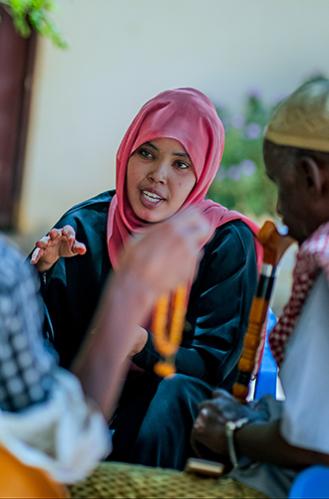
By the end of 2017, 68.5 million people had been forcibly displaced as a result of persecution, conflict, violence or human rights violations.
There are at least 10 million stateless people who have been denied nationality and its related rights.
Corruption, bribery, theft and tax evasion cost developing countries US$1.26 trillion per year.
49 countries lack laws protecting women from domestic violence.
In 46 countries, women now hold more than 30 percent of seats in at least one chamber of national parliament.
1 billion people are legally ‘invisible’ because they cannot prove who they are. This includes an estimated 625 million children under 14 whose births were never registered.
- Significantly reduce all forms of violence and related death rates everywhere
- End abuse, exploitation, trafficking and all forms of violence against and torture of children
- Promote the rule of law at the national and international levels and ensure equal access to justice for all
- By 2030, significantly reduce illicit financial and arms flows, strengthen the recovery and return of stolen assets and combat all forms of organized crime
- Substantially reduce corruption and bribery in all their forms
- Develop effective, accountable and transparent institutions at all levels
- Ensure responsive, inclusive, participatory and representative decision-making at all levels
- Broaden and strengthen the participation of developing countries in the institutions of global governance
- By 2030, provide legal identity for all, including birth registration
- Ensure public access to information and protect fundamental freedoms, in accordance with national legislation and international agreements
- Strengthen relevant national institutions, including through international cooperation, for building capacity at all levels, in particular in developing countries, to prevent violence and combat terrorism and crime
- Promote and enforce non-discriminatory laws and policies for sustainable development
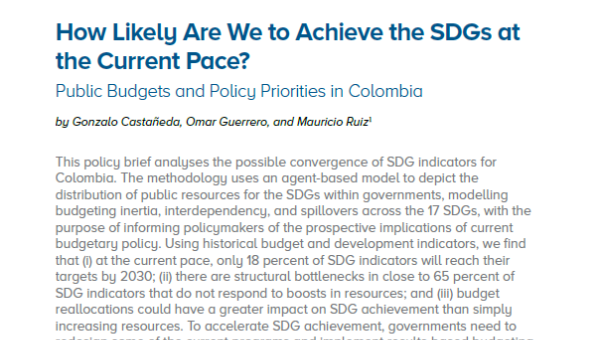
How Likely Are We to Achieve t...
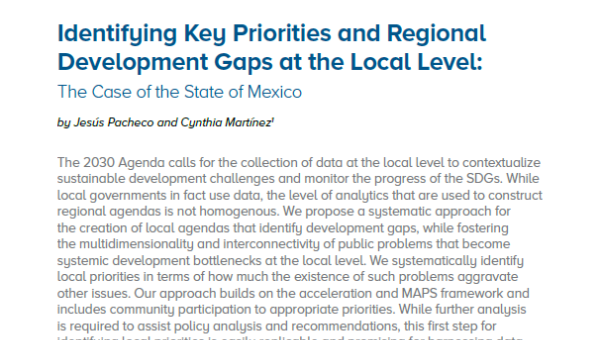
Identifying Key Priorities and...
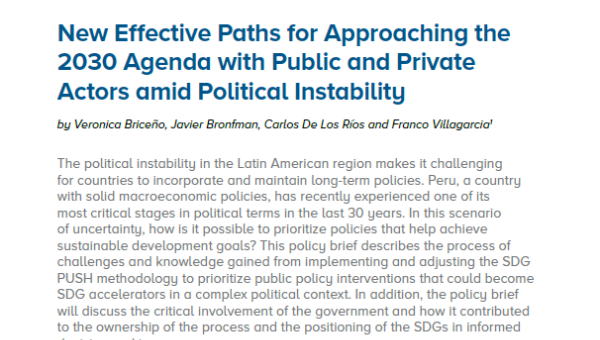
New Effective Paths for Approa...
Partnerships for the goals.

The SDGs can only be realized with strong global partnerships and cooperation. Official Development Assistance remained steady but below target, at US$147 billion in 2017. While humanitarian crises brought on by conflict or natural disasters continue to demand more financial resources and aid. Many countries also require Official Development Assistance to encourage growth and trade.
The world is more interconnected than ever. Improving access to technology and knowledge is an important way to share ideas and foster innovation. Coordinating policies to help developing countries manage their debt, as well as promoting investment for the least developed, is vital for sustainable growth and development.
The goals aim to enhance North-South and South-South cooperation by supporting national plans to achieve all the targets. Promoting international trade, and helping developing countries increase their exports is all part of achieving a universal rules-based and equitable trading system that is fair and open and benefits all.

The UN Conference on Trade and Development (UNCTAD) says achieving SDGs will require US$5 trillion to $7 trillion in annual investment.
Total official development assistance reached US$147.2 billion in 2017.
In 2017, international remittances totaled US$613 billion; 76 percent of it went to developing countries.
In 2016, 6 countries met the international target to keep official development assistance at or above 0.7 percent of gross national income.
Sustainable and responsible investments represent high-potential sources of capital for SDGs. As of 2016, US$18.2 trillion was invested in this asset class.
The bond market for sustainable business is growing. In 2018 global green bonds reached US$155.5billion, up 78 percent from previous year.
- Strengthen domestic resource mobilization, including through international support to developing countries, to improve domestic capacity for tax and other revenue collection
- Developed countries to implement fully their official development assistance commitments, including the commitment by many developed countries to achieve the target of 0.7 per cent of ODA/GNI to developing countries and 0.15 to 0.20 per cent of ODA/GNI to least developed countries ODA providers are encouraged to consider setting a target to provide at least 0.20 per cent of ODA/GNI to least developed countries
- Mobilize additional financial resources for developing countries from multiple sources
- Assist developing countries in attaining long-term debt sustainability through coordinated policies aimed at fostering debt financing, debt relief and debt restructuring, as appropriate, and address the external debt of highly indebted poor countries to reduce debt distress
- Adopt and implement investment promotion regimes for least developed countries
- Enhance North-South, South-South and triangular regional and international cooperation on and access to science, technology and innovation and enhance knowledge sharing on mutually agreed terms, including through improved coordination among existing mechanisms, in particular at the United Nations level, and through a global technology facilitation mechanism
- Promote the development, transfer, dissemination and diffusion of environmentally sound technologies to developing countries on favourable terms, including on concessional and preferential terms, as mutually agreed
- Fully operationalize the technology bank and science, technology and innovation capacity-building mechanism for least developed countries by 2017 and enhance the use of enabling technology, in particular information and communications technology
Capacity building
- Enhance international support for implementing effective and targeted capacity-building in developing countries to support national plans to implement all the sustainable development goals, including through North-South, South-South and triangular cooperation
- Promote a universal, rules-based, open, non-discriminatory and equitable multilateral trading system under the World Trade Organization, including through the conclusion of negotiations under its Doha Development Agenda
- Significantly increase the exports of developing countries, in particular with a view to doubling the least developed countries’ share of global exports by 2020
- Realize timely implementation of duty-free and quota-free market access on a lasting basis for all least developed countries, consistent with World Trade Organization decisions, including by ensuring that preferential rules of origin applicable to imports from least developed countries are transparent and simple, and contribute to facilitating market access
Systemic issues
Policy and institutional coherence
- Enhance global macroeconomic stability, including through policy coordination and policy coherence
- Enhance policy coherence for sustainable development
- Respect each country’s policy space and leadership to establish and implement policies for poverty eradication and sustainable development
Multi-stakeholder partnerships
- Enhance the global partnership for sustainable development, complemented by multi-stakeholder partnerships that mobilize and share knowledge, expertise, technology and financial resources, to support the achievement of the sustainable development goals in all countries, in particular developing countries
- Encourage and promote effective public, public-private and civil society partnerships, building on the experience and resourcing strategies of partnerships
Data, monitoring and accountability
- By 2020, enhance capacity-building support to developing countries, including for least developed countries and small island developing States, to increase significantly the availability of high-quality, timely and reliable data disaggregated by income, gender, age, race, ethnicity, migratory status, disability, geographic location and other characteristics relevant in national contexts
- By 2030, build on existing initiatives to develop measurements of progress on sustainable development that complement gross domestic product, and support statistical capacity-building in developing countries
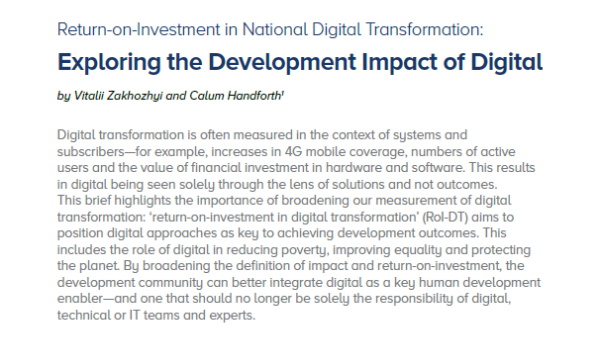
Return-on-Investment in Nation...
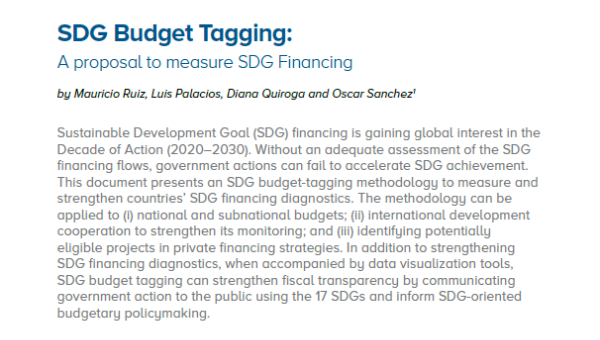
SDG Budget Tagging: A proposal...

Sustainable Development Goals Integration

Explainer: Sustainable Development Goal 5
- Share to Facebook
- Share to Twitter
- Share to LinkedIn
- Share to E-mail
In 2015, recognizing the global nature of challenges like poverty, inequality and climate change, UN Member states universally adopted the 2030 Sustainable Development Agenda . Resolving to meet these matters head on, the international community set forth an ambitious vision for the future.
The Agenda encompasses three core elements: economic growth, social inclusion and environmental protection. Together, these interconnected principles form the basis of the 17 Sustainable Development Goals (SDGs), which provide a blueprint for progress across all areas of life.
Gender is woven throughout the SDGs as it sits at the intersection of economic, social and environmental issues. It has its own Goal, SDG 5—with the ambition of achieving gender equality and empowering all women and girls—and is mentioned explicitly in 10 of the other Goals.
Each SDG contains specific objectives that can be measured and tracked over time. Like a global checklist, these objectives allow us to check our progress as we approach the 2030 deadline. There are nine objectives within SDG 5, which UN Women and UNDESA take annual stock of in our Gender Snapshot report .
Learn more about these nine objectives, and find out how near—or far—we are from reaching them in 2022.
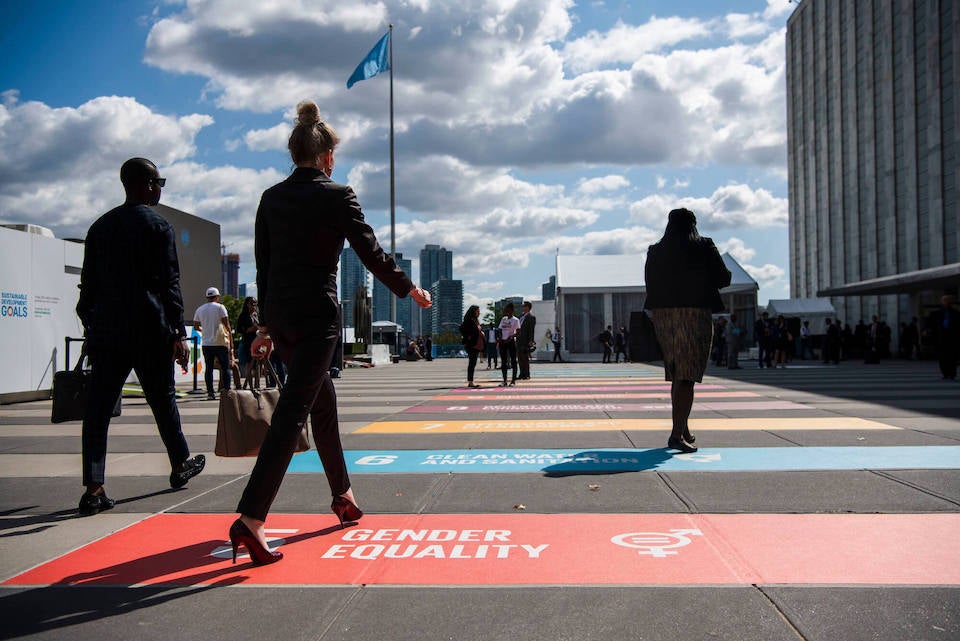
End discrimination
Gender-based discrimination has long kept women and girls subordinate to men in the workplace, in politics and at home. In some countries such discrimination persists in the law—legally barring women, for example, from certain professions—while in others economic barriers like the gender pay gap prevent women from experiencing full equality. Ending gender-based discrimination will require laws and frameworks that promote, enforce and monitor gender equality across all areas of life .
This means equal access to employment and economic benefits, including both laws against workplace discrimination and systems in place to address violations. It means laws on violence against women—legislation specifically addressing sexual harassment, for example, or criminalizing rape within marriage. It encompasses equal rights and protections within marriage and the family, such as the right to initiate a divorce or be recognized as head of household, as well as dedicated family courts to protect such rights. And it includes equality in overarching legal frameworks like constitutions, as well as the equal right to run for and hold public office.
Though there has been notable progress in this area, the pace of legal reform is far too slow. At current rates of change, the report estimates we are 21 years from universal laws banning violence against women and a whopping 286 years from gender equality in legal frameworks.
End violence
Violence against women and girls, already a pervasive problem before 2020, surged in the wake of COVID-19. Many women report feeling more unsafe since the start of the pandemic: nearly 7 in 10 women (68 per cent) say that verbal or physical abuse by a partner has become more common, and 1 in 4 women describes more frequent household conflicts.
Over the past year, nearly 1 in 10 women aged 15+ (9.9 per cent) have experienced physical and/or sexual violence by a partner; for women between the ages of 15 and 49 , that figure jumps to 12.5 per cent. On global average, a woman or girl is killed by someone in her own family every 11 minutes.
In total, it’s estimated that 736 million women have experienced physical or sexual violence at least once in their lifetime. And given limitations in data collection, the scope of the problem is likely even larger.

End harmful practices
Practices like child marriage and female genital mutilation (FGM) deprive women and girls of their agency, both reflecting and cementing their subordinate status. Marriage robs girls of their childhood, forcing them to take on the responsibilities of adult womanhood too early. It limits their futures, often preventing them from completing school. And it harms their health, putting them at heightened risk of adolescent pregnancy and its accompanying complications, as well as of domestic violence. Female genital mutilation, most often performed on children, also has serious health consequences in both the short and long term.
Child marriage remains a pervasive practice which COVID-19 threatens to exacerbate . As of 2021, nearly 1 in 5 women (19.5 per cent) aged 20-24 was married before turning 18—down from more than 1 in 4 (25.8 per cent) in 2001 but still alarmingly high. To end child marriage by 2030, the rate of change must increase by 17 times.
Progress on FGM, already too slow, also risks reversal in the face of the pandemic . Encouragingly, however, opposition to the practice appears to be gaining momentum. 2021 saw 4,475 communities make public commitments to its elimination—a 48 per cent increase from the year before.
Recognize and value unpaid work
From laundry to cooking to caring for children or the elderly, maintaining a household requires an exhaustive list of daily tasks and chores—labour that’s typically done free of charge by women and girls. This work, though essential to day-to-day life as well as to the global economy, remains largely unrecognized and unvalued.
Before 2020, women did roughly three times as much unpaid work as men on global average. Then came COVID-19, during which lockdowns drove a massive increase in the daily load of household chores and care work. School and preschool closures created an additional 672 billion hours of unpaid childcare in 2020—512 billion of which would have been shouldered by women, assuming the same division of household labour. Governments offered little support: 60 per cent of countries and territories did not take any action to ameliorate this strain.
Lightening the unpaid burden on women and girls will require two kinds of change. Traditional gender roles must give way to a redistribution of household labour, with men and boys taking responsibility for an equal share. At the same time, it’s on governments to provide better public services and social protections—such as expanded care systems and requirements for paid parental leave—that help to reduce the load on individuals.
Ensure full participation in public life
Women’s equal representation in leadership matters—not only for achieving gender equality, but for making sound decisions in politics, the workplace, and every area of public life. Equal leadership ensures that diverse perspectives and voices make it to decision-making forums, a need recently underscored by COVID-19 task forces, where women’s vast underrepresentation led to crucial gaps in response and recovery plans.
This was not an aberration: women’s representation across political and economic leadership remains far from equal. At the national level, women hold just 26.4 per cent of parliamentary seats globally—and under 10 per cent of seats in 23 countries. In the economic sector, as of 2020, they hold 28.3 per cent of managerial positions, up only 0.3 per cent from 2019.
Without an increase in the rate of progress, gender parity in national parliamentary bodies won’t be reached until 2062. In the workplace things are even worse, with gender parity in management remaining 140 years away.
The outlook is better in local politics, where women hold a little over one third of seats (34.3 per cent) in local decision-making bodies. Parity here is within reach, but it will depend on the widespread implementation of gender quotas to meet the 2030 deadline.
Ensure access to sexual and reproductive health and rights
Restricting women’s bodily autonomy is a pervasive form of patriarchal control, both at the government level and within the family. Women’s empowerment depends on the protection of their sexual and reproductive health and rights, including access to health care and education and the right to make their own informed decisions about their bodies.
As of 2022, 76 per cent of laws needed to guarantee access to sexual and reproductive health care—including maternity care, abortion, contraception, sexual education, HPV vaccination, and HIV testing, counseling and treatment—are in place across 115 countries.
As of 2021, just over half (57 per cent) of the world’s women were able to make their own informed decisions about sex and reproduction. This means the freedom to make choices about health care and the use of contraceptives as well as to say no to sex with a husband or partner. The backslide on women’s rights currently underway threatens to reduce this number further.
Ensure equal economic resources
Control over economic resources is a crucial driver of women’s empowerment, providing increased security and independence and improving standards of living. Land ownership in particular helps to reduce women’s reliance on male partners or relatives and increases their access to credit.
Ensuring equal land rights, including equal inheritance rights and shared land rights within couples, is essential for the realization of the 2030 Agenda. But despite women’s relatively equal representation in agriculture—they make up roughly half of the agricultural labour force in developing countries—their equal right to land ownership is guaranteed in only four of 52 countries with data for 2019–2021.
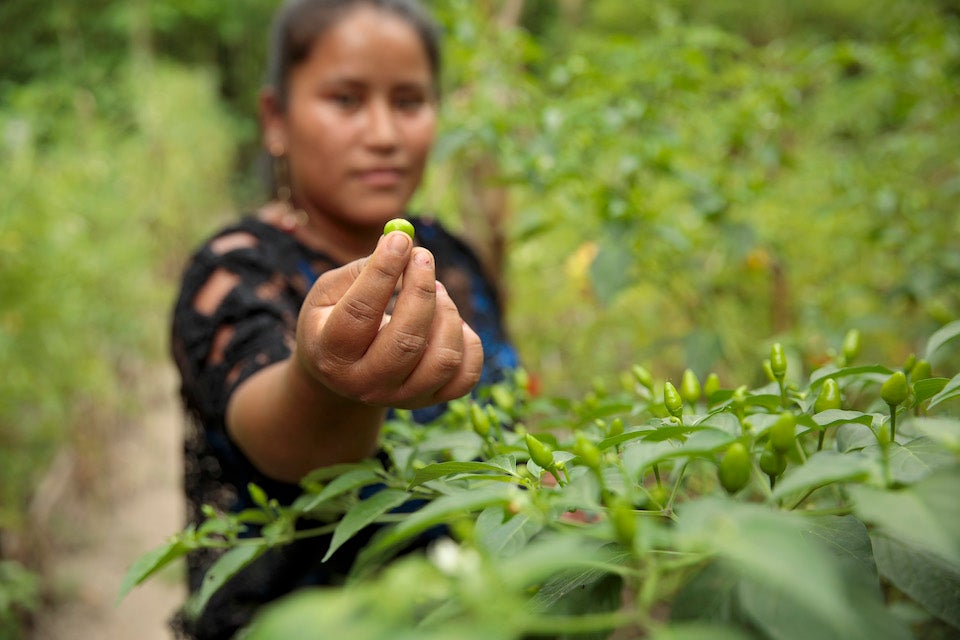

Promote women’s empowerment through technology
Technology plays an ever-increasing role in the ways we learn, work and communicate, and cellphones have gone from a luxury to an essential means of connecting with the world. But for many of the world’s women, such technology—as well as the access and independence it confers—remain out of reach: based on data for 2017-2021, women are less likely than men to own a phone in 50 of 82 countries.
Sound policies and legislation
Gender equality is not going to happen on its own. We need enforceable policies and legislation at all levels of government to promote the empowerment of women and girls. Particularly in the wake of COVID-19, whose socioeconomic impacts overwhelmingly hit women harder than men, gender-sensitive policies are essential for narrowing persistent gender gaps.
This requires dedicated resources. By tracking—and making public—budget allocations toward gender equality, governments can ensure adequate financing, as well as increasing transparency and accountability. But according to data from 2018–2021, only 26 per cent of countries have comprehensive systems in place to track such allocations, and 15 per cent have no system at all.
The time to act is now
Across its nine objectives, the latest data on SDG 5 underscores just how far we are from achieving it. Despite progress on some issues, recent backslide in other areas—such as on reproductive rights and women’s economic empowerment—has put gender equality further out of reach.
Without seriously increased investments and commitments, including to gender data availability and use, SDG 5 will not be achieved by 2030 and may not be achieved at all. The time to come together as a global community and demand better—better laws and protections, better access to resources and services, and better funding—is now.
Women and girls can’t afford to wait any longer.
- 2030 Agenda for Sustainable Development
- Gender data gaps
- Gender discrimination
- Gender equality and inequality
- Sustainable Development Goals (SDGs)
- Unpaid work
- Gender-responsive budgeting
- Sexual and reproductive health and rights
- Economic empowerment
- Ending violence against women and girls
- Gender equality and women’s empowerment
- Innovation and technology
- Leadership and political participation
Related content

“I want to build a network of powerful Roma women and girls” – Anzhelika Bielova on Roma women’s activism and leadership in Ukraine
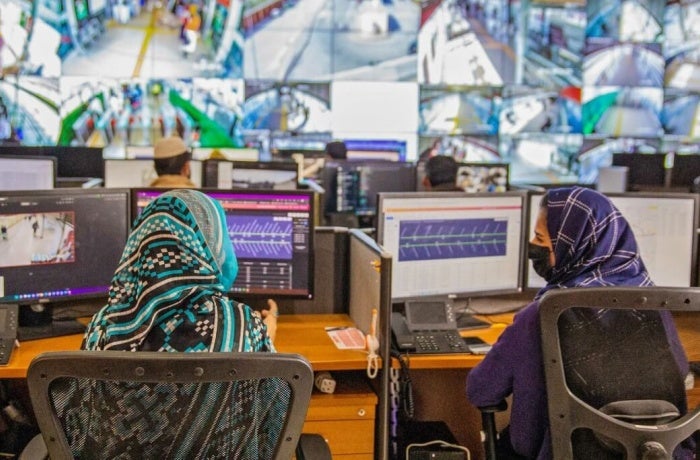
Op-ed: Improving women’s access to decent jobs

Speech: Gender equality – just, prudent, and essential for everything we all aspire to

Pathways to Urban Sustainability: Challenges and Opportunities for the United States (2016)
Chapter: 3 principles of urban sustainability: a roadmap for decision making, 3 principles of urban sustainability: a roadmap for decision making.
It must be recognized that ultimately all sustainability is limited by biophysical limits and finite resources at the global scale (e.g., Burger et al., 2012 ; Rees, 2012 ). A city or region cannot be sustainable if its principles and actions toward its own, local-level sustainability do not scale up to sustainability globally. Thus, localities that develop an island or walled-city perspective, where sustainability is defined as only activities within the city’s boundaries, are by definition not sustainable.
At its core, the concept of sustainable development is about reconciling “development” and “environment” ( McGranahan and Satterthwaite, 2003 ). Development, i.e., the meeting of people’s needs, requires use of resources and implies generation of wastes. The environment has finite resources, which present limits to the capacity of ecosystems to absorb or break down wastes or render them harmless at local, regional, and global scales.
If development implies extending to all current and future populations the levels of resource use and waste generation that are the norm among middle-income groups in high-income nations, it is likely to conflict with local or global systems with finite resources and capacities to assimilate wastes. As described in Chapter 2 , many indicators and metrics have been developed to measure sustainability, each of which has its own weaknesses and strengths as well as availability of data and ease of calculation. Some of the most prevailing indicators include footprinting (e.g., for water and land) and composite indices (e.g., well-being index and environmental sustainability index). It is beyond the scope of this report to examine all available measures, and readers are directed to any of the numerous reviews that discuss their relative merits (see, for example, Čuček et al., 2012 ; EPA, 2014a ; Janetos et al., 2012 ; Wiedmann and Barrett, 2010 ; Wilson et al., 2007 ; The World Bank, 2016 ; Yale University, 2016 ). New sustainability indicators and metrics are continually being developed, in part because of the wide range of sustainability frameworks used as well as differences in spatial scales of interest and availability (or lack thereof) of data. In recent years, city-level sustainability indicators have become more popular in the literature (e.g., Mori and Christodoulou, 2012 ).
Here we use the concept of ecological footprint, which has been proposed as an analytic tool to estimate the “load” imposed on the ecosphere by any specified human population ( Berkowitz and Rees, 2003 ). We choose it not because it is without controversy, but rather because it is one of the more commonly cited indicators that has been widely used in many different contexts around the world. The metric most often used is the total area of productive landscape and waterscape required to support that population ( Rees, 1996 ; Wackernagel and Rees, 1996 ). Ecological footprint analysis has helped to reopen the controversial issue of human “carrying capacity.” The ecological footprint of a specified population is the area of land and water ecosystems required continuously
over time to produce the resources that the population consumes, and to assimilate the wastes that the population produces, wherever on Earth the relevant land and/or water is located.
Ecological footprint calculations show that the wealthy one-fifth of the human family appropriates the goods and life support services of 5 to 10 hectares (12.35 to 24.70 acres) of productive land and water per capita to support their consumer lifestyles using prevailing technology. Only about 2 hectares (4.94 acres) of such ecosystems are available, however, for each person on Earth (with no heed to the independent requirements of other consumer species). In discussing sustainability from a global perspective, Burger et al. (2012) argued that the laws of thermodynamics and biophysical constraints place limitations on what is possible for all systems, including human systems such as cities. Given the relevance and impact of these constraints to the discussion of various pathways to urban sustainability, a further examination of these issues and their associated challenges are described in Appendix C (as well as by Day et al., 2014 ; Seto and Ramankutty, 2016 ; UNEP, 2012).
Daly (2002) proposed three criteria that must be met for a resouce or process to be considered sustainable:
- For a renewable resource—soil, water, forest, fish—the sustainable rate of use can be no greater than the rate of regeneration of its source.
- For a nonrenewable resource—fossil fuel, high-grade mineral ores, fossil groundwater—the sustainable rate of use can be no greater than the rate at which a renewable resource, used sustainably, can be substituted for it.
- For a pollutant—the sustainable rate of emission can be no greater than the rate at which that pollutant can be recycled, absorbed, or rendered harmless in its sink.
Fiala (2008) pointed to two issues that can be raised regarding the ecological footprint method. One is that the ecological footprint is dominated by energy as over 50 percent of the footprint of most high- and middle-income nations is due to the amount of land necessary to sequester greenhouse gases (GHGs). The other is associated to the impact of technology intensity that is assumed for characterizing productivity in terms of the global hectare. The results do show that humans’ global ecological footprint is already well beyond the area of productive land and water ecosystems available on Earth and that it has been expanding in the recent decades.
DESCRIPTION OF PRINCIPLES
Urban sustainability has been defined in various ways with different criteria and emphases, but its goal should be to promote and enable the long-term well-being of people and the planet, through efficient use of natural resources and production of wastes within a city region while simultaneously improving its livability, through social amenities, economic opportunity, and health, so that it can better fit within the capacities of local, regional, and global ecosystems, as discussed by Newman (1999) .
Because an increasing percentage of the world’s population and economic activities are concentrated in urban areas, cities are highly relevant, if not central, to any discussion of sustainable development. While urban areas can be centers for social and economic mobility, they can also be places with significant inequality, debility, and environmental degradation: A large proportion of the world’s population with unmet needs lives in urban areas.
Although cities concentrate people and resources, and this concentration can contribute to their sustainability, it is also clear that cities themselves are not sustainable without the support of ecosystem services, including products from ecosystems such as raw materials and food, from nonurban areas. Indeed, it is unrealistic—and not necessarily desirable—to require cities to be solely supported by resources produced within their administrative boundaries. Thinking about cities as closed systems that require self-sustaining resource independence ignores the concepts of comparative advantage or the benefits of trade and economies of scale. Since materials and energy come from long distances around the world to support urban areas, it is critical for cities to recognize how activities and consumption within their boundaries affect places and people outside their boundaries. Here it is important to consider not only the impact on land-based resources but also water and energy that are embodied in products such as clothing and food.
Ultimately, all the resources that form the base on which urban populations subsist come from someplace on the planet, most often outside the cities themselves, and often outside of the countries where the cities exist. Indeed, often multiple cities rely on the same regions for resources. Thus, urban sustainability cannot be limited to what happens within a single place. The sustainability of a city cannot be considered in isolation from the planet’s finite resources, especially given the aggregate impact of all cities. Therefore, urban sustainability will require making explicit and addressing the interconnections and impacts on the planet.
Urban sustainability is therefore a multiscale and multidimensional issue that not only centers on but transcends urban jurisdictions and which can only be addressed by durable leadership, citizen involvement, and regional partnerships as well as vertical interactions among different governmental levels.
In this context, we offer four main principles to promote urban sustainability, each discussed in detail below:
Principle 1: The planet has biophysical limits.
Principle 2: Human and natural systems are tightly intertwined and come together in cities.
Principle 3: Urban inequality undermines sustainability efforts.
Principle 4: Cities are highly interconnected.
Principle 1: The Planet Has Biophysical Limits
Urban areas and the activities within them use resources and produce byproducts such as waste and pollution that drive many types of global change, such as resource depletion, land-use change, loss of biodiversity, and high levels of energy use and greenhouse gas emissions. Over the long term and at global scales, economic growth and development will be constrained by finite resources and the biophysical limits of the planet to provide the resources required for development, industrialization, and urbanization. Currently, many cities have sustainability strategies that do not explicitly account for the indirect, distant, or long-lived impacts of environmental consumption throughout the supply and product chains. Because urban systems connect distant places through the flows of people, economic goods and services, and resources, urban sustainability cannot be focused solely on cities themselves, but must also encompass places and land from which these resources originate ( Seto et al., 2012 ). Consequently, what may appear to be sustainable locally, at the urban or metropolitan scale, belies the total planetary-level environmental or social consequences. Urban sustainability strategies and efforts must stay within planetary boundaries, 1 particularly considering the urban metabolism, constituted by the material and energy flows that keep cities alive (see also Box 3-1 ) ( Burger et al., 2012 ; Ferrão and Fernández, 2013 ). Without paying heed to finite resources, urban sustainability may be increasingly difficult to attain depending on the availability and cost of key natural resources and energy as the 21st century progresses ( Day et al., 2014 , 2016 ; McDonnell and MacGregor-Fors, 2016 ; Ramaswami et al., 2016 ). In practice cities could, for example, quantify their sustainability impacts using a number of measures such as per capita ecological footprint and, making use of economies of scale, make efforts to reduce it below global levels of sustainability. Together, cities can play important roles in the stewardship of the planet ( Seitzinger et al., 2012 ).
In an increasingly urbanized and globalized world, the boundaries between urban and rural and urban and hinterland are often blurred. In an era that is characterized by global flows of commodities, capital, information, and people, the resources to support urban areas extend the impacts of urban activities along environmental, economic, and social dimensions at national and international levels, and become truly global; crossing these boundaries is a prerequisite for sustainable governance. Ultimately, given its U.S. focus and limited scope, this report does not fully address the notion of global flows. It nevertheless serves as an indicator for advancing thinking along those lines.
___________________
1 Planetary boundaries define, as it were, the boundaries of the “planetary playing field” for humanity if we want to be sure of avoiding major human-induced environmental change on a global scale ( Rockström et al., 2009 ). The concept of planetary boundaries has been developed to outline a safe operating space for humanity that carries a low likelihood of harming the life support systems on Earth to such an extent that they no longer are able to support economic growth and human development . . . planetary boundaries do not place a cap on human development. Instead they provide a safe space for innovation, growth, and development in the pursuit of human prosperity in an increasingly populated and wealthy world ( Rockström et al., 2013 ).
There are many policy options that can affect urban activities such that they become active and positive forces in sustainably managing the planet’s resources. In many ways, this is a tragedy of the commons issue, where individual cities act in their own self-interest at the peril of shared global resources. One challenge in the case of cities, however, is that many of these shared resources do not have definable boundaries such as land. Moreover, because most cities are geographically separated from their resource base, it is difficult to assess the threat of resource depletion or decline. Thus, some strategies to manage communal resources, such as community-based, bottom-up approaches examined by Ostrom (2009a) , may be more difficult to obtain in urban settings. Another approach is for government intervention through regulation of activities or the resource base.
As one example, McGranahan and Satterthwaite (2003) suggested that adding concern for ecological sustainability onto existing development policies means setting limits on the rights of city enterprises or consumers to use scarce resources (wherever they come from) and to generate nonbiodegradable wastes. Such limits can be implemented through local authorities’ guidelines and regulations in planning and regulating the built environment, e.g., guidelines and regulations pertaining to building material production, construction, building design and performance, site and settlement planning, and efficiency standards for appliances and fixtures. Ultimately, the laws of thermodynamics limit the amount of useful recycling.
Goals relating to local or global ecological sustainability can be incorporated into the norms, codes, and regulations that influence the built environment. But city authorities need national guidelines and often national policies. In most political systems, national governments have the primary role in developing guidelines and supporting innovation allied to regional or global conventions or guidelines where international agreement is reached on setting such limits.
The effort of promoting sustainable development strategies requires a greater level of interaction between different systems and their boundaries as the impacts of urban-based consumption and pollution affect global resource management and, for example, global climate change problems; therefore, pursuing sustainability calls for unprecedented system boundaries extensions, which are increasingly determined by actions at the urban level. This is to say, the analysis of boundaries gives emphasis to the idea of “think globally, act locally.”
Principle 2: Human and Natural Systems Are Tightly Intertwined and Come Together in Cities
Healthy people-environment and human-environment interactions are necessary synergistic relationships that underpin the sustainability of cities. In order for urban places to be sustainable from economic, environmental, and equity perspectives, pathways to sustainability require a systemic approach around three considerations: scale, allocation, and distribution ( Daly, 1992 ). Human well-being and health are the cornerstones of livable and thriving cities although bolstering these relationships with myopic goals that improve human prosperity while disregarding the health of natural urban and nonurban ecosystems will only serve to undermine both human and environmental
urban sustainability in the long run. The future of urban sustainability will therefore focus on win-win opportunities that improve both human and natural ecosystem health in cities. These win-win efficiencies will often take advantage of economies of scale and adhere to basic ideas of robust urbanism, such as proximity and access (to minimize the time and costs of obtaining resources), density and form (to optimize the use of land, buildings, and infrastructure), and connectedness (to increase opportunities for efficient and diverse interactions).
Local decision making must have a larger scope than the confines of the city or region. Discussions should generate targets and benchmarks but also well-researched choices that drive community decision making. Sustainability is a community concern, not an individual one ( Pelletier, 2010 ). Healthy human and natural ecosystems require that a multidimensional set of a community’s interests be expressed and actions are intentional to mediate those interests (see also Box 3-2 ).
Principle 3: Urban Inequalities Undermine Sustainability Efforts
Reducing severe economic, political, class, and social inequalities is pivotal to achieving urban sustainability. Many of these class and cultural inequalities are the products of centuries of discrimination, including instances of officially sanctioned discrimination at the hands of residents and elected leaders ( Fullilove and Wallance, 2011 ; Powell and Spencer, 2002 ). Extreme inequalities threaten public health, economic prosperity, and citizen engagement—all essential elements of urban sustainability. Although perfect class and economic equality is not possible, severe urban disparities should remain in check if cities are to realize their full potential and become appealing places of choice for multigenerational urban dwellers and new urban immigrants alike.
Discriminatory practices in the housing market over many decades have created racial segregation in central cities and suburbs. Restrictive housing covenants, exclusionary zoning, financing, and racism have placed minorities and low-income people in disadvantaged positions to seek housing and neighborhoods that promote health, economic prosperity, and human well-being ( Denton, 2006 ; Rabin, 1989 ; Ritzdorf, 1997 ; Sampson, 2012 ; Tilley, 2006 ). Poor neighborhoods have felt the brunt of dumping, toxic waste, lack of services, and limited housing choices ( Collin and Collin, 1997 ; Commission for Racial Justice, 1987 ). There is evidence that the spatial distribution of people of color and low-income people is highly correlated with the distribution of air pollution, landfills, lead poisoning in children, abandoned toxic waste dumps, and contaminated fish consumption. Inequitable environmental protection undermines procedural, geographic, and social equities ( Anthony, 1990 ; Bullard, 1995 ). These same patterns of inequality also exist between regions and states with poor but resource-rich areas bearing the cost of the “resource curse” (see also Box 3-3 ).
Principle 4: Cities Are Highly Interconnected
Cities are not islands. Urban systems are complex networks of interdependent subsystems, for which the degree and nature of the relationships are imperfectly known. The spatial and time scales of various subsystems are different, and the understanding of individual subsystems does not imply the global understanding of the full system. Meeting the challenges of planetary stewardship demands new governance solutions and systems that respond to the realities of interconnectedness. Currently, urban governance is largely focused on single issues such as water,
transportation, or waste. A multiscale governance system that explicitly addresses interconnected resource chains and interconnected places is necessary in order to transition toward urban sustainability ( Box 3-4 ).
Urban sustainability requires the involvement of citizens, private entities, and public authorities, ensuring that all resources are mobilized and working toward a set of clearly articulated goals. This is particularly relevant as places undergo different stages of urbanization and a consequent redrawing of borders and spheres of economic influence. Sustainable solutions are to be customized to each of the urban development stages balancing local constraints and opportunities, but all urban places should strive to articulate a multiscale and multipronged vision for improving human well-being. An important example is provided by climate change issues, as highlighted by Wilbanks and Kates (1999) : Although climate change mainly takes place on the regional to global scale, the causes, impacts, and policy responses (mitigation and adaptation) tend to be local.
As discussed by Bai (2007) , the fundamental point in the scale argument is that global environmental issues are simply beyond the reach and concern of city government, and therefore it is difficult to tackle these issues at the local level. As simple and straightforward as this may sound, the scale argument encompasses more than spatial scale—it is composed of multiple dimensions and elements. Bai (2007) points to three—the spatial, temporal, and institutional dimensions—and in each of these dimensions, three elements exist: scale of issues, scale of concerns, and scale of actions and responses. Understanding these interconnections within system boundaries, from urban to global, is essential to promote sustainability. In particular, the institutional dimension plays an important role in how global issues are addressed, as discussed by Gurr and King (1987) , who identified the need to coordinate two levels of action: the first relates to “vertical autonomy”—the city’s relationship with federal administration—and the second relates to the “horizontal autonomy”—a function of the city’s relationship with local economic and social groups that the city depends on for its financial and political support.
BUILDING AN URBAN SUSTAINABILITY ROADMAP
Designing a successful strategy for urban sustainability requires developing a holistic perspective on the interactions among urban and global systems, and strong governance. This lens is needed to undergird and encourage collaborations across many organizations that will enable meaningful pathways to urban sustainability. In order to facilitate the transition toward sustainable cities, we suggest a decision framework that identifies a structured but flexible process that includes several critical elements ( Figure 3-1 ).
The roadmap is organized in three phases: (1) creating the basis for a sustainability roadmap, (2) design and implementation, and (3) outcomes and reassessment. A description of each of these phases is given below.
Phase 1: Creating the Basis for a Sustainability Roadmap
Adopt urban sustainability principles.
This is the first step to establish an urban sustainability framework consistent with the sustainability principles described before, which provide the fundamental elements to identify opportunities and constraints for different contexts found in a diversity of urban areas.

Identify Opportunities and Constraints
Any urban sustainability strategy is rooted in place and based on a sense of place, as identified by citizens, private entities, and public authorities. In this step it is critical to engage community members and other stakeholders in identifying local constraints and opportunities that promote or deter sustainable solutions at different urban development stages. Community engagement will help inform a multiscale vision and strategy for improving human well-being through an environmental, economic, and social equity lens. Often a constraint may result in opportunities in other dimensions, with an example provided by Chay and Greenstone (2003) on the impact of the Clean Air Act amendments on polluting plants from 1972 and 1987. They found that while those companies lost almost 600,000 jobs compared with what would have happened without the regulations, there were positive gains in health outcomes. Complementary research showed that clean air regulations have reduced infant mortality and increased housing prices ( Chay and Greenstone, 2005 ; EPA, 1999 ). This study provides direct and easily interpreted estimates of the air quality and infant health benefits of the 1970 Act. The results imply that poor air quality had substantial effects on infant health at concentrations near the U.S. Environmental Protection Agency–mandated air quality standard and that roughly 1,300 fewer infants died in 1972 than would have in the absence of the Act. Furthermore, this study’s findings cross-validate the findings of earlier work examining the recession-induced pollution reductions of the early 1980s.
Prioritize and Identify Co-net Benefits
Decision making at such a complex and multiscale dimension requires prioritization of the key urban issues and an assessment of the co-net benefits associated with any action in one of these dimensions. Where possible, activities that offer co-occurring, reasonably sized benefits in multiple dimensions of sustainability should be closely considered and pursued as primary choices while managing tradeoffs. Activities that provide co-benefits that are small in magnitude, despite being efficient and co-occurring, should be eschewed unless they come at relatively small costs to the system.
Phase 2: Design and Implementation
Catalyze and engage partnerships with major stakeholders and the public.
Urban sustainability requires durable, consistent leadership, citizen involvement, and regional partnerships as well as vertical interactions among different governmental levels, as discussed before. Furthermore, the governance of urban activities does not always lie solely with municipal or local authorities or with other levels of government. Nongovernmental organizations and private actors such as individuals and the private sector play important roles in shaping urban activities and public perception.
Establish Goals, Targets, and Indicators
Commitment to sustainable development by city or municipal authorities means adding new goals to those that are their traditional concerns ( McGranahan and Satterthwaite, 2003 ). Meeting development goals has long been among the main responsibilities of urban leaders. These goals generally include attracting new investment, improving social conditions (and reducing social problems), ensuring basic services and adequate housing, and (more recently) raising environmental standards within their jurisdiction. These goals do not imply that city and municipal authorities need be major providers of housing and basic services, but they can act as supervisors and/or supporters of private or community provision. A concern for sustainable development retains these conventional concerns and adds two more. The first is to consider the environmental impacts of urban-based production and consumption on the needs of all people, not just those within their jurisdiction. The second is an understanding of the finite nature of many natural resources (or the ecosystems from which they are drawn) and of the capacities of natural systems in the wider regional, national, and international context to absorb or break down wastes.
Develop Urban Sustainability Strategies
Urban sustainability goals often require behavior change, and the exact strategies for facilitating that change, whether through regulation or economic policies, require careful thought. Specific strategies can then be developed to achieve the goals and targets identified. These strategies should not be developed in isolation, but rather in collaboration with, or ideally, developed by, the practitioners responsible for achieving the goals and targets. This helps to facilitate the engagement, buy-in, and support needed to implement these strategies.
The strategies employed should match the context. Specifically, market transformation can traditionally be accomplished by first supporting early adopters through incentives; next encouraging the majority to take action through market-based approaches, behavior change programs, and social norming; and, finally, regulating to prompt action from laggards. This common approach can be illustrated in the case of urban food scraps collection where many cities first provided in-kind support to individuals and community groups offering collection infrastructure and services, then rolled out programs to support social norming in communities (e.g., physical, visible, green bins for residents to be put out at the curb), and finally banned organics from landfills, providing a regulatory mechanism to require laggards to act.
Identify Data Availability and Gaps and Establish an Indicator Framework
The development of analysis to improve the sustainability of urbanization patterns, processes, and trends has been hindered by the lack of consistent data to enable the comparison of the evolution of different urban systems, their dynamics, and benchmarks. Providing the data necessary to analyze urban systems requires the integration of different economic, environmental, and social tools. These tools should provide a set of indicators whose political relevance refers both to its usefulness for securing the fulfillment of the vision established for the urban system and for providing a basis for national and international comparisons, and the metrics and indicators should be policy relevant and actionable. Furthermore, the development of indicators should be supported with research that expresses the impact of the indicator. Every indicator should be connected to both an implementation and an impact statement to garner more support, to engage the public in the process, and to ensure the efficiency and impact of the indicator once realized. Understanding indicators and making use of them to improve urban sustainability could benefit from the adoption of a DPSIR framework, as discussed by Ferrão and Fernández (2013) . The DPSIR framework describes the interactions between society and the environment, the key components of which are driving forces (D), pressures (P) on the environment and, as a result, the states (S) of environmental changes, their impacts (I) on ecosystems, human health, and other factors, and societal responses (R) to the driving forces, or directly to the pressure, state, or impacts through preventive, adaptive, or curative solutions. Such a framework of indicators constitutes a practical tool for policy making, as it provides actionable information that facilitates the understanding and the public perception of complex interactions between drivers, their actions and impacts, and the responses that may improve the urban sustainability, considering a global perspective.
Practitioners starting out in the field would be well served by adopting one or more of the best practice standards (e.g., United Nations Sustainable Development Goals, Urban Sustainability Directors Network Sustainability Tools for Assessing and Rating Communities, and International Organization for Standardization Sustainability Standards) rather than endeavoring to develop their own unique suite of metrics as their data would be more comparable between cities and would have some degree of external validity built in. A practitioner could complement the adopted standard(s) with additional indicators unique to the city’s context as necessary.
Implementation
Institutional scale plays an important role in how global issues can be addressed. For example, as discussed by Bai (2007) , at least two important institutional factors arise in addressing GHG emission in cities: The first is the vertical jurisdictional divide between different governmental levels; the second is the relations between the local government and key industries and other stakeholders. According to the definition by Gurr and King (1987) , the first relates to vertical autonomy, which is a function of the city’s relationship with senior-level government,
and the second relates to horizontal autonomy, which is a function of the city’s relationship with local economic and social groups that the city depends on for its financial and political support. The implementation of long-term institutional governance measures will further support urban sustainability strategies and initiatives.
Phase 3: Outcomes and Reassessment
Assessing impacts from local to global.
Conceptually, the idea that there is an ecological footprint, and that sustainable cities are places that seek to minimize this footprint, makes great sense ( Portney, 2002 ). Assessing a city’s environmental impacts at varying scales is extremely difficult. In practice, simply trying to pin down the size of any specific city’s ecological footprint—in particular, the ecological footprint per capita—may contribute to the recognition of its relative impacts at a global scale.
How many goods are imported into and exported from a city is not known in practically any U.S. city. Getting an accurate picture of the environmental impacts of all human activity, including that of people working in the private sector, is almost impossible. However, some cities are making a much more concerted effort to understand the full range of the negative environmental impacts they produce, and working toward reducing those impacts even when impacts are external to the city itself. Cities that are serious about sustainability will seek to minimize their negative environmental impacts across all scales from local to global.
Develop Ground Truthing and Public Buy-in
As discussed by Bai (2007) , although there are factors beyond local control, the main obstacles to bringing the global concerns onto the local level are the reflection of contradictory perceptions, concerns, interests, and priorities, rather than the scale of the issue. Therefore, the elimination of these obstacles must start by clarifying the nature of the issue, identifying which among the obstacles are real and which can be handled by changing perceptions, concerns, and priorities at the city level. For instance, over the past 50 years, many U.S. cities experienced unprecedented reductions in population, prominently driven by highly publicized perceptions that city environments are somehow innately unsafe. However, recent scientific analyses have shown that major cities are actually the safest areas in the United States, significantly more so than their suburban and rural counterparts, when considering that safety involves more than simply violent crime risks but also traffic risks and other threats to safety ( Myers et al., 2013 ). It is crucial for city leaders to be aware of such perceptions, both true and artificial, and the many opportunities that may arise in directly addressing public concerns, as well as the risks and consequences of not doing so.
Some of the major advantages of cities as identified by Rees (1996) include (1) lower costs per capita of providing piped treated water, sewer systems, waste collection, and most other forms of infrastructure and public amenities; (2) greater possibilities for, and a greater range of options for, material recycling, reuse, remanufacturing, and the specialized skills and enterprises needed to make these things happen; (3) high population density, which reduces the per capita demand for occupied land; (4) great potential through economies of scale, co-generation, and the use of waste process heat from industry or power plants, to reduce the per capita use of fossil fuel for space heating; and (5) great potential for reducing (mostly fossil) energy consumption by motor vehicles through walking. There is the issue, however, that economic and energy savings from these activities may suffer from Jevon’s Paradox in that money and energy saved in the ways mentioned above will be spent elsewhere, offsetting local efficiencies ( Brown et al., 2011 ; Hall and Klitgaard, 2011 ).
Learning from Outcomes and Ongoing Reassessment of Goals and Priorities
The continuous reassessment of the impact of the strategy implemented requires the use of metrics, and a DPSIR framework will be particularly useful to assess the progress of urban sustainability. Here we advocate a DPSIR conceptual model based on indicators used in the assessment of urban activities (transportation, industry,
tourism, etc.), as discussed in Chapter 2 . Classifying these indicators as characterizing a driver, a pressure, the state, the impact, or a response may allow for a detailed approach to be used even in the absence of a comprehensive theory of the phenomena to be analyzed. The use of a DPSIR model posits an explicit causality effect between different actors and consequences and ensures exhaustive coverage of the phenomena contained in the model ( Ferrão and Fernandez, 2013 ).
Developing new signals of urban performance is a crucial step to help cities maintain Earth’s natural capital in the long term ( Alberti, 1996 ). The task is, however, not simple. The challenge is to develop a new understanding of how urban systems work and how they interact with environmental systems on both the local and global scale. Three elements are part of this framework:
- Key variables to describe urban and environmental systems and their interrelationships;
- Measurable objectives and criteria that enable the assessment of these interrelationships; and
- Feedback mechanisms that enable the signals of system performance to generate behavioral responses from the urban community at both the individual and institutional levels.
A DPSIR framework is intended to respond to these challenges and to help developing urban sustainability policies and enact long-term institutional governance to enable progress toward urban sustainability.
RESEARCH AND DEVELOPMENT NEEDS
Urban sustainability is a large and multifaceted topic. The following discussion of research and development needs highlights just a few ways that science can contribute to urban sustainability. This discussion focuses on promoting a systems approach—connections, processes, and linkages—that requires data, benchmarks, and guidance on what variables are relevant and what processes are most critical to understanding the relationships among the parts of the system. As such, there are many important opportunities for further research. These opportunities can be loosely placed in three categories: first, filling quantitative data gaps; second, mapping qualitative factors and processes; and third, identifying and scaling successful financing models to ensure rapid adoption.
First, large data gaps exist. Efforts have been made by researchers and practitioners alike to create sets of indicators to assist in measuring and comparing the sustainability of municipalities, but few thresholds exist, and those that do often seem unattainable to municipal leaders. For example, in order to ensure that global warming remains below two degrees Celsius, the theoretical “safe limit” of planetary warming beyond which irreversible feedback loops begin that threaten human health and habitat, most U.S. cities will need to reduce GHG emissions 80 percent by 2050. This is a target that leading cities have begun to adopt, but one that no U.S. city has developed a sound strategy to attain. Second, cities exist as part of integrated regional and global systems that are not fully understood. Further mapping of these processes, networks, and linkages is important in order to more fully understand the change required at the municipal level to support global sustainability. Some promising models exist, such as MIT’s Urban Metabolism framework, that warrant further development ( Ferrão and Fernández, 2013 ). Third, the critical task of developing finance models to support urban sustainability action requires urgent attention. Successful models exist elsewhere (such as British Columbia, Canada’s, carbon tax), which can be adapted and scaled to support urban sustainability action across America.
A summary of major research and development needs is as follows.
Urban Metabolism
Urban metabolism 2 may be defined as the sum of the technical and socioeconomic processes that occur in cities, resulting in growth, production of energy, and elimination of waste ( Kennedy et al., 2007 ).
2 Abel Wolman (1965) developed the urban metabolism concept as a method of analyzing cities and communities through the quantification of inputs—water, food, and fuel—and outputs—sewage, solid refuse, and air pollutants—and tracking their respective transformations and flows. See also Holmes and Pincetl (2012) .
Characterizing the urban metabolism constitutes a priority research agenda and includes quantification of the inputs, outputs, and storage of energy, water, nutrients, products, and wastes, at an urban scale. This task is complex and requires further methodological developments making use of harmonized data, which may correlate material and energy consumption with their socioeconomic drivers, as attempted by Niza et al. (2009) , NRC (2004) , Pina et al. (2015) , and Rosado et al. (2014) .
Once established, urban metabolism models supported by adequate tools and metrics enable a research stream to explore the optimization of resource productivity and the degree of circularity of resource streams that may be helpful in identifying critical processes for the sustainability of the urban system and opportunities for improvement.
Flows Between Places, Linkages, and Network Characterization
Much of the current information on urban areas is about “stocks” or snapshots of current conditions of a single place or location. However, what is needed is information on flows between places, which allows the characterization of networks, linkages, and interconnections across places. This type of information is critically important to develop new analyses to characterize and monitor urban sustainability, especially given the links between urban places with global hinterlands.
Research Aimed at Detecting Thresholds
To improve the threshold knowledge of sustainability indicators and their utility in defining an action strategy, it is necessary to have empirical tests of the performance and redundancy of these indicators and indicator systems. 3 This is of increasing importance to policy makers and the public as human production and consumption put increased stress on environmental, economic, and social systems. In each parameter of sustainability, disruptions can only be withstood to a certain level without possible irreversible consequences. To avoid negative consequences, it is important to identify the threshold that is available and then determine the actual threshold values. The scientific study of environmental thresholds, their understanding, modeling, and prediction should also be integrated into early warning systems to enable policy makers to understand the challenges and impacts and respond effectively ( Srebotnjak et al., 2010 ).
Understanding Different Types of Data
There is a need to go beyond conventional modes of data observation and collection and utilize information contributed by users (e.g., through social media) and in combination with Earth observation systems. The key here is to be able to provide information on processes across multiple scales, from individuals and households to blocks and neighborhoods to cities and regions.
Decision-Making Processes That Link Across Scales
Very little information on the phases of urban processes exists, be it problem identification or decision making. Information is needed on how the processes operate, including by whom and where outcomes and inputs are determined as well as tipping points in the system.
All of the above research needs derive from the application of a complex system perspective to urban sustainability. In other words, the needs call for the study of cities as complex systems, including the processes at different scales, determining factors, and tipping points to avoid adverse consequence. Ultimately, the goal of urban sustainability is to promote and enable the long-term well-being of people and the planet, yet doing so requires recognition of the biophysical constraints on all human and natural systems, as well as the acknowledgment that urban sustainability is multiscale and multidimensional, both encompassing and transcending urban jurisdictions.
3 Clark, C. M. 2015. Statement at NAS Exploratory Meeting, Washington, DC. October 15, 2015.
Urban sustainability therefore requires horizontal and vertical integration across multiple levels of governance, guided by four principles: the planet has biophysical limits, human and natural systems are tightly intertwined and come together in cities, urban inequality undermines sustainability efforts, and cities are highly interconnected. A comprehensive strategy in the form of a roadmap, which incorporates these principles while focusing on the interactions among urban and global systems, can provide a framework for all stakeholders engaged in metropolitan areas, including local and regional governments, the private sector, and nongovernmental organizations, to enable meaningful pathways to urban sustainability. Science can also contribute to these pathways by further research and development of several key facets of urban areas including urban metabolism, threshold detection of indicators, comprehension of different data sets, and further exploration of decision-making processes linked across scales.
Cities have experienced an unprecedented rate of growth in the last decade. More than half the world’s population lives in urban areas, with the U.S. percentage at 80 percent. Cities have captured more than 80 percent of the globe’s economic activity and offered social mobility and economic prosperity to millions by clustering creative, innovative, and educated individuals and organizations. Clustering populations, however, can compound both positive and negative conditions, with many modern urban areas experiencing growing inequality, debility, and environmental degradation.
The spread and continued growth of urban areas presents a number of concerns for a sustainable future, particularly if cities cannot adequately address the rise of poverty, hunger, resource consumption, and biodiversity loss in their borders. Intended as a comparative illustration of the types of urban sustainability pathways and subsequent lessons learned existing in urban areas, this study examines specific examples that cut across geographies and scales and that feature a range of urban sustainability challenges and opportunities for collaborative learning across metropolitan regions. It focuses on nine cities across the United States and Canada (Los Angeles, CA, New York City, NY, Philadelphia, PA, Pittsburgh, PA, Grand Rapids, MI, Flint, MI, Cedar Rapids, IA, Chattanooga, TN, and Vancouver, Canada), chosen to represent a variety of metropolitan regions, with consideration given to city size, proximity to coastal and other waterways, susceptibility to hazards, primary industry, and several other factors.
READ FREE ONLINE
Welcome to OpenBook!
You're looking at OpenBook, NAP.edu's online reading room since 1999. Based on feedback from you, our users, we've made some improvements that make it easier than ever to read thousands of publications on our website.
Do you want to take a quick tour of the OpenBook's features?
Show this book's table of contents , where you can jump to any chapter by name.
...or use these buttons to go back to the previous chapter or skip to the next one.
Jump up to the previous page or down to the next one. Also, you can type in a page number and press Enter to go directly to that page in the book.
Switch between the Original Pages , where you can read the report as it appeared in print, and Text Pages for the web version, where you can highlight and search the text.
To search the entire text of this book, type in your search term here and press Enter .
Share a link to this book page on your preferred social network or via email.
View our suggested citation for this chapter.
Ready to take your reading offline? Click here to buy this book in print or download it as a free PDF, if available.
Get Email Updates
Do you enjoy reading reports from the Academies online for free ? Sign up for email notifications and we'll let you know about new publications in your areas of interest when they're released.
Developing countries are key to climate action
Subscribe to the sustainable development bulletin, amar bhattacharya , amar bhattacharya senior fellow - global economy and development , center for sustainable development homi kharas , and homi kharas senior fellow - global economy and development , center for sustainable development john w. mcarthur john w. mcarthur director - center for sustainable development , senior fellow - global economy and development @mcarthur.
March 3, 2023
Developing countries will be the most severely affected by accelerating climate change and, even excluding China from the calculation, are likely to emit more than half the annual global total of greenhouse gas (GHG) emissions as early as 2030. But the international community has not focused sufficiently on the range of development, adaptation, and resilience priorities and constraints these countries face in tackling the world’s interwoven emissions mitigation imperative.
In an effort to help shift the global policy frame toward the crucial perspectives of developing countries themselves, we recently published an edited volume, Keys to climate action: How developing countries could drive global success and local prosperity . Within the volume, a wide range of distinguished contributors present both country case studies (on Bangladesh , Egypt , India , Indonesia , Nigeria , and South Africa ) and wider geography-focused assessments (on East Africa , Africa as a whole, Latin America and the Caribbean , and the V20 group of vulnerable countries ), in addition to an assessment of the overarching financing challenges .
As a collection, these studies describe how climate change is hindering local development efforts while also providing new opportunities. They draw attention to the vital importance of elevating developing country perspectives in driving global climate action. They also offer central insights on the diverse and evolving issues that need to be front-of-mind when considering the relevant challenges.
Range of circumstances
Developing countries should not be considered as a monolithic group. They have different though overlapping interests, given their circumstances. Small islands, for example, have temporarily responded to natural disasters by borrowing to rebuild and protect the livelihoods of their citizens, but as the scale and intensity of climate change accelerates, their fiscal flexibility is fast eroding.
Other countries remain concerned that embarking on an energy transition will impede their overall economic growth and hard-won progress in tackling food security, education, health, and other elements of sustainable development. The political economy of transition to a low-carbon economy can be daunting. Vested interests in coal and fossil-fuel industries can be strong. Geographic imbalances between winners and losers complicate the politics of change.
Evolving perspectives
Nonetheless, the case studies suggest that attitudes and official positions are evolving. There is a new understanding that an integrated climate-and-development program can simultaneously speed up development and lower GHG emissions if implemented at scale. Investment and innovations in adaptation, resilience, nature, and emissions mitigation can be in each country’s national self-interest if they boost economic growth while providing cheaper and more inclusive access to modern energy. Such a strategy avoids the penalties of trade tariffs in a world with carbon border tax adjustments. It is creating excitement over new opportunities for developing countries to provide credits that can be sold in voluntary and compliance-based carbon markets in advanced economies. It could allow them to participate in new technologies such as green hydrogen.
Domestic policy challenges
Seizing these opportunities requires strong institutions and robust national policy systems. Governments at national and sub-national levels must manage here-and-now costs already hurting their people and economies while also organizing and delivering toward a comprehensive energy transition. This transition is remarkably complex. In addition to innovations in new technologies, transitions must be designed and viewed through a lens of justice—between countries, across geographies within countries, across workers, across generations, and across gender gaps.
The global financing challenge
The case studies also draw attention to the huge challenge of finance—which we dub a “broken thread” of the international system.
The case studies also draw attention to the huge challenge of finance—which we dub a “broken thread” of the international system. Most developing countries must rely on international finance to supplement their own resources, but there is far too little available. There is not enough concessional finance, which is critical for loss and damage, for meeting the costs of just transitions, and for adaptation where projects do not generate direct revenues. Nor is there enough non-concessional public finance. Private finance has a major role to play but can be too expensive and volatile for many of the needed investments.
Recent granular assessments of climate finance needs suggest that emerging markets and developing countries other than China will need to increase climate spending to around $2.4 trillion per year by 2030—more than four times the current level—of which $1 trillion would need to come from external sources. This is an order of magnitude greater than the initial commitment made by advanced economies in Copenhagen in 2009 to provide $100 billion in additional climate finance to developing countries by 2020, a pledge that has still not been met. Our volume’s bottom-up case studies corroborate the major gaps in the global financial architecture, and a gap in the process of coordinating finance from different sources.
All of this leads to a prominent role for multilateral development banks (MDBs) and development finance more broadly. The MDBs could help countries to set out and implement ambitious climate and sustainable development strategies, tackle policy and institutional gaps that impede the scaling-up of investments, mobilize more affordable private capital, ramp up their own financing for critical public investment needs, and assist countries in coordinating multiple stakeholders behind a coherent vision and strategy. To do all of this would make them into quite different organizations from what they are today.
Four key ingredients for progress
What can be done to trigger progress on such a large, crucial, and complex set of global challenges? In our overview chapter for the volume, we identify four key ingredients to help drive successful action and outcomes.
- Developing countries should help set the international agenda. Developing countries need to join forces on their international “asks,” not only for adaptation and resilience, on which they have been increasingly successful, but also on mitigation, for which differences in self-interest often still prevail. This is important for overcoming shortfalls in understanding within international climate and development negotiations of the major priorities faced by developing countries in articulating and implementing integrated climate-and-development strategies. For example, an advanced economy lens focused narrowly on mitigation is not helpful in creating ownership for climate action in developing countries, nor are processes that keep climate and development on separate negotiating tracks.
- Country-by-country planning and consensus building is foundational. Developing countries need to undertake the detailed work of identifying long-term strategies and projects to tackle their own integrated climate and development challenge. They require processes for civic participation that could become a basis for creating broad popular endorsement of a new strategy. The “just energy transition partnerships” described in some of our volume’s case studies provide an understanding of how to map and navigate relevant political economy issues, even if they are still works in progress.
- Financing is essential. Multiple types of finance need to be scaled up, with the mix varying by country and project type. Rich countries should double their climate finance commitment by 2025 and enhance its effectiveness, while the international community should pursue all avenues to scale up the availability of low-cost finance. Interest rates and maturities, uncertainties of terms, and ability of developing countries to access fragmented sources of finance all need to be addressed. The case studies put forward several targeted ideas on actions that could be taken. A reformed multilateral development bank system is a recurring urgent theme.
- A focus on building trust. Developing countries can press advanced economies to take proactive steps to rebuild confidence in international cooperation. This is important both for fostering political collaboration and mitigating technical risks. Strategies for making faster progress on both climate and economic development challenges have two important features that cut across countries. They have greater risks in the short run from the added financial exposure, but they have greater benefits when everyone moves in the same direction. If everyone trusts others to do their part, the risks of being a “first mover” can be reduced. For their own part, developing countries can help rebuild the spirit of global solutions to global problems by refining their ambitions of what exactly they will take on in the presence of greater support from the international community.
Looking ahead
However helpful this edited volume turns out to be, Keys to Climate Action amounts to only one undertaking aiming to elevate developing country perspectives in advancing a new reference point for the world’s central climate and development challenges. Further efforts are needed to refine and advance the relevant issues in the lead-up to major events like the G-20 summits (hosted by India in 2023 and Brazil in 2024), the COP28 climate summit (hosted by United Arab Emirates in 2023), and around the growing calls for reform of the World Bank and related institutions. With a sustained push of collective energy and attention, emergent insights and institutional innovations can help drive a new era of widespread prosperity for all.
Related Content
Amar Bhattacharya, Homi Kharas, John W. McArthur
February 16, 2023
Homi Kharas, Charlotte Rivard
January 10, 2023
Kersten Stamm, Dana Vorisek
February 22, 2023
Emerging Markets & Developing Economies
Global Economy and Development
Egypt India Indonesia Latin America & the Caribbean Nigeria South Africa South Asia Sub-Saharan Africa
Center for Sustainable Development
Election ’24: Issues at Stake
Abraão Vicente
March 22, 2024
January 23, 2024
November 15, 2023
What Are the Three Pillars of Sustainability?
These pillars offer a solutions-oriented approach to sustainability issues.
Liz is a marine biologist, environmental regulation specialist, and science writer. She has previously studied Antarctic fish, seaweed, and marine coastal ecology.
:max_bytes(150000):strip_icc():format(webp)/shaileywoodley-54-c05de5b796fc46e391cf9454958898a0.jpeg)
- College of William & Mary
- Northeastern University
:max_bytes(150000):strip_icc():format(webp)/ScreenShot2021-04-07at1.57.45PM-bcef177316c94cdf998457c694cce6d5.png)
- University of Tennessee
Mint Images / Getty Images
- Corporate Responsibility
- Environmental Policy
- Food Issues
Sustainability is often broken into three intertwined categories: social sustainability, economic sustainability, and environmental sustainability. Together, these three forms of sustainability are known as the "three pillars of sustainability." The three pillars of sustainability provide a framework for applying a solutions-oriented approach to complicated sustainability issues like fisheries management.
The concept of the "three pillars" is fundamental to many companies , institutions, and government agencies today including the United Nations (UN) and the U.S. Environmental Protection Agency . Despite their widespread application, the three pillars have no clear origin. Instead, the three pillars of sustainability are thought to have formed gradually through economic, environmental, and social critiques in early academic literature. It wasn't until the 1980s that the three pillars of sustainability became a part of mainstream culture.
The Three Pillars of Sustainability
The three pillars of sustainability lack a clear and consistent definition. Today the three pillars, along with the definition of "sustainability" itself, are subject to several different interpretations. While interpretations of the individual pillars vary, together the three pillars are meant to work in connection to one another with true sustainability occurring when the three pillars are balanced.
filmfoto / Getty Images
Social Sustainability
Social sustainability includes environmental justice , human health, resource security, and education, among other important social elements of society. Under the three pillars concept, efforts to promote social sustainability should also aim to foster economic and environmental benefits, too.
For businesses, efforts to generate social sustainability could include focusing company efforts on employee retention instead of economic priorities. For example, investments in the well-being of employees are likely to generate economic benefits for the company by increasing employee motivation.
Efforts to increase social sustainability can also benefit the environment. For example, people's diet choices can have a substantial impact on both human health and the health of the environment , therefore advocacy for healthier eating can benefit the environment, too.
Economic Sustainability
Economic sustainability includes job creation, profitability, and proper accounting of ecosystem services for optimal cost-benefit analyses. When it comes to the job market, research shows high rates of employment benefit both the economy and the people's social well-being through the resource security employment provides. In this way, the economic drivers requiring companies to need employees and for people to need jobs can also foster social sustainability if employment offers people security.
However, today's gig economy places social and economic sustainability at odds with one another. The gig economy causes many people to contribute to the economic sustainability of companies without receiving the social safety nets typically provided by employment in return.
Efforts to be more environmentally sustainable can also benefit the economic sustainability of an organization. For example, recycling valuable materials, such as electronic waste and textile waste, can lower operating costs and reduce the intensity of resource extraction required to sustain businesses.
Environmental Sustainability
Environmental sustainability focuses on the well-being of the environment. This pillar includes water quality, air quality, and reduction of environmental stressors, such as greenhouse gas emissions. Human health depends greatly on the quality of a person's environment, inextricably linking human health and the state of the environment. Therefore, efforts to preserve and restore the environment benefits people, too.
The environment also provides natural resources necessary to foster economic sustainability. Companies rely on the extraction of natural resources to be economically sustainable. Efforts to extract resources at levels that are sustainable for the environment will also provide economic sustainability through the continued availability of resources.
Applications of the Three Pillars
Since the 1980s, when the three pillars were widely popularized, businesses, governments, and organizations have applied the pillars to their practices with variable success. Conceptually, true sustainability requires even consideration of the three pillars.
Commercial Fishing
When it comes to the three pillars of sustainability, some say the economic drivers of the fishing industry are in direct conflict with both environmental sustainability and social sustainability. To achieve economic sustainability, the fishing industry is accused of overfishing the world's oceans to the detriment of both the environment and the people who depend on its resources .
Thomas Barwick / Getty Images
Despite the apparent conflict between the commercial fishing industry's economic sustainability and the other two pillars, a recent study argues that when it comes to the fishing industry, the three pillars of sustainability are actually complementary.
The key, the study explains, is to eliminate the trade-off between the fishing industry's short-term economic gains and long-term social and environmental destruction through proper fisheries regulations because the short-term economic drivers of overfishing also hurt economic sustainability itself. To correct the incentive structure, the study suggests the establishment of harvest rights through catch shares, cooperatives, or territorial use rights for fisheries (TURFs).
Development
The United Nations applies the three pillars of sustainability to its development initiatives. Today, the UN agenda includes 17 Sustainable Development Goals . However, the UN's goals have been criticized for being too simple to where they are rendered weak, impractical, or altogether meaningless. Others argue the UN's goals would be better met if each goal focused on a single pillar.
However, based on public perception of the UN's 17 Sustainable Development Goals, the UN's work to achieve its 17 Sustainable Development Goals appears to be successful considering all three pillars. In fact, public feedback indicated each pillar was relatively equally represented by the UN's goals. Since even consideration of all three pillars is fundamental to proper implementation of the three pillars of sustainability, public sentiments indicate the UN is successfully implementing the three pillars framework to its Sustainable Development Goals.
Purvis, Ben, et al. " Three Pillars of Sustainability: In Search of Conceptual Origins ." Sustainability Science , 14, 2019, pp. 681-695., doi:10.1007/s11625-018-0627-5
Moore, Julia E., et al. " Developing a Comprehensive Definition of Sustainability ." Implementation Science , vol. 12, 2017, pp. 110., doi:10.1186/s13012-017-0637-1
Morais, Dafne O.C. and Bruno S. Silvestre, " Advancing Social Sustainability in Supply Chain Management: Lessons From Multiple Case Studies in an Emerging Economy ." Journal of Cleaner Production , vol. 199, 2018, pp. 222-235., doi:10.1016/j.jclepro.2018.07.097
Mejia, Natalia Vega, et al. " Implications of the Western Diet for Agricultural Production, Health and Climate Change ." Frontiers in Sustainable Food Systems , vol. 2, 2018, pp. 88., doi:10.3389/fsufs.2018.00088
Bouwma, Irene, et al. " Adoption of the Ecosystem Services Concept in EU Policies ." Ecosystem Services , vol. 29, pt. B, 2018, pp. 213-222., doi:10.1016/j.ecoser.2017.02.014
Gray, Matthew, et al. " The Economic and Social Benefits of Increasing Indigenous Employment. " Australian National University Centre for Aboriginal Economic Policy Research , 2014.
Malik, Radoslaw, et al. " The Gig Economy: Current Issues, the Debate, and the New Avenues of Research ." Sustainability , vol. 13, no. 9, 2021, pp. 5023., doi:10.3390/su13095023
Xavier, Lucia Helena, et al. " Sustainability and the Circular Economy: A Theoretical Approach Focused on E-Waste Urban Mining ." Resources Policy , 2019., doi:10.1016/j.resourpol.2019.101467
Nunes, Leonel J.R., et al. " Economic and Environmental Benefits of Using Textile Waste for the Production of Thermal Energy. " Journal of Cleaner Production , vol. 171, 2018, pp. 1353-1360., doi:10.1016/j.jclepro.2017.10.154
Vandyck, Toon, et al. " Air Quality Co-Benefits for Human Health and Agriculture Counterbalance Costs to Meet Paris Agreement Pledges ." Nature Communications , vol. 9, 2018, pp. 4939., doi:10.1038/s41467-018-06885-9
Krausmann, Fridolin, et al. " From Resource Extraction to Outflows of Waste and Emissions: The Socioeconomic Metabolism of the Global Economy, 1900-2015 ." Global Environmental Change , vol. 52, 2018, pp. 131-140., doi:10.1016/j.gloenvcha.2018.07.003
Kvamsdal, Sturla F., et al. " Harvest Control Rules in Modern Fisheries Management ." Elementa: Science of the Anthropocene , vol. 4, 2016, pp. 000114., doi:10.12952/journal.elementa.000114
Holden, Erling, et al. " The Imperatives of Sustainable Development ." Sustainable Development , vol. 25, no. 3, 2017, pp. 213-226., doi:10.1002/sd.1647
Dalampira, Evropi-Sofia and Setfanos A. Nastis. " Back to the Future: Simplifying Sustainable Development Goals Based on the Three Pillars of Sustainability ." International Journal of Sustainable Agricultural Management and Informatics , vol. 6, no. 3, 2020, pp. 226., doi:10.1504/IJSAMI.2020.10034327
- What Is Sustainability and Why Is It Important?
- Delta’s Green Marketing Lawsuit: A Springboard into Sustainability's Future
- Regenerative Travel: What It Is and How It's Outperforming Sustainable Tourism
- What Is Sustainable Tourism and Why Is It Important?
- What Is Ecotourism? Definition, Examples, and Pros and Cons
- The History, Evolution, and Future of Green Jobs
- What Is the Resource Conservation and Recovery Act?
- US Agencies Release Blueprint for Decarbonizing Transportation and It's Amazing
- The Energy Independence and Security Act: Summary and Impact
- Corporate Social Responsibility and the Environment: Why It Matters
- Understanding the Sustainable Seafood Industry
- What Is Community-Based Tourism? Definition and Popular Destinations
- Costa Rica’s Keys to Success as a Sustainable Tourism Pioneer
- Pollution Prevention Act: Summary and Importance
- Somalia's Humanitarian Crisis Is Also an Environmental One
- The Clean Air Act: Summary and Impact
An official website of the United States government
The .gov means it’s official. Federal government websites often end in .gov or .mil. Before sharing sensitive information, make sure you’re on a federal government site.
The site is secure. The https:// ensures that you are connecting to the official website and that any information you provide is encrypted and transmitted securely.
- Publications
- Account settings
Preview improvements coming to the PMC website in October 2024. Learn More or Try it out now .
- Advanced Search
- Journal List
- Int J Environ Res Public Health

Contribution of Home Gardens to Sustainable Development: Perspectives from A Supported Opinion Essay
Mário santos.
1 Laboratory of Fluvial and Terrestrial Ecology, Innovation and Development Center, University of Trás-os-Montes e Alto Douro, 5000-911 Vila Real, Portugal
2 Laboratory of Ecology and Conservation, Federal Institute of Education, Science and Technology of Maranhão, Rua do Comercio, 100, Buriticupu 65393-000, MA, Brazil
3 CITAB—Centre for the Research and Technology of Agro-Environment and Biological Sciences, Institute for Innovation, Capacity Building and Sustainability of Agri-Food Production (Inov4Agro) and Department of Biology and Environment, University of Trás-os-Montes e Alto Douro, 5000-801 Vila Real, Portugal
Helena Moreira
4 Department of Sports, Exercise and Health Sciences, University of Trás-os-Montes e Alto Douro, 5000-911 Vila Real, Portugal
5 CIDESD—Research Center in Sports Sciences, Health Sciences and Human Development, University of Trás-os-Montes e Alto Douro, 5000-801 Vila Real, Portugal
João Alexandre Cabral
Ronaldo gabriel, andreia teixeira, rita bastos.
6 CIBIO/InBIO/BioPolis, Centro de Investigação em Biodiversidade e Recursos Genéticos, Universidade do Porto, 4485-661 Vairão, Portugal
Alfredo Aires
7 Department of Agronomy, School of Agrarian and Veterinary Sciences, University of Trás-os-Montes e Alto Douro, UTAD, Quinta de Prados, 5000-801 Vila Real, Portugal
Associated Data
Not applicable.
Home gardening has a long history that started when humans became sedentary, being traditionally considered an accessible source of food and medicinal plants to treat common illnesses. With trends towards urbanization and industrialization, particularly in the post-World War II period, the importance of home gardens as important spaces for growing food and medicinal plants reduced and they began to be increasingly seen as decorative and leisure spaces. However, the growing awareness of the negative impacts of agricultural intensification and urbanization for human health, food quality, ecosystem resilience, and biodiversity conservation motivated the emergence of new approaches concerning home gardens. Societies began to question the potential of nearby green infrastructures to human wellbeing, food provisioning, and the conservation of traditional varieties, as well as providers of important services, such as ecological corridors for wild species and carbon sinks. In this context. and to foster adaptive and resilient social–ecological systems, our supported viewpoint intends to be more than an exhaustive set of perceptions, but a reflection of ideas about the important contribution of home gardens to sustainable development. We envision these humble spaces strengthening social and ecological components, by providing a set of diversified and intermingled goods and services for an increasingly urban population.
1. Introduction
Sustainable development has emerged as a concept associated with the growing awareness of the need to balance social–economic development with a healthy environment [ 1 ]. Moreover, sustainable development goals (SDGs) have evolved to not only include the people, planet, and prosperity, but also peace and partnership, linking the economic, social, and environmental dimensions of sustainability [ 2 ]. Even though SDGs are not simple to be applied considering the possible incompatibilities and divergent points of view among social players, they have become a fundamental component of policy frameworks by diverse stakeholders “sitting at the same table”, such as governmental agencies, researchers, civil society, and the private sector (among others), to discuss their implementation [ 3 ]. This has contributed to the vision of a global human development approach, where diverse indicators have been considered as complementary and mutually reinforcing each other [ 4 ]. Moreover, global or regional SDG frameworks can only be effective when completed locally, considering the specificity of socio-ecological systems [ 5 ]. Additionally, this implementation is supported by resilience, a key feature of sustainable social–ecological systems [ 6 ], demonstrated by their capability of reorganization after disturbance [ 7 ] and by the amount of ecosystem services that translate into contributions of nature to human wellbeing and health [ 8 ].
Given the demographic shift towards urbanization, cities are likely to increase in importance and will be the main grounds for the SDGs’ implementation [ 9 ]. In fact, 54% of the world’s population lives in urban areas—a number that is expected to increase to approximately 59% by 2030. Thus, to meet SDGs, governments should tackle the direct and remote impacts of their growing cities [ 10 ]. Therefore, urban and suburban green spaces, encompassing public gardens, urban forests, and private backyards and home (family) gardens, but also rural home gardens in monocultural/industrial agricultural landscapes, should be considered as fundamental infrastructures in the road to sustainable societies [ 11 ]. These areas could provide several types of increasingly uncommon but essential ecosystem services [ 12 ]. For example, urban, suburban, and rural gardens, and especially the network of home gardens, are significant land uses, surpassing in many countries the area occupied by commercial crops and natural habitats [ 13 ]. On the other hand, rural home gardens are not well represented by traditional mapping approaches, but studies confirm the spatial importance of rural home gardens in several countries, from tropical to temperate regions [ 14 , 15 , 16 , 17 , 18 ]. These rural home gardens are in relapse, jeopardized by abandonment and by the increasing area occupied by intensive large-scale agriculture [ 19 , 20 , 21 ]. Even so, home gardens, generally defined as a non-built land portions close to the household (more information in Section 1.1.1 ), are usually considered of minor importance within socioecological systems, perhaps due to their average small size, non-commercial use, and “unregulated” management [ 22 , 23 ]. Additionally, several works demonstrate their importance in the provision of a range of social, economic, and environmental services (e.g., [ 24 , 25 , 26 , 27 ]). Food production, income support, physical activity, wellbeing, and a connection with nature were all highlighted in diverse works (e.g., [ 28 , 29 , 30 ]). Additionally, the net of home gardens in a region might contribute to improve resilience within disruptive scenarios by reinforcing social equity and justice [ 31 , 32 ]. Some studies have also linked these small areas with biodiversity and nature conservation, even if complex multi-factorial factors with direct and indirect impacts on species diversity and abundance are yet to be fully understood [ 25 , 33 , 34 ]. In this way, the main objective of this work is to discuss what the authors have considered significant features of home gardens (and home gardening) associated with the SDGs, paying special attention to wellbeing and health, nutrition and carbon footprint reduction, and biodiversity and nature conservation ( Appendix A ). With this in mind, the authors suggest looking with eyes wide open at the vast possibilities of home gardens to tackle sustainable development goals and include in the discussion conceptual ideas that might help to enlighten their overall value.
1.1. Home Garden Definition and Methodological Framework
1.1.1. home garden definition.
A garden is a planned space, usually outdoors, set aside for the cultivation, display, and enjoyment of plants and other forms of nature [ 13 ]. Within gardens, home gardens are small areas (usually much less 1 hectare) surrounding the residential parcel, usually associated with family use (most home gardens are family gardens), characterized by combinations of various perennial and annual plants, sometimes in association with domestic animals and might include additional infrastructures, such as ponds, greenhouses, and green roofs [ 13 ]. From purely aesthetic gardens to food production spaces, several gardens include mixed areas (e.g., agroforests) and have diverse uses. In fact, home garden “architecture” and organization, the species chosen, and the management options are linked with the local ecological conditions, but mostly with the options of the members of the household, providing a diverse and stable supply of services and benefits to families [ 35 , 36 ]. Even if they are associated with urban domestic/family gardens and/or self-consumption, home gardens are also an important land-use component in peri-urban and rural areas and in local food markets [ 37 ].
1.1.2. Supported Opinion Methodological Framework
A pre-opinion online and face-to-face forum occurred during the 2nd semester in 2021, involving three co-authors of the manuscript, in order to debate the personal views and importance of home gardens to tackle several of the sustainable development goals. For the purposes of the opinion manuscript, as each one of the co-authors’ expertise focused on different scientific domains, namely, healthy lifestyles and green exercise (Helena Moreira); food production and food quality (Alfredo Aires); and agroecosystems, biodiversity, and conservation ecology (Mário Santos), the idea of the preliminary discussions was to compare and define a common view concerning home gardens and to guide the workflow associated with this [ 38 ]. An expert draft was produced with his/her viewpoint, sharing and confronting with the other co-authors and justifying, whenever possible, their expert opinion using the relevant bibliographic information. Subsequently, during the 1st semester in 2022, the forum was enlarged to include additional researchers’ opinions (Andreia Teixeira, João Alexandre Cabral, Rita Bastos and Ronaldo Gabriel), comments, and discussion of ideas, obtaining a consensus regarding several issues [ 39 ]. This former step enabled the introduction of complementary remarks and risks that were integrated in the discussion. The final manuscript highlighted the key themes and perceptions that emerged during the discussions, based on the sound evidence and research, usually termed a supported opinion essay ( Figure 1 ).

The stepwise framework used to structure our supported opinion essay: step 1, forum between the core researchers, including the definition of home gardens and their significance for sustainable development goals; step 2, core researchers’ drafts concerning home gardens and sustainable development goals; step 3, support and confrontation of core researchers’ ideas and opinions of bibliography; step 4, discussion of different viewpoints and production of the first manuscript draft; step 5, enlarged discussion of additional experts’ opinions; step 6, production of the supported opinion essay.
1.2. An Appraisal of Health and Wellbeing Contributions from Home Gardens and Home Gardening Activities
Several of the issues below are linked to home gardens and gardening, even if they should also be considered with other types of “nature immersion” and outdoor activities. Direct visual contact with flowers, green plants, and wood has positive effects on brain activity, decreasing sympathetic stimulation and increasing parasympathetic activity [ 40 ]. Additionally, visual and olfactory stimulation generated by the presence of leafy plants or fresh flowers decreases oxyhemoglobin concentration (a form of hemoglobin that carries oxygen) in the right, prefrontal cortex, generating a physiological-relaxation effect [ 41 , 42 , 43 ]. In fact, the anterior part of the frontal lobe of the brain is specialized in affective processing, aggregating information from the sensory cortexes, brainstem, and amygdala, and regulating hyperactivity in depressed people [ 43 ]. Additionally, plant and animal diversity are associated with increased attention restoration, with implications in the reduction in stress levels [ 44 ]. According to [ 45 ], the practice of home gardening (and gardening in general) (i.e., at least 1 to 4 h per week) is reflected in greater human resilience, influencing factors, such as emotional regulation, interrelatedness, confidence, positive thinking, and spirituality. These relationships, particularly evident in older people, are mediated by restored attention, increased physical activity, and self-esteem, fascination (the gardener’s motivation to seek knowledge and exchange ideas with others), and identity with the home garden (a sense of satisfaction and accomplishment in planning, planting, and harvesting what he or she has sown), and the encouragement of socialization.
The individual’s greater ability to adapt to stressful situations and deal with adverse conditions and unexpected changes is particularly evident in home (and community) gardening [ 46 , 47 ], which promotes contact with nature in a sustainable way while reducing nutrition-based health inequalities, particularly relevant in the elderly, refugees [ 47 ], and ethnic and racial minorities [ 48 ]. Table 1 illustrates the intensity classification of various gardening tasks in metabolic equivalents (1 MET = 3.5 mL/kg/min), mirroring the energy expenditure associated with performing such tasks and classifying them into three intensity levels: light (<3 METs), moderate (3–5.9 METs), and vigorous (≥6 METs) [ 35 ]. An individual weighing 70 kg engaged in planting trees in his garden (4.0 METs), for example, will expend 157.5 kcal in about 1/2 an hour (4.0 METs * 70 kg * (30 min)/(60 min)), depending on factors, such as fitness level, gender, and environmental conditions [ 49 , 50 ].
Classification of the intensity of various gardening activities. Adapted from [ 50 ].
Carrying the wheelbarrow, pulling weeds, twisting, and bending while planting, among others, are some of the tasks that contribute to the improvement of strength, balance, and flexibility, leveraging their diversity for reducing the risk of injury and relieving the fatigue related with the repeated actions [ 50 ].
A study involving middle-aged (and older adults) gardeners revealed that those who were physically active (≥150 min of moderate-intensity physical activity per week) exhibited better physical health and handgrip strength, compared to those who gardened between 120 and 149 min/week, and especially to those who did so for less than 120 min/week [ 51 ]. According to a number of authors, people are more likely to document improvements to wellbeing and health when exposure to nature has a minimum duration of 120 min per week [ 52 ], with physical, psychological, and social benefits being magnified by spending more time on gardening activities [ 27 ].
Handgrip strength is stimulated by the variety of tasks associated with home gardening that require the release and flexion of the thumb and forefinger, and its improvement is associated with cognitive [ 53 ], oncological [ 54 ], metabolic [ 55 ], and bone [ 56 ] benefits, decreasing cardiovascular and non-cardiovascular diseases and mortality risks [ 57 ]. The effort developed when gardening and the exposure to natural light increases individuals’ alertness during the day, improving sleep duration and quality [ 58 ]. This might counteract socio-environmental and lifestyle factors, such as stress, temperature, humidity, and work-shift influence regarding the production of melatonin, i.e., sleep and wake cycles [ 59 ]. In fact, this hormone, produced by the pineal gland in the absence of light stimuli, regulates sleep and contributes to antioxidant and anti-inflammatory properties that protect the body from various diseases, such as cancer, diabetes, and metabolic syndrome [ 60 ].
For older people (and particularly women), especially affected by insomnia (and overweight) that is related with anxiety, depression [ 61 ], and reduced levels of physical activity, home gardening may help to improve sleep disorders. Through the exposure of the skin to ultraviolet radiation, this outdoor activity also stimulates vitamin D synthesis, increasing levels that are usually reduced in middle-aged and elderly individuals [ 62 ], as well as waiving the use of supplements [ 63 ]. The health benefits of vitamin D have been recognized, including their role in regulating glucose metabolism, decreasing cardiovascular diseases [ 62 ], improving cognitive ability [ 64 ], preventing depression [ 65 ] and some types of cancer [ 63 , 66 ], osteoporosis, multiple sclerosis, and COVID-19 [ 63 ]. Observational studies have also identified an association of vitamin D levels with arthritis, chronic pain [ 67 ], and low-back pain [ 68 ].
Plant diversity associated with home gardens (and in general, plant diverse systems) increases the microbiome, with potential effects in mitigating the acute and chronic health effects of air pollution, including allergies, asthma, and chronic inflammatory diseases [ 69 ]. Planting, digging, weeding, or consuming home-garden-grown products, including fruits and vegetables, also increases the gut microbiome and induces a higher intake of fiber, iron, selenium, and vitamins C and K [ 70 ], due the presence of vitamin-synthetizing bacterium in the soil (e.g., Mycobacterium vaccae ) [ 71 ]. Studies using mice have revealed that the bacterium is active in a specific set of serotonin-producing neurons located in the subregion of the dorsal raphe nucleus (neuronal aggregates divided into pairs along the brainstem), and that it stabilizes the gut microbiome, improving the response to stimuli that triggers stress and anxiety. Their effects in protecting allergic bronchial asthma [ 72 ] and on the response to chemotherapy in some types of cancer were also documented in the literature [ 73 ]. Exposure to the environmental microbiome and other elements of nature, including phytocides (volatile, antimicrobial, organic compounds emitted as a defense mechanism by plants), negative air ions, sunlight, and sights and sounds also provide analgesia, and these benefits are enhanced with exposure to biodiverse spaces [ 74 ].
Additionally, light-to-moderate-intensity gardening activities that might occur near the household are associated with cognitive health benefits, namely, by an upsurge in the brain-derived neurotrophic factor (BNDF) [ 75 , 76 ] and platelet-derived growth factor (PDGF) [ 75 ]. Both growth factors are related to memory and cognitive function; their levels decrease with age, implying a reduction in brain volume and weight (5% per decade after the 4th decade, especially relevant after the age of 70 years) [ 77 ]. The BNDF, associated with neurogenesis, synaptic transmission, and production of tryptophan, an amino acid precursor of serotonin, is linked with the hippocampus and cerebral cortex [ 76 ]; on the other hand, PDGF promotes cell proliferation/growth and neuronal functions [ 75 ]. Neurogenesis and the stimulation of new synapses are enhanced if gardening is practiced for at least 3 months at a moderate intensity and with sessions lasting no less than 20 min [ 78 ].
Regular gardening, promoted when the garden is near the residence (home gardens), might reduce the risk of dementia by 36% in people over 60 years of age [ 79 ], encouraging positive-mood enhancement in individuals with average-to-advanced levels of disease [ 80 ]. Sensory stimulation derived from light, smells, and touch allows people to recall meaningful memories and past skills [ 81 ], to be engaged in the accomplishment of meaningful and productive work, reinforcing the feeling of being at “home” [ 81 , 82 , 83 ]. Home gardens can also provide opportunities for people to interact with neighbors, empowering the community spirit and social connectedness, with positive reflections on mental health. Learning about the science of plants, finding innovative ways to grow them, and discovering fresh-food sources and ways to cook them are also important in preventing cognitive decline. They might also encourage the purchase of seasonal/local products and positively influence the adoption of other pro-environmental behaviors [ 84 ]. Home gardening is also an important intergenerational activity, by the sharing of skills and knowledge, stimulating recreative environments for different age groups.
1.3. The Contributions of Home Gardening (and Urban Agriculture) to Dietary Diversity and Carbon Footprint Reduction
Several questions could be raised when discussing the impacts of home gardening on human health and food supply. From a consumer’s point of view, home gardening is generally perceived as involving small areas surrounding houses and villages in which mixtures of flowers, potted plants, perianal bushes, and street trees, fruits, vegetables, and medicinal plants are cultivated [ 85 , 86 ]. Different studies have associated home gardening with a wide range of ecosystem services, such as supplying small markets with high-quality fruits and vegetables, and employment opportunities [ 87 , 88 ]. In fact, divergent economies (countries from North America, South America, Europe, Australia, and Asia) envision home gardens (domestic agriculture) contributing to a reduction in the world food crisis [ 89 ]. Consumers often perceive home agriculture as a supplementary strategy to assure food security, since it can be a source of income while providing direct access to a higher number of nutritionally rich foods (vegetables and fruits) [ 90 ]. An increased stability of household diets during seasonality or other temporary shortages was also pointed out [ 91 , 92 , 93 ]. These works seem to share a common observation: that home gardening can account for an important share of the local offer of perishable food items, such as vegetables or medicinal and aromatic plants, playing a vital role in the promotion of household-food self-sufficiency [ 91 ]. In addition, it seems that families involved in home agriculture have better and varied diets: several studies also reported that home gardens supplemented diets with a significant portion of proteins, vitamins, and minerals, leading to an enriched and balanced menu [ 29 , 94 ], while at same time sustaining crop diversity and improving a family’s resilience [ 95 ]. The production of food by families can supply up to 20–60% of their total food consumption in fresh vegetables, medicinal and aromatic plants or eggs, and even milk and meat from small animals [ 96 ], thus increasing the accessibility of affordable fresh foods and assuring a food supply during natural disasters and wars [ 93 ]. As an example, a single home garden of about 9 square meters with tomato, cucumber, musk melon, cabbage, potato, sweet potato, squash, peppers, bush peas, lettuce, spinach, kale, carrots, onions, and beets, can provide 9.2% of protein, 23% of vitamin K, 20% of vitamin C, and less amounts of other nutrients and vitamins to a household [ 96 ]. In low-income areas, the dietary deficiency of micronutrients, such as iron, zinc, iodine, and vitamin A, is more common [ 97 ], and horticultural commodities in home gardens, such as fruits and vegetables rich in minerals, fibers, and bioactive compounds (e.g., phenolics and antioxidants), partially overcome this problem, reducing malnutrition, improving food security, and increasing the availability of food [ 29 ]. According to the Food and Agriculture Organization of the United Nations [ 98 ], a high percentage of the world’s population consumes large quantities of carbohydrate-dense staples, such as maize, rice, wheat, and potatoes, which have low concentrations of essential micronutrients necessary to maintain good health and wellbeing. Therefore, vegetables and fruits provided by home gardens can be an easy way to access those micronutrients [ 23 ], particularly in isolated places or for families with a low financial budget. Home gardening can contribute to a household’s nutrition and food security by providing rapid and direct access to a diversity of foods that can be harvested, prepared, and eaten by family members on a daily basis. This is considered beneficial for a human’s nutritional status, cardiovascular health, and for reducing the probability of catching many diseases [ 99 , 100 ]. Dietary diversity scores have been developed as an indicator of the micronutrient adequacy of diets [ 101 ], and many studies showed that home gardening might lead to an overall increase in nutrient intake [ 23 , 102 ]. Studies [ 103 , 104 , 105 ] have shown that even small home gardens can provide a substantial number of micronutrients and vitamins to a household. Complementary studies have provided specific positive and descriptive evidence of home gardening impacts (in both developed and developing countries) on families’ nutrition status and diets [ 102 , 106 , 107 , 108 , 109 ]. Thus, the areas surrounding houses, often neglected, can be utilized to grow vegetables and fruits, fulfilling the nutrient requirements [ 109 , 110 ]. Some examples of home gardening benefits to diet are presented in Table 2 .
Benefits, pursuits, and encouragement of home gardening related to human diet.
On the other hand, even if home garden products are mostly for auto-consumption, they can also grow multiple added-value crops, including traditional medicines and home remedies for certain illnesses [ 29 ]. In the literature, it is possible to find several studies in which home and community gardens are considered inefficient, costly, and without any offer regarding a complete solution to food insecurity [ 111 ]. We can however observe the problem from another perspective: instead of considering home and community gardens as a solution to address food insecurity, we may consider them as a part of a broad answer to address a much greater issue of offering a diversity of nutritious foods, as well as the opportunity for positive health outcomes. Moreover, home gardening can be more cost-effective than buying in the stores, as gardeners can grow what they eat most and just buying the less cost-effective prod-ucts. Contribution of home (and community) gardening to food security are presented in Figure 2 .

Pathways of contribution of home (and community) gardening to food security.
Home gardening has also been pointed out as having a positive impact on the social conditions of local populations, trough-strengthening cohesion, and the local economy [ 112 , 113 ]; an increase in financial revenues, the reduction in poverty risk factors have been highlighted in the literature. Another important achievement of home gardening is related to its benefits for carbon sequestration: plant cover might buffer climate change variability [ 114 ] by creating more complex canopies than modern agriculture and/or urban areas, thus ultimately modulating microclimatic conditions [ 115 ] and sequestering atmospheric carbon into the soil [ 116 ]. In addition, green-house gas (GHG) footprints of consumers through conventional agribusiness systems is far higher than of home productions [ 117 ]. Conversely, other research suggests that the impact of home gardens on the environment may depend on the specific management and cultivation methods used [ 118 ], which in turn might have negative consequences in terms of the overuse and production of fertilizers and/or the GHG emissions. Home composting from gardening waste can also produce methane and nitrous oxide, which are strong GHGs [ 119 , 120 , 121 ]. Nonetheless, GHG reductions were observed in gardening communities, compared with conventional systems, particularly when vegetable production replaced lawns [ 116 ]. In developed countries, post-harvest processes, such as storing, refrigeration, and transportation over long distances produce high GHG emissions, comparable to the production processes [ 122 ]. These postproduction emissions are considerably reduced when vegetables are grown near the places where they are consumed, as in the case of home gardens. Plants considerably reduce CO 2 and heat stress by absorbing and reflecting solar irradiance, helping to reduce the global warming pollutants associated with waste disposal by turning leaves, grass, woody garden offcuts, and dead garden waste into mulch or compost. Additionally, recycling these “wastes” not only reduces methane emissions from landfills, but also improves a garden’s soil and helps it store more carbon. Furthermore, even if home agriculture is not able to substitute large-scale agricultural productions, its contribution to food production and healthy diets might be enhanced by the organization of small-scale producers within cooperatives that will reach food and grocery retail markets.
1.4. Home Gardens’ Structures and Management Impacts on Biodiversity
Biodiversity conservation is usually overlooked in home gardens (and most public gardens also), namely, because other attributes, such as landscape aesthetics, lifestyle, and usefulness, are the gardeners’ (and public managers) objectives [ 123 ]. Moreover, home gardens are characterized by being heterogeneous, reflecting their owners’ perceptions and interests, and provide a large variety of small-scale structures that may act as refuge for many species, as well as a valuable network of habitats for meta-populations [ 124 ]. On the other hand, the effect of home gardens on local and regional biodiversity patterns relies on the collective action of large numbers of gardeners [ 125 ]. Despite the growing awareness of the conservation potential of home gardens, information on “wildlife gardening” and/or “ecological gardening” has been subjected to limited research associated with presumptions of their low ecological value and limited access to researchers [ 126 ]. However, ecological and wildlife gardening is characterized by “organic” and/or more sustainable practices and by the creation of habitats for wild species [ 127 ]. Some works pinpoint the growing importance of home gardens for the conservation of species and varieties of crops extirpated from the countryside by intensive agricultural and forestry practices [ 28 , 128 , 129 ]. Additionally, the main features interlaced with animal diversity in gardens are plant-species richness, vegetation structure, plant-species origin, and type of management [ 130 ], but more effort should be made for clarifying what really holds true [ 131 ].
Home gardens include different “spaces” that fulfil people’s needs and beliefs, which might be considered different “habitats” [ 132 ]. Additionally, and when compared with actual intensive and monocultural agricultural landscapes, a high heterogeneity in a rather small area can be observed [ 133 ]. This creates opportunities for several species that, along its life cycle, require different resources and habitats [ 134 ]. In this way, we have disentangled the several archetypal spaces when discussing the links between home gardens and biodiversity, namely, the vegetable garden; the flower garden; the lawn, trees, shrubs, and hedges; the pond; and paved and constructed areas ( Figure 3 ). The vegetable garden ( Figure 3 a) is an area usually separated from the rest of the home garden, a source of herbs, vegetables, and fruits; it is also often a structured garden space with a design based on a repetitive geometric pattern, usually incorporating permanent perennials or woody-shrub plantings and annuals [ 135 ]. In terms of crop biodiversity, vegetable home gardens are especially diverse, integrating several plant species and, in many cases, non-commercial and local vegetable varieties [ 28 ]. Additionally, as in most cases the production is for self-consumption (with exceptions), the use of pesticides, herbicides, and fertilizers is reduced when compared with intensive, commercial productions [ 136 ]. The various operations (ploughing, weeding) reduce the number of wild species able to use these areas, and most are generalist species (often plagues) that take advantage of specific plant’s abundance and the lack of predators [ 137 ]. However, some species facing serious decline are particularly dependent on vegetable gardens [ 138 ]. The flower garden ( Figure 3 b) is an area where flowers are grown and displayed for their colors and scents. Annual, biennial, and perennial flowers, traditionally associated with native medicinal and condimentary plants, are expanded, at present, to incorporate many others selected by taking into consideration a sequence of bloom and consistent color combinations through varying seasons [ 139 ]. At present, great plant “biodiversity”, linked with several thousands of species and varieties, can be found in flower gardens, most with an exotic provenance [ 140 ]. Additionally, the pressure for beauty has produced larger and more colorful flowers whose attractiveness to pollinators and many other organisms is, in general, far less their wild ancestors [ 141 ]. As an example, most modern rose variety ( Rosa sp.) selections are related to the conversion of stamens into “petals”, but also by expanding the flowering season through the hybridization and selection of species from several origins at the expense of pollen production and functional nectaries [ 142 ]. Nevertheless, flower-bed structures, particularly when associated with native “wildflower” annuals and perennials, could be an excellent contribution to halt the decline in wildflowers and pollinators (and insects in general and many other invertebrates and small vertebrates), but also attract auxiliary organisms that feed upon garden pests [ 141 , 143 , 144 ]. Most gardens include lawns ( Figure 3 c) dominated by grasses (monocots), subject to weed and pest control, maintained in a green stage (e.g., by watering), and regularly mowed to ensure an acceptable length for aesthetic and recreational purposes [ 145 ]. Even if they might appear a dull monoculture, most include several species of grasses, adapted to diverse environmental conditions and periods of the year. Additionally, many other plants (weeds) adapted to the periodic mowing grow, and a diversity of detritivores, such as springtails (Collembola) that attract predators, such as spiders and ground beetles (Carabidae), become particularly abundant [ 146 ]. Anyway, mown laws are very poor in terms of biodiversity, and their intensive management might pose significant risks to several invertebrates and vertebrates (e.g., arthropods’ mortality, vertebrates’ poisoning, and even vertebrates’ mortality) [ 147 , 148 ]. If left uncut for longer periods, the lawn rapidly turns into a (kind of) meadow, which is an incredible hotspot of biodiversity by attracting several species of invertebrates, birds, small mammals, and fungi (e.g., mushrooms) [ 149 , 150 ]. Meadows are a fast-declining habitat in the countryside that could be partially compensated by home garden “wild” lawns [ 131 ]. Nevertheless, in regions with water shortages, alternatives to grass lawns using cover plants (e.g., Hypericum sp., Hedera sp.) might contribute to decrease the impact on water resources and contribute to the conservation of wetlands in the surrounding areas [ 151 , 152 , 153 ]. Another option to reduce water and agrochemical use is the replacement of grass lawns with artificial lawns constructed from synthetic polymers (plastics), but with significant impacts on home garden biodiversity [ 154 ]. Trees, shrubs, and hedges ( Figure 3 d), both clipped and unclipped, are often used as ornaments in the layout of gardens to enhance a garden’s privacy (e.g., buffer to visual pollution), to create shade/windbreaks for modulating microclimatic conditions, and for producing diverse types of fruits [ 155 ]. Woody species, both deciduous and evergreen, are also recognized for their great value to the landscape and wildlife, mostly when the plants are native, older, and are less clipped, namely, by the enhancement of refuge spots (e.g., nesting locations), flower resources, and fruit production [ 128 , 156 ]. These are also among the best locations for the creation of micro-structures and micro-habitats for wild species, such as bird tables, bird and bat boxes, amphibian refuge spots, arthropod boxes, small mammal houses, and even dead hood piles [ 126 , 157 ]. Nevertheless, all woody species play a considerable role in providing shelter for fungi, shade plants, smaller animals, such as birds and mammals (including bats), and insects [ 158 ]. Their upscaling, when considering the net of woody species of different home gardens and other trees in the landscape, creates a network of green corridors for many uncommon species in urban and rural areas [ 126 , 159 ]. Additionally, ecosystem services include reducing soil loss and pollution, the regulation of water supplies, and organic carbon storage, critical to the environmental homeostasis of landscapes [ 160 , 161 ]. A garden pond ( Figure 3 e) is a water feature constructed in a garden or designed landscape, normally for aesthetic purposes, to provide a wildlife habitat, for fish production, or for swimming. The pond is considered the biodiversity “hotspot” of a home garden: nothing beats it in attracting the widest range of species [ 162 ]. The diversity of resident amphibians, insects (e.g., dragonflies and water beetles), mollusks, plants, and the usefulness to birds, bats, and small mammals is unquestionable [ 163 ]. Considering that amphibians are the vertebrates with the highest rate of extinction, garden ponds might actually be considered relevant for metapopulation conservation [ 163 ]. The size of the pond, but specially the non-occurrence of “aquarium” exotic fish (and sometimes invasive plants and turtles), might make the difference in the biodiversity present: fish are particularly aggressive by attacking most organisms and dysregulating food webs, and garden ponds can be pathways for the spread of invasive, non-native plants [ 164 , 165 ]. Ponds are also particularly relevant for environmental education, considering that several organisms are easily spotted along its complex life cycles (e.g., metamorphosis) [ 166 ]. Additionally, permanent and temporary ponds are extremely threatened in the countryside, namely, by the compound effects of agricultural intensification in the most productive areas (increase in water consumption and the depletion of water resources) or by agricultural abandonment in less productive ones (e.g., the lack of maintenance of traditional water reservoirs) [ 167 ]. Paved and constructed areas ( Figure 3 f) are impervious surfaces dominated by concrete, asphalt, brick, tile, bitumen, timber, or similar materials, encompassing the walls, courtyard, decking, footpath, driveway, or street access surrounding a house. Even if they seem to be a desert, by comparison with the other “green or blue” infrastructures previously discussed, they possess unique organisms and derive several advantages for many others [ 168 ]. Several mosses, hepatics, ferns, and some rock plants are especially diverse in this habitat [ 169 ]. Additionally, unique species of arthropods and mollusks are located here, while wild bees, bats, and birds (namely, Hirundinidae—swallows and martins—and Apodidae—swifts) might use them as breeding places [ 170 ]. Especially important are old stone walls, with their holes and crevices that mimic stone areas that might be relevant habitats for a diversity of species, including mammals, reptiles, and amphibians [ 171 ]. New techniques, such as green roofs and walls, have recently emerged as promising conservation tools, and they offer promising additional opportunities to several species [ 172 ].

Home garden most usual “spaces”: ( a ) the vegetable garden; ( b ) the flower garden; ( c ) the lawn; ( d ) trees, shrubs, and hedges; ( e ) the garden pond; ( f ) paved and constructed surfaces.
1.5. Home Gardens’ Contribution to Sustainable Development Goals
The authors defined home gardens as gardens that might be characterized by their location, near or around a family house, for their (mostly) private use with a scope linked with the families’ conceptions and needs. We have considered that their contribution to health and wellbeing can be separated within two major influences, nature exposure and outdoor’ stimulation, renowned for their positive physiological and psychological benefits and the physical exercise associated with gardening, providing strength improvement, calorie burning, and, in general, better physical and mental health ( Table 3 ). Concerning diets, their role in boosting food diversity and nutrition should not be disregarded. We highlighted that for low-income and/or isolated regions, this is particularly relevant, including traditional medicine production ( Table 3 ). The authors considered that the possibility of home gardens acting as carbon sinks depended on several factors linked with management; more research is needed to understand this potential function ( Table 3 ). Biodiversity conservation is a complex issue, but with careful management, design, correct size, and habitat creations, the home gardens matrix might contribute to sustain “wild” species metapopulations, by the planting of native species (e.g., tree species) or by the resources associated with the “habitats” created by the gardener ( Table 3 ).
Contribution of home gardening to sustainable development goals.
2. Complementary Remarks on the Risks and Drawbacks of Home Gardens and Home Gardening in the Scope of Their Contribution to Sustainable Development Goals
2.1. risks to health and wellbeing of home gardens and home gardening.
Musculoskeletal injuries are very common in individuals who farm the land [ 44 ], although addressing this type of injury in gardening is still very limited in the literature [ 48 ]. Some authors indicated that the causes for their manifestation are related to the presence of inadequate work practices (repetitive and performed for a prolonged period), biomechanical factors (improper handling of gardening tools, lifting and carrying heavy loads, repetitive flexion movements of the spine, and excessive movement of the lumbar region or neck), use of poorly ergonomic tools, fatigue, and poor physical fitness [ 173 , 174 , 175 ]. Low-back pain is very common and is aggravated by age, crop type, stress levels, and the presence of previous occupational injuries [ 175 ]. The manual and repetitive activities associated with gardening, such as planting, spraying, sweeping, and using shears, can also lead to wrist and hand injuries. Short-rest breaks, the use of ergonomic tools, and elevated flowerbeds are some of the strategies that can help reduce the symptoms of fatigue and musculoskeletal discomfort associated with gardening. Other health risks associated with gardening involve exposure to chemical substances through skin contact, ingestion, or inhalation with dermatological, gastrointestinal, neurological, oncological, respiratory, and endocrine effects [ 176 ]. Elderly gardeners and immunosuppressed individuals are particularly sensitive to Legionellosis, an infectious disease caused by exposure to Legionella bacteria present in compost submitted to high temperatures [ 177 ]. Handling it might cause the release of microorganisms and bioaerosols, providing ideal conditions for the growth of fungi that lead to non-allergic, immuno-allergic (rhinitis, allergic asthma), and inflammatory reactions [ 178 ]. Cuts and wounds resulting from handling thorny plants and power tools and gardening equipment facilitate the entry into the body of spores of Clostridium tetani bacteria, resulting in the onset of muscle spasms, cramps, and even convulsions. Some plants and insects (bees, wasps, and red ants) can also cause allergic reactions in some individuals. Tick bites, very common in gardens [ 179 ], affects the joints and nervous system [ 180 ]. Moistening dry compost before turning or using it, wearing gloves, and keeping your arms covered when pruning plants likely to cause irritation may minimize the occurrence of some of these health risks. However, considering the state of the art to date, further research is needed on this issue, namely, by measuring exposure, understanding the underlying mechanisms, and demonstrating causality [ 181 ]. This is even more incomplete when it comes to home gardens and home gardening: research is needed to understand the real benefits of the spaces created and management practices on human health and wellbeing, something that ought to be performed by integrated teams linking ecologists and health and social scientists with gardeners. With strong (and hopefully) positive results, policies might be developed to promote home gardens and home gardening (and gardens and gardening in general) in the scope of the one-health approach [ 181 ]. In fact, home gardens might contribute to halt habitat degradation/destruction and biodiversity loss, mitigate locally ongoing climate change, and contribute to several human wellbeing and health benefits of experiencing nature.
2.2. Food Provision, and Nutritional and Carbon Footprint Risks
The positive effects of home gardens and home gardening on food provision, diet diversity, nutrient supply, and carbon footprint were highlighted in the previous section. For example, home gardens were presented as relevant to obtain a continuous supply of daily foods for households in remote locations [ 36 ], supplementing diets with proteins, vitamins, and minerals, and thus contributing to food security, food diversity, and nutrition. However, drawbacks were reported: gardens are often located near roads or intensive agricultural areas, which are more susceptible to be contaminated by heavy metals [ 182 , 183 , 184 ] and organic pollutants (for example: polycyclic aromatic hydrocarbons (PAHs)), antibiotics, and petroleum products and pesticides [ 183 ]. In this situation, gardeners may be exposed to these substances, which are an important set of constraints highlighted by several research studies [ 185 ]. In fact, growing foods within or near the main roads, factories, or intensive agricultural fields increases the chance of high concentrations in the soil of potentially toxic elements, such as As, Cr, Cu, Fe, Mn, Ni, Pb, Sn, and Zn, which can be obstacles to produce safe and healthy fresh products [ 186 , 187 , 188 ]. Nonetheless, several solutions can be implemented to minimize the potential risk of soil contamination, such as building raised beds for the crops, using amendments to stabilize contaminants in soil, adding thick layers of organic matter to the soil (i.e., providing a physical barrier to contamination), replacing contaminated soil with clean soil, or even using plant species that extract, degrade, contain, or immobilize the contaminants in soil [ 189 ]. Thus, despite the potential risks of contaminants in soils, several practices are available at present to (partially) overcome this problem. Moreover, whenever pesticides are used (insecticides, fungicides, and herbicides)—gardeners often lack the training for how to use them safely—harmful effects to human health could increase. Even if several “problematic” pesticides are banned from developed countries, in many others, they would still be commonly use. Moreover, a recent research revealed that in the UK, growers can easily purchase unauthorized pesticides online, including atrazine, a herbicide which has been banned for sale in the EU for more than a decade [ 190 ]. Another important criticism of home gardens and home gardening is linked with their food-provision role: several authors suggested that only small and modest contributions to overall food and nutritional needs are fulfilled [ 191 ]. Moreover, the majority of studies involving home gardening only address the potential of urban soil for food production and how much land or what types of soils would be required to feed the city’s population. In fact, comparisons are sometimes difficult to establish, since methods of crop production and types of crops differ among studies. The lack of data also complicates the comparisons between potential urban and rural home gardens and home gardening, but a question always raised is about the amount of food supplied by gardens to households. From our point of view, the objectives of domestic and home gardens should not be to provide the complete needs of nutrients to households, but to complement them, since extensive areas of farming already exist for this purpose. On the other hand, critics always refute the idea that gardens can effectively contribute to reducing the carbon footprint, suggesting that garden species need extra care with fertilization, watering, and sanitary treatments [ 191 ]. The excessive use of mineral fertilizers, especially nitrogen and potassium, might end up in groundwaters, but also the accumulation of pesticide residues in soils and foods, and groundwater depletion, are among the other issues and problems raised [ 191 ]. Nonetheless, the majority of criticism and drawbacks reported, even opportune as reflection points, can be minimized using correct “farming” practices. The use of organic fertilizers, green and organic amendments, natural substances, or natural products for crop sanitary treatments, the rational use of irrigation water (only when necessary) have already been proven to reduce the negative impacts on the environment [ 118 ]. The widespread use of mulching or compost, ground cover, vegetables and fruits in raised beds (filled with an uncontaminated soil), no tillage, and sowing annual plants away from busy roads are practices to be considered [ 117 ]. All these practices can also contribute to the recovery of degraded soils in gardens, but also capture different forms of atmospheric carbon, contributing in this way as a carbon sink [ 116 ].
2.3. Biodiversity and Nature Conservation: The Downside of Home Gardens
Most gardens are not suited for the conservation of species with special requirements of area, soil, climate, or habitat [ 192 ]. In fact, urban sprawl is one of the most threatening factors, by reducing natural habitats area and their ecological status, i.e., natural-habitat conservation should be the priority [ 25 ]. Nevertheless, in the advent of an increasing urbanized and agriculture-intensive world, wildlife gardening could create, within a small area, a diversity of microhabitats suited for several species [ 192 ]. Conversely, several of the species selected by gardeners or attracted to live in our home gardens (e.g., cats, naturalized and/or invasive species) may pose huge threats to our wild neighbors by spreading infectious diseases, predating several vertebrates and invertebrates, but also competing for space, nutrients, and light [ 193 , 194 , 195 ]. In fact, a relevant drawback related to home gardens and home gardening is linked to the chosen species, namely, the potential of exotic species becoming invasive [ 196 ]. In fact, several plants and animals (and their associated parasites) brought to the garden in order to increase its beauty (e.g., colorful flowers) escape and become invasive in the wild habitats, creating considerable challenges for conservationists by competing with native species, changing web links and fire regimes, and spreading new diseases [ 144 ]. Additionally, downfalls created by our longing for beauty, “cleanness”, and pest control within our home garden havens, by over-adding fertilizers and pesticides, might create traps and mortality events for several non-target species [ 137 , 197 , 198 ]. A gardener’s education and garden-center consultations should be a priority to tackle this problem [ 199 ]. Another relevant aspect, namely, in regions with water scarcity (e.g., Mediterranean region), is the preconception of “green” gardens (e.g., lawn) that need high quantities of water (and chemicals) to maintain their features [ 200 ]. Apart from the costs associated with water consumption, this water is, many times, deviated from subterranean waters, wetlands, or associated with the construction of reservoirs that impact natural habitats further [ 201 ]. Education could again pave the way for more sustainable gardens, by including novel irrigation techniques using gray waters, xeriscape concepts, and mimicking regional natural habitats by choosing native species adapted to the local climate and soils [ 196 ].
2.4. Risks and Drawbacks of Home Gardens and Home Gardening to the Implementation of Sustainable Development Goals
Recognizing the potential interest of home gardens and home gardening for health and wellbeing, namely, for elderly people, the authors also would like to stress that musculoskeletal injuries are a common problem that could be reduced by specific gardening education directed to postural techniques and tool use ( Table 4 ). On the other hand, the correct handling of chemicals (e.g., limiting the access to accredited gardeners) might prevent the occurrence of toxicological effects, while proper clothing and hygiene can also minimize skin lesions from plants and arthropods and reduce infection by microorganisms. The authors recognized the risks of contamination of home gardens located near urban/industrial or intensive agriculture areas with metals and/or pesticides (but also in some cases by the excessive use of agrochemicals by the gardener) that might end up in the legumes, fruits, and groundwater ( Table 4 ). Several techniques are available, ranging from mulching to organic farming and cover crops, to help in tackling the previous problems, but further studies are needed to prove efficacy. In our opinion, these techniques might also reduce water consumption and contribute to capturing carbon from the atmosphere. The biodiversity of home gardens might be enhanced by choosing the right species and correct management techniques, and is by no means comparable to the biodiversity found in natural habitats ( Table 4 ). Additionally, home gardens might significantly impact natural ecosystems’ functioning and biodiversity: the introduction of alien, invasive species and water consumption in arid and semi-arid regions, but again, the environmental education of gardeners might make a difference ( Table 4 ).
Risks and drawbacks of home gardens and home gardening.
3. Discussion
Even if the maintenance of a small home garden is mostly associated with low- and moderate-intensity activities, it can serve as a gateway within a plexus of outdoor activities, contributing to reduce the seasonality of physical-activity levels that usually tend to occur under good weather conditions [ 202 ]. Moreover, for the elderly population with reduced mobility, significant improvements to their health condition and mental wellbeing were noticed with gardening practices [ 203 ]. In this way, the backyard becomes a potential outdoors gymnasium, upscaling physical activity and nature integration for individuals that face barriers to the practice of physical activity, but whose participation is a priority [ 203 ]. Since different management activities are performed during specific seasons and linked with diverse garden structures and species, gardening encourages physical activity throughout the year [ 51 ] by motivating the adoption of recommended levels for healthy lifestyles, viz., 150 min of moderate-intensity physical activity per week [ 47 , 51 , 185 , 203 ]. This recommendation can produce considerably positive effects in reducing the risk of several diseases, such as obesity, hypertension, type 2 diabetes, cardiovascular disease, and even some types of cancer [ 204 ].
In fact, growing ornamental plants for aesthetic purposes and/or fruits/vegetables for home consumption is one unpretentious way of interacting with flora and fauna, while promoting a greater interest and knowledge of nature-related issues [ 24 ]. Green spaces in balconies, terraces, backyards, or other areas increase an individual’s exposure to natural elements and biota while promoting physical activity, regardless of socioeconomic status [ 205 ]. Home gardens and gardening also have the potential for changing behaviors, including the preference for healthy diets and de-tress activities, thus contributing to the prevention and control of chronic diseases [ 206 ]. Additionally, gardens are able to reduce air, noise, and thermal pollution, while providing important ecosystem services, such as oxygen production and water percolation, in urban areas [ 207 ].
Nonetheless, it is still not clear what the mains aspects of home gardens and home gardening are that promote human welfare. In recent decades, the efforts of researchers have been dedicated to explore the attitudes of communities to domestic gardening, and how gardening is seen as a health-intervention strategy. Home gardening and small gardens are a complex multi-factorial activity, having direct and indirect impacts on the health and wellbeing of those taking part in it [ 208 ]. Moreover, consumers see the garden (and gardening) as a way to preserve plants and green spaces, as well as an activity that has considerable contributions to wellbeing [ 209 ]. The authors reported that consumers perceived gardens and gardening as spaces and an activity to relax, to find restoration from daily stress, engaging in physical activities with spiritual meaning [ 210 , 211 ]. The improvement to wellbeing in older people was also pointed out as a benefit of home gardens and home gardening [ 44 , 212 ].
Even if home gardens are often overlooked within biodiversity conservation, their cumulative impact should not be underestimated [ 28 ]. Being artificial, gardens encompass mostly generalist and adaptable habitats and species that used to be considered as “uninteresting” by researchers and, in this way, were understudied [ 153 ]. The trends in the last decade have shown that several of these generalist habitats and species are rapidly retreating and listed as habitats and/or species of conservation concern [ 213 ]. In fact, for many species associated with agroecosystems that are more and more intensified and monocultural, gardens could work as conservation islands [ 214 ]. This is discussed in several forum sites and wildlife-gardening publications, namely, highlighting that gardens should be considered in the mainstream of conservation thinking [ 215 ].
To finish our viewpoint, we suggest looking at home gardens by considering a concept similar to high-nature-value farming (e.g., [ 216 ]), which recognizes the importance and special status of traditional agricultural systems and practices for nature conservation within the rural landscape at present. Furthermore, we would like to extend the “nature” focus of the previous concept by also including food provision and the active use of the outdoor environment, translated into social (reduced isolation, improved social networks), mental (reduced stress and depression, improved cognitive function), physical (increased physical activity and weight control), nutritional (quality and diversity of food items), ecological (conservation of habitats and species), and carbon footprint (sink habitats) improvements within landscapes. In fact, home gardens provide opportunities for leisure and self-expression, encourage creativity, skill development, and the adoption of pro-environmental behaviors, all with valuable contributions to increasingly homogeneous ecosystems (both rural and urban) and their inhabitants [ 24 ]. Through home gardening, urban and rural populations could develop extra proficiency related to plants and nature in general, which could increase environmental consciousness through their involvement. Public authorities could produce rules and policies to stimulate the contribution of residential home gardens to citizen’s health through eco-therapy, urban agriculture, pedagogical farms, or green/social programs, gauging their contribution to the SDG’s zero hunger, good health and wellbeing, clean water and sanitation, sustainable cities and communities, responsible consumption and production, and climate action and life on Earth. For accomplishing the SDGs, home-garden-management practices may need to be redesigned and accommodated in order to conduct the required research that will foster the transition to a low carbon, climate resilient, and sustainable use of resources [ 217 ]. In this scope, the sustainable management of home gardens could be supported by simple indicators that might enlighten their resilience status due to their ability to bridge production, environment, biodiversity, and the associated ecosystem services (e.g., [ 218 , 219 , 220 ]). Additionally, and based on the cause–effect relationships being conceived to solve focal environmental problems, socio-ecological models might be used to predict the outcome of alternative scenarios in order to support gardeners and local authorities’ decision making (e.g., [ 221 ]). In fact, when properly developed and tested, socio-ecological models might enlighten what drives biodiversity and ecosystem functioning at the home garden scale, including the re-use of agriculture wastes, the storage of carbon in soils, the protection of other soil functions and ecosystem services, as well as the link between soils, food quality, and enhanced shelf-life. Since there are important gaps in our understanding of ecosystem services (provisioning, regulating, and cultural services) valuations, the main challenge for predictive research lies in the key interactions between relevant landscape characteristics, management strategies, and SDGs. A special focus on the economic valuation of the ecosystem services is crucial, not only for the methodological challenges involved (e.g., addressing the value of biodiversity, ecosystem resilience, or cultural heritage), but also because the final outputs can be of major interest for managers and policy-makers. From this perspective, we highlighted the interplay between model-based research and the SDGs’ achievements. This evaluation might be a first step to increase society’s recognition of the multifactorial importance of front and backyard home gardens, but is also a possibility to increase our present and future sustainability practices within an increasingly urbanized and monocultural farming world.
4. Conclusions
Our supported opinion aimed to describe and discuss the evidence of the effects of home gardens and home gardening on wellbeing and health, nutrition, carbon footprint reduction, biodiversity and nature conservation, fundamental issues for achieving sustainable development goals (SDGs). The objectives were to understand their benefits (and drawbacks), and provide an opinion reinforced by the literature, in order to guide scientists, managers, and policymakers in envisioning home gardens and home gardening as humble but significant strategies in this scope. The strength of our supported opinion was its approach to understanding the breadth of the authors’ opinions on the effects of selected SDGs.
Acknowledgments
We would like to acknowledge all publications referenced (and associated researchers) that supported the opinions stated in this work.

The three features associated with gardening activities discussed in this viewpoint: ( A ) Wellbeing and health; ( B ) Nutrition and carbon footprint reduction; ( C ) Biodiversity and nature conservation.
Funding Statement
This work is supported by National Funds by the FCT—Portuguese Foundation for Science and Technology, under the projects UIDB/04033/2020 and UID04045/2020.
Author Contributions
Conceptualization, M.S., H.M. and A.A.; investigation, M.S., H.M. and A.A.; writing—original draft preparation, M.S., H.M. and A.A.; writing—review and editing, M.S., H.M., J.A.C., R.G., A.T., R.B. and A.A.; visualization, M.S., H.M., A.T. and A.A.; supervision, M.S., H.M. and A.A. All authors have read and agreed to the published version of the manuscript.
Institutional Review Board Statement
Informed consent statement, data availability statement, conflicts of interest.
The authors declare no conflict of interest.
Publisher’s Note: MDPI stays neutral with regard to jurisdictional claims in published maps and institutional affiliations.
Thank you for visiting nature.com. You are using a browser version with limited support for CSS. To obtain the best experience, we recommend you use a more up to date browser (or turn off compatibility mode in Internet Explorer). In the meantime, to ensure continued support, we are displaying the site without styles and JavaScript.
- View all journals
- My Account Login
- Explore content
- About the journal
- Publish with us
- Sign up for alerts
- Review Article
- Open access
- Published: 13 July 2023
Integration of Environmental, Social, and Governance (ESG) criteria: their impacts on corporate sustainability performance
- Anrafel de Souza Barbosa ORCID: orcid.org/0000-0002-3178-4149 1 ,
- Maria Cristina Basilio Crispim da Silva 1 ,
- Luiz Bueno da Silva 1 ,
- Sandra Naomi Morioka 1 &
- Vinícius Fernandes de Souza 2
Humanities and Social Sciences Communications volume 10 , Article number: 410 ( 2023 ) Cite this article
18k Accesses
16 Citations
Metrics details
- Business and management
- Development studies
- Environmental studies
In a corporate sustainability context, scholars have been studying internal and external relations provided by Environmental, Social, and Governance (ESG) criteria, mostly from the organizational perspective. Therefore, the main objective of this paper is to map and analyze the literature on the impacts of integrating ESG criteria on corporate sustainability performance from different points of view. The methodology used followed the Preferred Report Items for Systematic Reviews and Meta-analysis (PRISMA) guidelines, corroborated by a critical analysis. The results indicate that the integration of ESG criteria, observed from different perspectives, strengthens corporate sustainability performance. They also revealed narrowing gaps in the literature regarding methodological analysis. Most of the papers in the analyzed sample use company-level data and employ regression analysis in their analysis. The present study concludes that companies, regardless of nationality, follow the guidelines of ESG criteria integration and such procedure brings several benefits. It points to the lack of more confirmatory research approaches from a workers’ perspective, as the interest remains in the economic-environmental realm from the organizations’ point of view. The absence of such evidence points to a gap in the literature that suggests the need for new study initiatives.
Similar content being viewed by others
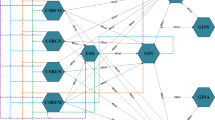
Toward a new understanding of environmental and financial performance through corporate social responsibility, green innovation, and sustainable development
Muddassar Sarfraz, Ilhan Ozturk, … Heesup Han

Who’s in and who’s out? Reading stakeholders and priority issues from sustainability reports in Turkey
Sibel Hoştut, Seçil Deren van het Hof, … Gülten Adalı

Assessments of the environmental performance of global companies need to account for company size
Rossana Mastrandrea, Rob ter Burg, … Franco Ruzzenenti
Introduction
The discussion surrounding the Environmental, Social, and Governance (ESG) criteria and corporate sustainability has gained significant momentum in recent years, primarily driven by the evolving societal expectations regarding new models of production and consumption (Nishitani et al., 2021 ). Until the mid-1990s, according to Clarkson ( 1995 ), the focus of companies’ success was primarily centered on satisfying the needs of a single stakeholder, namely the shareholder. However, as time passed and the panorama shifted, particularly influenced by public policy changes, this perspective has undergone transformations. Gradually, other stakeholders have exerted pressure on companies, resulting in the integration of corporate sustainability into the strategic management of organizations, leading them to practice the ESG criteria (Wang et al., 2018 ).
Corporate sustainability performance refers to a company’s ability to operate in a manner that upholds ecological integrity, social well-being, and sound governance principles, while simultaneously generating value for its shareholders (Ahmad et al., 2023 ; Luque-Vílchez et al., 2023 ). It encompasses the effective management of environmental resources, fostering positive social relationships, and maintaining high standards of ethical conduct (Bellandi, 2023 ). The assessment of corporate sustainability performance requires the evaluation of both qualitative and quantitative indicators, examining various dimensions such as environmental stewardship, social responsibility, and corporate governance (Sandberg et al., 2022 ).
ESG criteria are used to assess corporate sustainability and ethical performance of companies and investments (Arora and Sharma, 2022 ). They are adopted by corporations to monitor and control the impacts of business activities on internal and external environments (Viranda et al., 2020 ). They mainly include: (i) collecting information; (ii) developing solutions; (iii) dealing with ESG issues in compliance with standards; (iv) conducting training; and (v) providing good communication (Boiral, 2002 ; Montabon et al., 2007 ; Merli and Preziosi, 2018 ). ESG criteria include prevention and preservation performance indicators (Gond et al., 2012 ). Besides, it requires coordination between the environmental department and other departments within companies, and balance between sustainable development goals and other corporate goals.
ESG criteria incorporates environmental, social, and governance factors into investment and business decision-making processes, and involves conditions relevant to traditional financial metrics when analyzing investments or valuing companies (Madden, 2022 ). These conditions can include metrics such as carbon emissions, water usage, employee diversity, labor practices, board diversity, executive compensation, etc. Thus, ESG criteria provide quantitative and qualitative information about a company’s sustainability practices and their potential impact on various stakeholders (Khalil et al., 2022 ; Uyar et al., 2023 ).
ESG integration involves incorporating environmental, social and governance indicators into investment and business decision-making processes. Instead of considering ESG criteria as separate from financial analysis, integration recognizes their materiality and incorporates them alongside traditional financial analysis. This integration can happen at various stages of the investment process, including portfolio construction, risk assessment, due diligence, and ongoing monitoring. Integration aims to identify and manage risks and opportunities related to ESG criteria, ultimately seeking to enhance long-term investment performance and sustainability (Gebhardt et al., 2022 ; Harasheh and Provasi, 2023 ).
ESG criteria provide the data and metrics to assess a company’s sustainability and ethical performance, while the integration involves incorporating these criteria into investment and business decision-making processes to better understand and manage the potential impacts on financial performance and corporate sustainability (Alda, 2021 ; Sahoo and Kumar, 2022 ).
In this sense, the integration of the ESG criteria has become an instrument responsible for defining, planning, operationalizing and executing the actions of corporations directed at environmental prevention and preservation, in addition to social responsibility and the quality performance of their activities (Barbosa et al., 2021 ).
Both from the standpoint of Sustainable Development Goals and the company response to shifting consumer preferences, interest in corporate sustainability has been increasing importance (Boulhaga et al., 2022 ). When looking for the relationship between the implementation of the ESG criteria and the corporate sustainability, the literature presents a heterogeneous scenario. Some researchers advocate a positive relationship (Harymawan et al., 2022 ; Kim et al., 2022 ), and others have confirmed a negative relationship (Rajesh and Rajendran, 2020 ).
As is the case with research by Lee and Isa ( 2022 ), they find a positive relationship between the implementation of ESG criteria and financial performance, suggesting that ESG criteria can increase company value. In addition, the authors also find evidence that the disclosure of ESG criteria can improve the relationship with corporate sustainability performance. Already in the study by Xu et al. ( 2022 ), the heterogeneity analysis demonstrates that the negative relationship between ESG disclosure and the risk of falling stock prices is more significant in state-owned companies, companies with higher agency costs and in companies in the development phase.
Although the results are ambiguous, there are several positive examples of the relationship between the ESG criteria and the corporate sustainability, which influences the reasons why research on sustainable business models has been carried out and why organizations are changing their business model in the direction of sustainability. Additionally, there is a lot of pressure to consider ESG factors when making decisions, particularly from capital investors and financial institutions (Jonsdottir et al., 2022 ; Park and Oh, 2022 ).
Organizations responding to the pressure to implement ESG criteria must manage environmental, social, and economic risks (Triple Bottom Line) and understand their short, medium, and long-term impacts (Bravi et al., 2020 ). To this end, many companies adopt management systems related to ESG criteria to integrate elements of the Triple Bottom Line, address stakeholder needs, and mitigate risks (Esquer-Peralta et al., 2008 ).
Thus, the ESG criteria cannot be seen only as a cost, since they can bring benefits to the company and be a competitive advantage over competitors (Barbosa et al., 2023 ; Zhang et al., 2021 ).
That said, the need for an innovative and coherent research field focused on ESG issues increases as environmental, social, and governance problems intensifies (Vanderley, 2020 ).
The literature has already discussed the research situation, qualitatively and quantitatively, regarding ESG criteria through the prism of corporations, usually in the context of trying to improve the field’s problem-solving ability in relation to companies’ concerns and practices. Baumgartner and Rauter’s ( 2017 ) research addresses the strategic perspectives of corporate sustainability management to develop sustainable organizations and promote the integration of ESG criteria into business activities and techniques.
This narrow interpretation is criticized by several scholars as being insufficiently analytical, as well as lacking a rigorous appreciation of the historical basis of human-environment interaction, highlighting worker perception (Bryant and Wilson, 1998 ; Herghiligiu et al., 2019 ).
Existing research on ESG criteria primarily focuses on the corporate perspective (Bourcet, 2020 ; Khanchel et al., 2023 ; Tsang et al., 2023 ). However, this literature review did not identify any references that support the worker’s perspective or address their involvement in organizational management, as highlighted by Ouni et al. ( 2020 ).
Therefore, this study aims to map and analyze the literature on the impacts of integrating ESG criteria on corporate sustainability performance through different points of view. The research will employ both qualitative and quantitative analysis and consider the viewpoints of both employers and employees. This study aims to fill the existing gap in the literature, as no significant research has yet converged in this direction.
As is the case with the research of Huang ( 2021 ), who conducted a systematic literature review (SLR) to examine the link between ESG activities and organizational financial performance, focusing on the institutional aspect. Similarly, Taliento et al. ( 2019 ), who investigated the impact of ESG factors on economic performance, emphasizing the corporate sustainability advantage and business understanding.
This research holds significance due to the growing global efforts to establish ESG criteria and mitigate environmental, social, and economic risks (Triple Bottom Line) for sustainable development. It aims to comprehend how these risks can affect sustainable development in the short, medium, and long-term, considering both organizational and collaborative perspectives (workers) (Bravi et al., 2020 ).
In this sense, the main objective of this paper is to map and analyze the literature on the impacts of integrating ESG criteria on corporate sustainability performance through different points of view. To achieve the proposed objective, the investigation addressed the following research questions:
What are the main features of the literature on ESG criteria?
What are the main methodological approaches used to study ESG criteria impact on corporate sustainability?
What are the main impacts of integrating ESG criteria on corporate sustainability performance observed in the literature?
This paper is divided into six sections, including this introduction (section 1). Section “Theoretical backgrounds: Environmental, Social, and Governance (ESG) criteria” refers to the theoretical foundation on the ESG criteria and the construction of the research hypotheses. Subsequently, in section “Methodological procedures”, the methodological procedures of the research are discussed. In section “Results”, the results are developed. Then, in section “Discussion”, a discussion is carried out. And, finally, in section “Conclusion”, the research conclusions are highlighted.
Theoretical backgrounds: Environmental, Social, and Governance (ESG) criteria
The ESG criteria are about the set of organizational practices that considers in its context environmental, social, and governance factors, with a view to achieving long-term sustainability (Sultana et al., 2018 ). The proportionality of these three aspects in business management has the purpose of analyzing the operations in a holistic way, not limited merely to the economic and financial aspects (Cek and Eyupoglu, 2020 ). In this sense, the economic, transparency and ethical precepts are articulated, seeking to ensure the competitiveness and the perdurability of a company. (Oncioiu et al., 2020 ).
The environmental dimension involves assessing the corporation’s carbon footprint, natural resource usage (energy consumption and efficiency), recycling policies, waste management, and efforts to minimize environmental impacts (Rajesh, 2020 ). The social dimension encompasses the company’s relationships with employees, suppliers, partners, clients, and communities. It includes promoting diversity, non-discrimination, gender pay equality, equal opportunities, employee education, and community protection (Li and Wu, 2020 ). The governance dimension focuses on leadership, internal controls, executive compensation, audits, shareholder rights, anti-corruption policies, and transparency and accountability practices (Cek and Eyupoglu, 2020 ).
ESG criteria, also known as sustainable or socially responsible investments, assist investors in assessing companies’ initiatives and commitment to environmental, social, and governance issues. These criteria can be applied internally or externally in a company’s management (Du Rietz, 2018 ).
That said, compliance with ESG policies and practices is increasingly important to investors, employees, and customers, shaping company perception and performance evaluation beyond financial measures (Beretta et al., 2019 ).
While ESG indicators may vary by region, market, and industry, there are emerging best practices in the corporate world (Khalid et al., 2021 ). Thus, an example of ESG practices can be observed through the Principles for Responsible Investment (PRI), created by initiative of investors in partnership with the United Nations Environment Program Finance Initiative (UNEP FI) and the UN Global Compact, with the aim of guiding the market in the pursuit of responsible development (Bauckloh et al., 2021 ; Naffa and Fain, 2020 ).
Therefore, one way to find out whether a particular organization is sustainable is to evaluate its performance by ESG indexes. However, these indexes have limitations as they may not capture the multidimensional aspects of ESG criteria comprehensively. Consequently, a broader focus on ESG criteria is needed, considering corporate sustainability performance.
Methodological procedures
There are distinct alternatives that can be appreciated in the deployment of a SLR, comprising a bibliometric approach, meta-analysis (Hunter et al., 1986 ) and content analysis approaches. (White and McCain, 1998 ). These three techniques were applied in the present study. The scope of this study provides qualitative and quantitative analysis of publications, in the synthesis and assimilation of the most explored academic research and authors with the support of citation analysis, as well as in the critical analysis of the sample of articles collected.
To address the research aims, which is to map and analyze the literature on the impacts on corporate sustainability performance provided by the integration of ESG criteria, this study relied on two procedures. The first procedure was a consistent and robust SLR materialized according to the Preferred Reporting Items for Systematic Reviews and Meta-analysis (PRISMA) methodology, which blends reference analysis, network analysis, and content analysis. The second method was a critical in-depth analysis of a specific sample of articles collected through the PRISMA structured procedure, which integrated and supported the initial technique, as already used in the sustainability literature (Bolis et al., 2014 ).
Primary procedure: PRISMA methodology
The PRISMA methodology is a directive that aims to provide scholars to improve the peculiarity of the externalization of research information, as well as to guide in the critical conjecture of a review of articles already published (Page et al., 2021 ).
Eligibility and ineligibility criteria
The documents eligible for the sample of this research were those published in the last 5 years (period from 2017 to March 2022); belonging to the study domain of environmental, social and governance areas (research area); considered exclusively as research articles (document type); disseminated only in scientific journals (journals ); written only in English language (language); and intrinsic to the topic of this research. The ineligible studies were those without a well-defined scientific structure, those without relevant data implicated in the theme of this research, those without access to the text ( in press ), and those that did not propose quantitative analysis (as this is a relevant point for future research).
Selection of the scientific databases
As a basis for this SLR and starting to answer the questions listed to achieve the objective of this study, the initial sample of articles followed systematic strategies that were adopted to consult the bibliometric databases until March 2022. Three scientific knowledge bases, Scopus , Web of Science ( WoS ), and Science Direct ( SD ) were used in to identify studies related to the ESG criteria.
The level of quality, the number of publications, the area of knowledge, and the set of metadata essential for the analysis of the references (including titles, abstracts, keywords, year of publication, number of citations, list of authors, countries, among others) were the criteria of choice for these 3 scientific databases. Scopus is one of the largest scientific knowledge bases of peer-reviewed literature (Morioka and de Carvalho, 2016 ). WoS can cover all indexed journals with an impact factor calculated in JCR ( Journal Citation Report ) (Carvalho et al., 2013 ). And SD combines reliable full-text publications in the scientific, technical and health fields (Direct, 2020 ). Another factor also considered was that all 3 databases provide metadata compatible with Mendeley reference analysis software (Carvalho et al., 2013 ).
Sampling procedure
The sampling procedure used to screen the articles was search by search terms, which were adapted for each defined bibliographic database. This was performed in March 2022. The keyword terms for the investigation were applied as follows: ("Environmental, Social, and Governance") AND (Impact* OR Effect* OR Performanc* OR Integrat*) AND (Sustainab*).
The initial searches are shown in Table 1 .
The first triage was applied as " Article title, Abstract, Keywords " in Scopus , as " Topic " in WoS and as " Title, abstract or author-specified keywords " in SD resulting in 5,760 collected documents ("Initial Sample"). Then, the primary parameter for refining the references was run as " Publication Years ", reducing the number of records by 1,152 documents. The secondary elimination criterion was applied as " Topic Area ", synthesizing the sample into 580 searches.
Continuing with the exclusion process, the third suppression factor was submitted as " Document Type ", summarizing the records into 486 studies. Subsequently, "Source Type" was used as the fourth parameter of reference reduction, reducing the records by 3 documents. Subsequently, the penultimate refinement requirement was performed as " Language ", subtracting 9 more references. Finally, the reading of the titles and abstracts of the articles was used as the sixth ground for the refinement of the sample as " Off Topic ", restricting to 3,172 documents that did not directly address the topic of this study. Thus, the quantity of rejected documents was 5,402 references, resulting in a sample of 358 research articles selected from the 3 scientific databases.
The references were then entered into Mendeley software to verify the intersections of studies between the databases. The triage identified 229 duplicate documents, which were excluded, reducing the sample to 129 articles. Subsequently, an isolated analysis of each of the 129 selected publications was performed to assess compatibility with the eligibility and ineligibility criteria focusing on the adequacy to the research premises and quality parameters related to the methodological peculiarity of the publications. This analysis resulted in an exclusion of 82 studies. The "Remaining Sample" became 47 research articles.
After rejecting studies that did not satisfy the "Initial Sample" pre-selection process, that were in duplicate, and that did not have the eligibility criteria, the snowball method was applied (Yin et al., 2020 ). The references were expanded to incorporate other studies that were cited in the 47 articles in the "Remaining Sample". The total number of records selected through the snowball technique was 2 studies ("Additional Sample"). The inclusion of the additional articles followed the same eligibility (except for the year of publication) and ineligibility criteria cited in section “Eligibility and ineligibility criteria”. Thus, the "Final Sample" for the conduct of this SLR was 49 research articles.
Reference analysis
Data tabulation and grouping strategies directed the stratification of information and a narrative synopsis. A spreadsheet ( Microsoft Excel 2021) and Mendeley software were used to manage the selected articles to transcribe predominant methodological minutiae of each research study comprising the assessment instrument used, the setting, participants, and substantive findings in terms of validity and credibility. The number of publications summarized by year and journal was the initial parameter of the reference analysis process. This resource made it possible to see how the records succeeded over the years and to discriminate the journals that repeatedly dealt with the theme of this research.
Network analysis
In this step, with the assistance of the VOSviewer software , the network analysis was performed, considering the compatibility of keywords and authors were analyzed through clustering diagrams. The first citation network developed was that of most relevant keywords. The second network developed was that of co-citations, which shows the degree of equivalence between the references presenting the articles mentioned together. The analysis of this network can help assimilate the intellectual character of a field and map the thematic similarities of scholars and the aspect of how groups of researchers relate to each other (Pilkington and Liston-Heyes, 1999 ).
Another analysis performed was on the methodological approaches applied among the studies. For this diagnosis, a deductive multivariate approach was applied based on the theoretical foundation and knowledge from the references. This analysis used insights extracted from the keywords and the analysis of important topics.
Content analysis
Each article included in the final sample was specifically cataloged using Mendeley software that comprised the metadata generated by scientific databases. For the content analysis, the articles were classified in order to consider the tools applied, the scope of application, the relevant industries, the research objectives, and the advantages and limitations of the process required to obtain the research results.
Secondary procedure: critical (interpretative) analysis
Critical analysis is a research skill outlined to contribute to the interpretation of complex issues to understand specific conjunctures (Gil-Guirado et al., 2021 ). Critical analysis involves multiple iterative cycles of interpreting and perceiving the content of parts of the phenomena of interest, and this assimilation of the parts entails a better understanding of the contexts as a whole (Valor et al., 2018 ).
To deepen the assimilation of the contexts, each researcher involved forms an understanding of their perspective in continuous cycles until a "cognitive fusion" is achieved resulting in a better conception of the phenomena. This approach does not aim to construct a theory, but rather to infer a better understanding of the contexts (Bolis et al., 2014 ). Thus, to complement the answers to the questions of this research, critical analysis was applied, which involved dialectical reasoning cycles to identify the understanding (systematization of applicable processes to determine the meaning and scope of methodologies) of researchers on the impacts of integrating ESG criteria on corporate sustainability performance with the aim of finding the "cognitive fusion".
The initial cycle demanded a series of reviews, syntheses, and interpretations of the sample of articles collected in the structured procedure (PRISMA). In the next cycle, the collaborative critical process was adhered to, resulting in the refinement of the main methodological characteristics fragmented by each ESG criterion. Later, in the final interpretive cycle, the procedures of the first two cycles were analyzed, which provided additional perspectives and insights that complemented the previous interpretations.
Risk of bias
To assess the methodological quality of the included articles, the Prediction Study Trend Risk Assessment Tool (PROBAST) was used. (Wolff et al., 2019 ). This tool includes 20 questions divided into four domains (participants, predictors, outcome, and analysis). The risk of bias for each domain was rated as low risk, high risk, or very unclear to judgment (Wolff et al., 2019 ). Two researchers of the present study independently assessed the risk of bias of the included articles and performed an evaluation by qualitative analysis. Disagreements were resolved by consensus with a third reviewer.
The document collection strategy yielded 129 records, and after screening titles and abstracts and applying eligibility and ineligibility criteria, 49 articles were selected for this systematic literature review (SLR). Please refer to Fig. 1 for the SLR flow diagram.
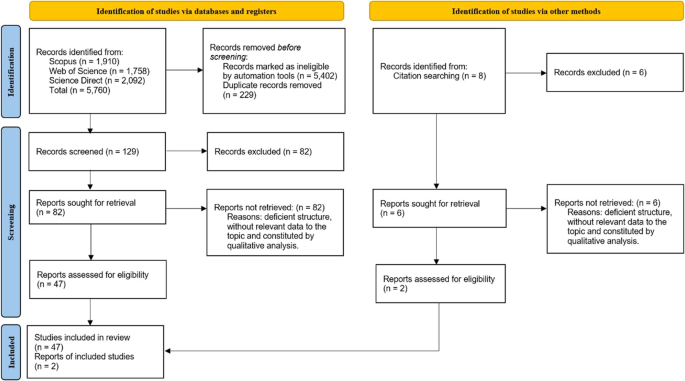
Source: Adapted from Page et al. ( 2021 ).
Consistent with Nishitani et al.’s ( 2021 ) assertion, Fig. 2 demonstrates the contemporary nature of discussions on ESG criteria and corporate sustainability, indicating their recent consolidation. In this specific context, the eligibility and ineligibility criteria of the articles were disregarded, and only a keyword search for "Environmental, Social, and Governance" was conducted across three databases. This was solely done to quantify the research related to the theme.
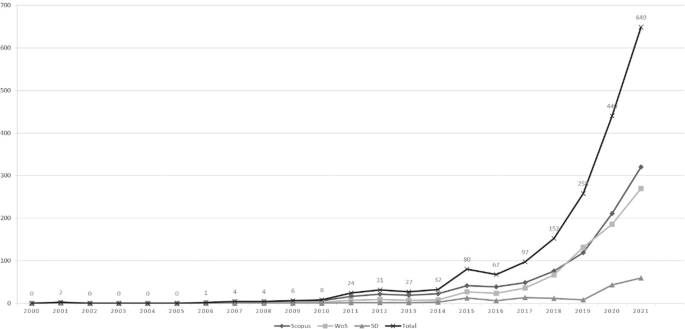
Source: Scopus , WoS , and SD .
It is evident that there has been an increasing number of studies focused on ESG criteria over the years, with a peak of 649 research articles in 2021 (an average of 54 articles per month). This trend aligns with the growing interest of organizations in implementing ESG criteria (Qureshi et al., 2021 ).
Literature overview
Starting to answer the first research question ( What are the main characteristics of the literature on ESG criteria? ), an overview of the literature was conducted based on descriptive statistics of the sample of 49 selected articles. Table 2 presents the most influential studies. It lists the publications with 20 or more citations in the Scopus database.
The study that stood out the most was that of Xie et al. ( 2019 ), which investigates whether environmental, social, and governance activities improve corporate financial performance, with 115 citations over 3 years, an average of 38 citations/year; followed by the respective research of Garcia et al. ( 2017 ), which highlights the sensitive emerging market sectors in relation to improved ESG performance, published in the year 2017 and has 104 citations; and by Qureshi et al. ( 2020 ), which analyzes the moderating role of the impact of sustainability disclosure and board diversity on firm value, with 41 citations in 2 year, both averaging approximately 21 citations per year.
The articles of the core sample were designated from the network analysis of keywords, a quantitative technique practiced to identify the repercussion and expressiveness of an author or an article (Garfield and Morman, 1981 ). Nevertheless, this methodology should also take into account the relevance of the journal, besides computing the average annual citation (Carvalho et al., 2013 ), as shown in Table 2 .
That said, Fig. 3 shows, through the network analysis of the VOSviewer software , the relationship between the keywords and the articles in the designated sample, with recurrences of at least 2 times (this implies that terms that appear only once were not displayed). Other points to be observed are that the more consistent (full-bodied) the meshes the stronger the connections and the larger the points (nodes) of connections the more relevance they have.
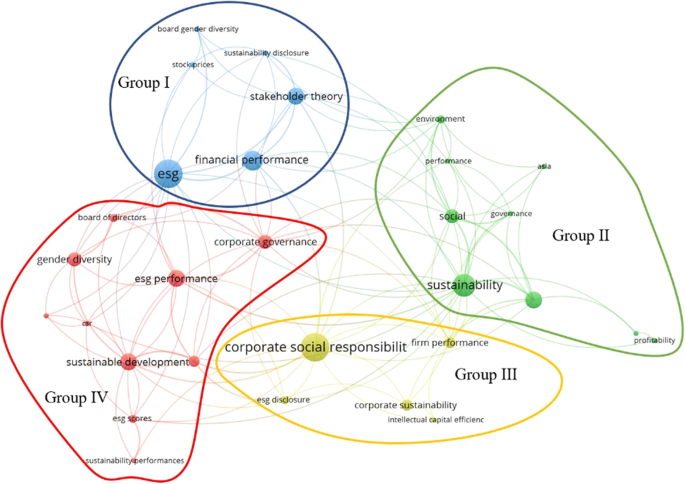
Source: Scopus, WoS , and SD .
Network analysis enables a better explanation of the consonance between the terms discovered, as well as simplifying the differentiation between the groupings literally associated with its operating principles.
There were 4 sets of keywords identified. Of the 4 sets of the keyword network analysis, 3 contain the term " ESG " and its variations. In the case of the terms " sustainability and performance ", all 4 clusters register their presence. This demonstrates that the search terms adopted were assertive, since it can be seen that they adhere to the proposed theme.
The research by Zhang et al. ( 2020 ), which discusses how ESG initiatives affect innovation performance for corporate sustainability; and the research of Xu et al. ( 2021 ), which examines the impacts of research and development (R&D) investment and ESG performance on green innovation performance; ratify the cited adherence.
Research topics: the main methodologies
The predominant impacts addressed in the sample of 49 scientific studies collected, classified by level of analysis and methodological interpellation, are evidenced in Table 3 , which already awakens the dissolution to the second research question ( What are the main methodological approaches used to study ESG criteria impact on corporate sustainability? ).
A content analysis of the full texts of the articles selected for this SLR was performed and it was found that approximately 87.75% of the studies (43 references) were conducted using information from companies through databases. Analyzes were quantitative, 46 studies, approximately 93.87%, applied regression analysis. Of these, 6 investigations, approximately 13.04%, implemented structural equation modeling. These results, corroborate the conjuncture that there is no evidence in the literature regarding research allusive to a mapping and quantitative analysis of the impacts of the integration of ESG criteria on corporate sustainability performance, from an employee’s perspective.
By Fig. 4 , it can be distinguished that the organizations’ commitment does not focus exclusively on financial performance (12 studies), but also prioritizes corporate sustainability (12 studies).
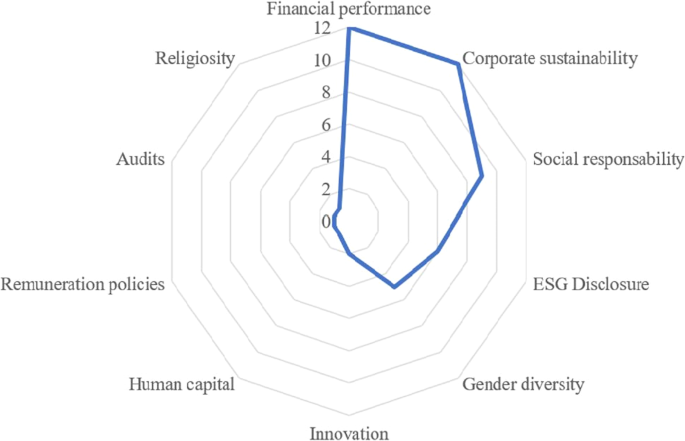
Financial performance and corporate sustainability were investigated in approximately 49% of the research (24 records), proving corporate concern for both sustainable development and economic performance. Landi et al. ( 2022 ), highlight this awareness in their investigation of the incorporation of sustainability into risk management and the impacts on financial performance. Taken together, these practices have the potential to minimize cost and risk, enhance the company’s reputation and legitimacy, intensify innovation, and solidify growth paths and trajectories, all of which are vitally important to stakeholder value creation. (Ting et al., 2020 ).
The corporate sustainability performance disclosed through the ESG criteria was investigated in an attempt to demonstrate the quality of an organization, because through environmental, social, and governance analysis, it is possible to determine how the company positions itself in relation to society and the planet, in addition to offering more transparency to the investor (Mohammad and Wasiuzzaman, 2021 ).
Figure 5 displays a broad view of the amount of research performed around the world according to the sample of articles selected for this SLR.
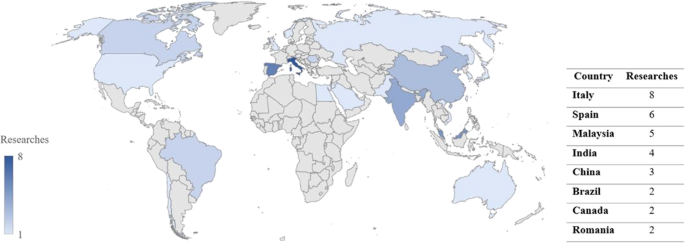
It can be seen that Europe stands out in the evolution of ESG criteria with approximately 32.65% of research, with the highest visibility for Italy and Spain. The research by Conca et al. ( 2021 ), on the impacts of ESG reports in European agri-food companies; and (Baraibar-Diez and Odriozola, 2019 ), related to the effects of ESG parameters on the social responsibility committees of European corporations, highlight the aforementioned evolutionary prominence.
Figure 6 displays the most often consulted databases to collect information about the ESG criteria of the listed companies for their corporate sustainability performance.

Source: Table 3 .
Thomson Reuters and Bloomberg databases stand out because they are providers of reliable answers that help organizations make confident decisions and better manage business (Alsayegh et al., 2020 ). This reinforces the fact that most studies use publicly available data to measure ESG, whether than collect the ESG criteria for the companies under investigation.
Critical analysis
Critical analysis is a method of study for understanding difficult and complex situations, especially when interpretations of the same articulation are possible and competing. It is a form of text analysis and has been handled to discover their original meanings and how they are interpreted (Shephard et al., 2019 ).
Thus, complementing the results of the primary approach (PRISMA method), a critical analysis was implemented based on the selection of 49 articles considered for discussion. The aim was to answer the third question of this research ( What are the main impacts of integrating ESG criteria on corporate sustainability performance observed in the literature? ). Table 4 shows the main perceptions of the fragmented research according to each of the ESG criteria.
The cycles of the critical analysis involved a series of reviews, syntheses, and interpretations of ESG criteria affecting corporate sustainability performance identified in the 49 selected articles corroborating the structured process of this SLR. The results are shown in Tables 3 and 4 , which summarize the focus of the research, the methodologies applied, and the main gaps, contributions, and limitations of the studies.
In this SLR, the need for future empirical studies was also identified. There are still several research questions that need to be answered in depth. Some propositions for future investigations and possible research questions are outlined in Table 5 .
Analyzing the risk of bias in scientific research is of paramount importance as it can significantly impact the validity and reliability of research findings. It helps ensure that research outcomes accurately reflect reality and can be trusted by other researchers, policymakers, and the public (McGuinness and Higgins, 2021 ). Reproducibility is a fundamental principle of scientific research and transparently analyzing bias allows researchers to identify potential pitfalls and enhance the reproducibility of their work. Ethical considerations are also important as biased research can lead to harm, perpetuate discrimination, or favor specific individuals or groups unjustly (Marshall et al., 2015 ). Analyzing bias helps to improve the quality of evidence available for decision-making processes and ensures that the scientific literature remains reliable, allowing researchers to build upon a solid foundation of unbiased evidence. By carefully evaluating and addressing bias, researchers can enhance the quality and impact of their work (Reveiz et al., 2015 ; Wang et al., 2022 ).
In accordance with Table 6 (PROBAST diagnostics), most (93.9%) of the included research evidenced a minimal risk of bias and a low concern for applicability. The participants were the companies selected in each study; the predictors were the variables measured; the results were verified by the mathematical models; and the analysis, encompass the techniques used. The quality of the studies included in this study was rated from satisfactory to excellent.
Drawing upon rigorous research, this paper elucidates the prominent features that have appeared from the examination of ESG criteria. Table 2 and Fig. 3 show the repercussion, expressiveness and relevance of studies, authors, and journals.
The content analysis highlighted in Table 3 found that the literature on ESG criteria were carried out with information from companies through databases and applied regression analysis. These findings support the idea that there is no evidence in the study literature that maps or quantifies the effects of incorporating ESG criteria on corporate sustainability performance from the viewpoint of employees.
Ouni et al. ( 2020 ), in their study on the mediating role of ESG strands in relation to executive board gender diversity and corporate financial performance, highlighted the need for future research that focuses not only on organizational understanding, but especially on the perception of women (workers) themselves, as board members, of their role and their contribution to financial performance, which strengthens the gap characterized in this SLR.
Researchers employ various methodologies to study ESG criteria, allowing for nuanced insights and robust analysis (see Table 3 ). Quantitative studies utilize large-scale data sets, statistical models, and financial indicators to explore the relationship between ESG criteria and financial performance, risk management, and firm valuation (Alkaraan et al., 2022 ; Mavlutova et al., 2022 ). Qualitative research methods employ interviews, case studies, and content analysis to investigate the organizational processes, stakeholder perceptions, and contextual factors that influence ESG practices and outcomes (Petavratzi et al., 2022 ). Some studies adopt an integrated approach by combining quantitative and qualitative methods to gain a comprehensive understanding of the multifaceted nature of ESG criteria. These integrated approaches contribute to a holistic understanding of ESG-related phenomena (Aldowaish et al., 2022 ; Rehman et al., 2021 ).
Recognizing the strengths and limitations of methodologies, researchers have increasingly adopted mixed-methods approaches to investigate the impact of ESG criteria on corporate sustainability, integrating data collection and analysis processes to provide a comprehensive understanding of the research problem (Gebhardt et al., 2022 ). This approach allows researchers to triangulate findings, validate results, and gain a more nuanced perspective on the relationship between ESG criteria and corporate sustainability (Harasheh and Provasi, 2023 ). By leveraging the strengths of methodologies, research offers a more holistic and robust approach to studying complex phenomena.
The positive relationship of voluntary disclosure of corporate sustainability through the ESG criteria of organizations found in this study (see Table 4 ) provides evidence that the implementation of environmental and social strategies within an efficient system of corporate governance in the company strengthens the performance of corporate sustainability. The results also show that environmental performance and social performance are significantly positively related to sustainable economic performance, indicating that the corporation’s economic value and the creation of value for society are interdependent.
A similar fact was also found in the investigation of Zhang et al. ( 2020 ), on environmental, social and governance initiatives that affect innovative performance for corporate sustainability, which revealed that corporate governance initiatives play a moderating role in the relationship between environmental initiatives and performance innovation and the relationship between social initiatives and innovative performance.
Shaikh ( 2021 ), in his study on ESG practices and solid performance, explains the importance of voluntary reporting of non-financial indicators and a company’s responsibility towards stakeholders, reflected in the corporation’s accounting performance.
Integrating ESG criteria into business practices can have potential negative impacts, although specific effects may vary depending on context and implementation. As shown by the investigations of Wasiuzzaman et al. ( 2022 ), which verifies the extent to which culture can affect the relationship between ESG disclosure and company performance, evidencing the negative impact on the profitability of energy companies; and of Suttipun and Yordudom ( 2022 ), which analyzes the extent, level and trend of ESG disclosure in companies in Thailand, to test the different levels between high and low profile industries, which found a negative impact of governance disclosure on market reaction . Another example is the research of Yu et al. ( 2020 ), about Greenwashing in ESG disclosures, which identified organizations’ manipulations of ESG disclosures to increase market value.
While these concerns exist, effectively integrating ESG criteria can drive long-term value creation, risk management and stakeholder confidence. Implementing robust ESG practices requires careful consideration, transparency, and ongoing evaluation to mitigate potential negative impacts and ensure sustainable results.
The main objective of this article is to map and analyze the literature concerning the impacts of the integration of ESG criteria on corporate sustainability performance. To this end, an SLR was performed using the PRISMA methodology, with the intention of selecting the most relevant articles.
Figure 2 revealed an increase in the number of publications on ESG criteria. In 2017, there were only 97 published papers. Already in 2021, this number expanded to 649 manuscripts, an evolution of approximately 570%.
The references were systematically appraised using a hybrid approach that combined literature review methodologies, including structured and objective techniques such as bibliometric analysis, network analysis, and content analysis, to identify key highlights and gaps in the literature related to the theme of this investigation; as well as subjective text interpretation technique (critical analysis), to robust the structured analysis.
This study assisted in diagnosing the methodologies addressed and narrowing the gaps in the literature in four ways. Initially, the article presents a bibliometric analysis with a perspective on ESG criteria and sustainability performance based on the sampling of 49 research studies outlining the main papers and journals (according to Table 2 ). Subsequently, with the aid of network analysis the main keywords were highlighted (see Fig. 3 ).
Next, based on an in-depth content analysis, the article presents the main study highlights, the focus of the research, and the stratification of methods (Table 3 ). Finally, the critical analysis is juxtaposed to consolidate the initial structured analysis (Table 4 ).
Several authors have discussed the topic addressed by this SLR, such as Lokuwaduge and Heenetigala ( 2017 ), who made an interpellation of the integration of ESG precepts for an organizational sustainable development. Another reference is the paper by Bouslah et al. ( 2013 ), which analyzed the ESG dimensions and corporate risks.
But there is no evidence, to the knowledge of the authors of this paper, in the sample selected for this SLR, of research on a mapping and quantitative analysis of the impacts of integrating of ESG criteria on corporate sustainability performance as a result of workers’ perceptions. The study points out the lack of more confirmatory research approaches applying a multidimensional perspective of workers, as the interest remains in the economic-environmental perspective from the organizations’ point of view. It was also found that none of the studies listed made use of other types of diagnostic instruments diverging from the databases.
That said, the absence of such evidence highlights a gap in the literature that suggests the need for new study initiatives to fill it.
In addition to the opportunities for future studies proposed in Table 5 , future researches could explore the developing standardized metrics, common metrics that are relevant across different sectors and geographies; the relationship between ESG and financial performance, mechanisms behind this relationship, such as the impacts of ESG criteria on customer loyalty or employee satisfaction; the impacts of ESG criteria on non-financial stakeholders, such as employees, customers, and communities; the role of technology in ESG, such as artificial intelligence and blockchain in ESG reporting and decision-making; and on emerging ESG issues, such as the impact of climate change on supply chains or the ethical considerations of artificial intelligence.
Therefore, it would be important to establish standards and parameters that allow companies to understand and evaluate ESG criteria. In this sense, the International Organization for Standardization (ISO) could develop a global standardization on ESG that defines parameters, guidelines, and criteria with quality indicators, in line with the ISO 9001 standard already recognized worldwide.
This exploratory work highlights as a contribution the aspect of guiding corporations in understanding how the integration of ESG criteria can positively impact corporate sustainability performance, providing investment optimization and better business planning.
Furthermore, some important conclusions related to the ESG criteria can be obtained. It was observed that companies, regardless of nationality, follow the guidelines of ESG criteria integration and such procedure brings many benefits, such as: improving the organization’s image with stakeholders; increasing the corporation’s competitiveness; promoting corporate sustainability; improving the conjuncture in relation to gender diversity; improving intellectual opportunities; among others.
This research has limitations related to the use of keyword search engines and the filters of the selected databases. The keyword groups are asked to be elaborated in diverse ways, so the combinatorial analysis of the groupings may bring different answers. The filters of the scientific databases have disparate search characteristics, which may cause divergences in the answers. Another limitation was the critical analysis that may have generated an interpretation bias. Nevertheless, the PROBAST method and the systematic multi-method approach applied (bibliometric, network analysis, and content analysis) helped to mitigate this limitation.
Data availability
Data sharing is not applicable to this research as no data were generated or analyzed.
Aboud A, Diab A (2019) The financial and market consequences of environmental, social and governance ratings: the implications of recent political volatility in Egypt. Sustain Account Manag Policy J 10:498–520. https://doi.org/10.1108/SAMPJ-06-2018-0167
Article Google Scholar
Ahmad H, Yaqub M, Lee SH (2023) Environmental-, social-, and governance-related factors for business investment and sustainability: a scientometric review of global trends. Environ Dev Sustain https://doi.org/10.1007/s10668-023-02921-x
Alda M (2021) The environmental, social, and governance (ESG) dimension of firms in which social responsible investment (SRI) and conventional pension funds invest: The mainstream SRI and the ESG inclusion. J Clean Prod 298:126812. https://doi.org/10.1016/j.jclepro.2021.126812
Aldowaish A, Kokuryo J, Almazyad O, Goi HC (2022) Environmental, social, and governance integration into the business model: literature review and research agenda. Sustain. 14. https://doi.org/10.3390/su14052959
Alkaraan F, Albitar K, Hussainey K, Venkatesh VG (2022) Corporate transformation toward Industry 4.0 and financial performance: the influence of environmental, social, and governance (ESG). Technol Forecast Soc Change 175:121423. https://doi.org/10.1016/j.techfore.2021.121423
Alsayegh MF, Rahman RA, Homayoun S (2020) Corporate economic, environmental, and social sustainability performance transformation through ESG disclosure. Sustain 12. https://doi.org/10.3390/su12093910
Arayssi M, Jizi M, Tabaja HH (2020) The impact of board composition on the level of ESG disclosures in GCC countries. Sustain Account Manag Policy J 11:137–161. https://doi.org/10.1108/SAMPJ-05-2018-0136
Arif M, Sajjad A, Farooq S, Abrar M, Joyo AS (2020) The impact of audit committee attributes on the quality and quantity of environmental, social and governance (ESG) disclosures. Corp Gov 21:497–514. https://doi.org/10.1108/CG-06-2020-0243
Arora A, Sharma D (2022) Do Environmental, Social and Governance (ESG) Performance Scores Reduce the Cost of Debt? Evidence from Indian firms. Australas Account Bus Financ J 16:4–18. https://doi.org/10.14453/aabfj.v16i5.02
Atan R, Alam MM, Said J, Zamri M (2018) The impacts of environmental, social, and governance factors on firm Performance: panel study of Malaysian companies. Manag Environ Qual An Int J https://doi.org/10.1108/MEQ-03-2017-0033
Baraibar-Diez E, Odriozola MD (2019) CSR committees and their effect on ESG performance in UK, France, Germany, and Spain. Sustain. 11. https://doi.org/10.3390/su11185077
Baraibar-Diez E, Odriozola MD, Fernández Sánchez JL (2019) Sustainable compensation policies and its effect on environmental, social, and governance scores. Corp Soc Responsib Environ Manag 26:1457–1472. https://doi.org/10.1002/csr.1760
Barbosa A de S, Bueno da Silva L, de Souza VF, Morioka SN(2021) Integrated management systems: their organizational impacts Total Qual Manag Bus Excell 33:794–817. https://doi.org/10.1080/14783363.2021.1893685
Barbosa A de S, Bueno da Silva L, Morioka SN, da Silva JMN, de Souza VF (2023). Integrated management systems and organizational performance: a multidimensional perspective. Total Qual Manag Bus Excell 1–39. https://doi.org/10.1080/14783363.2023.2181153
Bauckloh T, Schaltegger S, Utz S, Zeile S, Zwergel B (2021) Active first movers vs. late free-riders? An empirical analysis of UN PRI signatories’ commitment, J Bus Ethics https://doi.org/10.1007/s10551-021-04992-0
Baumgartner RJ, Rauter R (2017) Strategic perspectives of corporate sustainability management to develop a sustainable organization. J Clean Prod 140:81–92. https://doi.org/10.1016/j.jclepro.2016.04.146
Bellandi F (2023) Equilibrating financially sustainable growth and environmental, social, and governance sustainable growth. Eur Manag Rev 1–19. https://doi.org/10.1111/emre.12554
Beretta V, Demartini C, Trucco S (2019) Does environmental, social and governance performance influence intellectual capital disclosure tone in integrated reporting. ? J Intellect Cap 20:100–124. https://doi.org/10.1108/JIC-02-2018-0049
Birindelli G, Dell’Atti S, Iannuzzi AP, Savioli M (2018) Composition and activity of the board of directors: Impact on ESG performance in the banking system. Sustain 10:1–20. https://doi.org/10.3390/su10124699
Bodhanwala S, Bodhanwala R (2018) Does corporate sustainability impact firm profitability? Evidence from India. Manag Decis 56:1734–1747. https://doi.org/10.1108/MD-04-2017-0381
Boiral O (2002) Tacit knowledge and environmental management. Long Range Plann 35:291–317. https://doi.org/10.1016/S0024-6301(02)00047-X
Bolis I, Morioka SN, Sznelwar LI (2014) When sustainable development risks losing its meaning. Delimiting the concept with a comprehensive literature review and a conceptual model. J Clean Prod 83:7–20. https://doi.org/10.1016/j.jclepro.2014.06.041
Boulhaga M, Bouri A, Elamer AA, Ibrahim BA (2022) Environmental, social and governance ratings and firm performance: the moderating role of internal control quality. Corp Soc Responsib Environ Manag 1–12. https://doi.org/10.1002/csr.2343
Bourcet C (2020) Empirical determinants of renewable energy deployment: a systematic literature review. Energy Econ 85:104563. https://doi.org/10.1016/j.eneco.2019.104563
Bouslah K, Kryzanowski L, M’Zali B (2013) The impact of the dimensions of social performance on firm risk. J Bank Financ 37:1258–1273. https://doi.org/10.1016/j.jbankfin.2012.12.004
Bravi L, Santos G, Pagano A, Murmura F (2020) Environmental management system according to ISO 14001:2015 as a driver to sustainable development. Corp Soc Responsib Environ Manag 27:2599–2614. https://doi.org/10.1002/csr.1985
Bravo F, Reguera-Alvarado N (2019) Sustainable development disclosure: environmental, social, and governance reporting and gender diversity in the audit committee. Bus Strateg Environ 28:418–429. https://doi.org/10.1002/bse.2258
Bryant RL, Wilson GA (1998) Rethinking environmental management. Prog Hum Geogr 22:321–343. https://doi.org/10.1191/030913298672031592
Carvalho MM, Fleury A, Lopes AP (2013) An overview of the literature on technology roadmapping (TRM): Contributions and trends. Technol Forecast Soc Change 80:1418–1437. https://doi.org/10.1016/j.techfore.2012.11.008
Cek K, Eyupoglu S (2020) Does environmental, social and governance performance influence economic performance? J Bus Econ Manag 21:1165–1184. https://doi.org/10.3846/jbem.2020.12725
Clarkson ME (1995) A Stakeholder framework for analyzing and evaluating corporate social performance. Acad Manag Rev 20:92–117. https://doi.org/10.5465/amr.1995.9503271994
Conca L, Manta F, Morrone D, Toma P (2021) The impact of direct environmental, social, and governance reporting: empirical evidence in European-listed companies in the agri-food sector. Bus Strateg Environ 30:1080–1093. https://doi.org/10.1002/bse.2672
De Masi S, Słomka-Gołębiowska A, Becagli C, Paci A (2021) Toward sustainable corporate behavior: the effect of the critical mass of female directors on environmental, social, and governance disclosure. Bus Strateg Environ 30:1865–1878. https://doi.org/10.1002/bse.2721
Direct S (2020) Science direct advertisement. Clin Microbiol News 42:201. https://doi.org/10.1016/j.clinmicnews.2020.12.002
Du Rietz S (2018) Information vs knowledge: corporate accountability in environmental, social, and governance issues. Account Audit Account J 31:586–607. https://doi.org/10.1108/AAAJ-01-2013-1198
Esquer-Peralta J, Velazquez L, Munguia N (2008) Perceptions of core elements for sustainability management systems (SMS). Manag Decis 46:1027–1038. https://doi.org/10.1108/00251740810890195
Gangi F, Daniele LM, Varrone N, Vicentini F, Coscia M (2021) Equity mutual funds’ interest in the environmental, social and governance policies of target firms: does gender diversity in management teams matter? Corp Soc Responsib Environ Manag. 28:1018–1031. https://doi.org/10.1002/csr.2102
Garcia AS, Mendes-Da-Silva W, Orsato R (2017) Sensitive industries produce better ESG performance: evidence from emerging markets. J Clean Prod 150:135–147. https://doi.org/10.1016/j.jclepro.2017.02.180
Garcia AS, Orsato RJ (2020) Testing the institutional difference hypothesis: a study about environmental, social, governance, and financial performance. Bus Strateg Environ 29:3261–3272. https://doi.org/10.1002/bse.2570
Garfield E, Morman ET (1981) Citation indexing: its theory and application in science, technology, and humanities. Isis. https://doi.org/10.1086/352799
Gebhardt M, Thun TW, Seefloth M, Zülch H (2022) Managing sustainability—does the integration of environmental, social and governance key performance indicators in the internal management systems contribute to companies’ environmental, social and governance performance? Bus Strateg Environ 1–18. https://doi.org/10.1002/bse.3242
Gil-Guirado S, Cantos JO, Pérez-Morales A, Barriendos M (2021) The risk is in the detail: Historical cartography and a hermeneutic analysis of historical floods in the city of murcia. Geogr Res Lett 47:183–219. https://doi.org/10.18172/cig.4863
Gond JP, Grubnic S, Herzig C, Moon J (2012) Configuring management control systems: theorizing the integration of strategy and sustainability. Manag Account Res 23:205–223. https://doi.org/10.1016/j.mar.2012.06.003
Harasheh M, Provasi R (2023) A need for assurance: do internal control systems integrate environmental, social, and governance factors? Corp Soc Responsib Environ Manag 30:384–401. https://doi.org/10.1002/csr.2361
Harymawan I, Nasih M, Agustia D, Putra FKG, Djajadikerta HG (2022) Investment efficiency and environmental, social, and governance reporting: Perspective from corporate integration management. Corp Soc Responsib Environ Manag 29:1186–1202. https://doi.org/10.1002/csr.2263
He R, Chen X, Chen C, Zhai J, Cui L (2021) Environmental, social, and governance incidents and bank loan contracts. Sustain 13:1–19. https://doi.org/10.3390/su13041885
Herghiligiu IV, Robu IB, Pislaru M, Vilcu A, Asandului AL, Avasilcai S, Balan C (2019) Sustainable environmental management system integration and business performance: a balance assessment approach using fuzzy logic. Sustain. 11. https://doi.org/10.3390/su11195311
Huang DZX (2021) Environmental, social and governance (ESG) activity and firm performance: a review and consolidation. Account Financ 61:335–360. https://doi.org/10.1111/acfi.12569
Hunter JE, Schmidt FL, Jackson GB (1986) Meta-analysis: cumulating research findings across studies. Educ Res 15:20–21. https://doi.org/10.3102/0013189X015008020
Jonsdottir B, Sigurjonsson TO, Johannsdottir L, Wendt S (2022) Barriers to using ESG data for investment decisions. Sustain 14:1–14. https://doi.org/10.3390/su14095157
Khalid F, Sun J, Huang G, Su CY (2021) Environmental, social and governance performance of chinese multinationals: a comparison of state-and non-state-owned enterprises. Sustain. 13. https://doi.org/10.3390/su13074020
Khalil MA, Khalil R, Khalil MK (2022) Environmental, social and governance (ESG)—augmented investments in innovation and firms’ value: a fixed-effects panel regression of Asian economies. China Financ Rev Int https://doi.org/10.1108/CFRI-05-2022-0067
Khanchel I, Lassoued N, Baccar I (2023) Sustainability and firm performance: the role of environmental, social and governance disclosure and green innovation. Manag Decis https://doi.org/10.1108/MD-09-2021-1252
Kim J, Cho E, Okafor CE, Choi D (2022) Does environmental, social, and governance drive the sustainability of multinational corporation’s subsidiaries? Evidence from Korea. Front Psychol 13:1–13. https://doi.org/10.3389/fpsyg.2022.899936
Koroleva E, Baggieri M, Nalwanga S (2020) Company performance: are environmental, social, and governance factors important? Int J Technol 11:1468–1477. https://doi.org/10.14716/ijtech.v11i8.4527
Kuo TC, Chen HM, Meng HM (2021) Do corporate social responsibility practices improve financial performance? A case study of airline companies. J. Clean. Prod. 310:127380. https://doi.org/10.1016/j.jclepro.2021.127380
Landi GC, Iandolo F, Renzi A, Rey A (2022) Embedding sustainability in risk management: The impact of environmental, social, and governance ratings on corporate financial risk. Corp Soc Responsib Environ Manag https://doi.org/10.1002/csr.2256
Lee S-P, Isa M (2022) Environmental, social and governance (ESG) practices and financial performance of Shariah-compliant companies in Malaysia. J Islam Account Bus Res https://doi.org/10.1108/JIABR-06-2020-0183
Li J, Wu D (2020) Do corporate social responsibility engagements lead to real environmental, social, and governance impact? Manage Sci 66:2564–2588. https://doi.org/10.1287/mnsc.2019.3324
Lokuwaduge CSDS, Heenetigala K (2017) Integrating environmental, social and governance (ESG) disclosure for a sustainable development: an Australian study. Bus Strateg Environ 26:438–450. https://doi.org/10.1002/bse.1927
López-Toro A, Sánchez-Teba EM, Benítez-Márquez MD, Rodríguez-Fernández M (2021) Influence of ESGC indicators on financial performance of listed pharmaceutical companies alberto. Int J Environ Res Public Health 18. https://doi.org/10.3390/ijerph18094556
Luque-Vílchez M, Gómez-Limón JA, Guerrero-Baena MD, Rodríguez-Gutiérrez P (2023) Deconstructing corporate environmental, social, and governance performance: heterogeneous stakeholder preferences in the food industry. Sustain Dev 1–16. https://doi.org/10.1002/sd.2488
Madden BJ (2022) Bet on innovation, not environmental, social and governance metrics, to lead the Net Zero transition. Syst Res Behav Sci 417–428. https://doi.org/10.1002/sres.2915
Marshall IJ, Kuiper J, Wallace BC (2015) Automating risk of bias assessment for clinical trials. IEEE J Biomed Heal Informatics 19:1406–1412. https://doi.org/10.1109/JBHI.2015.2431314
Mavlutova I, Fomins A, Spilbergs A, Atstaja D, Brizga J (2022) Opportunities to increase financial well-being by investing in environmental, social and governance with respect to improving financial literacy under covid-19: the case of Latvia. Sustain. 14. https://doi.org/10.3390/su14010339
McGuinness LA, Higgins JPT (2021) Risk-of-bias VISualization (robvis): an R package and Shiny web app for visualizing risk-of-bias assessments. Res Synth Methods 12:55–61. https://doi.org/10.1002/jrsm.1411
Article PubMed Google Scholar
Merli R, Preziosi M (2018) The EMAS impasse: factors influencing Italian organizations to withdraw or renew the registration. J Clean Prod 172:4532–4543. https://doi.org/10.1016/j.jclepro.2017.11.031
Minutolo MC, Kristjanpoller WD, Stakeley J (2019) Exploring environmental, social, and governance disclosure effects on the S&P 500 financial performance. Bus Strateg Environ 28:1083–1095. https://doi.org/10.1002/bse.2303
Miralles-Quirós MM, Miralles-Quirós JL, Redondo-Hernández J (2019) The impact of environmental, social, and governance performance on stock prices: evidence from the banking industry. Corp Soc Responsib Environ Manag 26:1446–1456. https://doi.org/10.1002/csr.1759
Mohammad WMW, Wasiuzzaman S (2021) Environmental, Social and Governance (ESG) disclosure, competitive advantage and performance of firms in Malaysia. Clean Environ Syst 2:100015. https://doi.org/10.1016/j.cesys.2021.100015
Moneva JM, Bonilla-Priego MJ, Ortas E (2020) Corporate social responsibility and organisational performance in the tourism sector. J Sustain Tour 28:853–872. https://doi.org/10.1080/09669582.2019.1707838
Montabon F, Sroufe R, Narasimhan R (2007) An examination of corporate reporting, environmental management practices and firm performance. J Oper Manag 25:998–1014. https://doi.org/10.1016/j.jom.2006.10.003
Morioka SN, de Carvalho MM (2016) A systematic literature review towards a conceptual framework for integrating sustainability performance into business. J Clean Prod 136:134–146. https://doi.org/10.1016/j.jclepro.2016.01.104
Naffa H, Fain M (2020) Performance measurement of ESG-themed megatrend investments in global equity markets using pure factor portfolios methodology, PLoS ONE. https://doi.org/10.1371/journal.pone.0244225
Ng TH, Lye CT, Chan KH, Lim YZ, Lim YS (2020) Sustainability in Asia: the roles of financial development in environmental, social and governance (ESG) performance. Soc Indic Res 150:17–44. https://doi.org/10.1007/s11205-020-02288-w
Nishitani K, Nguyen TBH, Trinh TQ, Wu Q, Kokubu K (2021) Are corporate environmental activities to meet sustainable development goals (SDGs) simply greenwashing? An empirical study of environmental management control systems in Vietnamese companies from the stakeholder management perspective. J Environ Manage 296. https://doi.org/10.1016/j.jenvman.2021.113364
Nitescu DC, Cristea MA (2020) Environmental, social and governance risks-New challenges for the banking business sustainability. Amfiteatru Econ 22:692–706. https://doi.org/10.24818/EA/2020/55/692
Oncioiu I, Popescu DM, Aviana AE, Şerban A, Rotaru F, Petrescu M, Marin-Pantelescu A (2020) The role of environmental, social, and governance disclosure in financial transparency. Sustain 12:1–16. https://doi.org/10.3390/SU12176757
Ortas E, Gallego-Álvarez I, Álvarez I (2019) National institutions, stakeholder engagement, and firms’ environmental, social, and governance performance. Corp Soc Responsib Environ Manag 26:598–611. https://doi.org/10.1002/csr.1706
Ouni Z, Mansour JB, Arfaoui S (2020) Board/executive gender diversity and firm financial performance in Canada: the mediating role of environmental, social, and governance (ESG) orientation. Sustain 12:1–17. https://doi.org/10.3390/su12208386
Page MJ, McKenzie JE, Bossuyt PM, Boutron I, Hoffmann TC, Mulrow CD, Shamseer L, Tetzlaff JM, Akl EA, Brennan SE, Chou R, Glanville J, Grimshaw JM, Hróbjartsson A, Lalu MM, Li T, Loder EW, Mayo-Wilson E, McDonald S, McGuinness LA, Stewart LA, Thomas J, Tricco AC, Welch VA, Whiting P, Moher D (2021) The PRISMA 2020 statement: an updated guideline for reporting systematic reviews. BMJ 372. https://doi.org/10.1136/bmj.n71
Park SR, Oh KS (2022) Integration of ESG information into individual investors’ corporate investment decisions: utilizing the UTAUT framework. Front Psychol 13. https://doi.org/10.3389/fpsyg.2022.899480
Peng LS, Isa M (2020) Environmental, social and governance (Esg) practices and performance in shariah firms: agency or stakeholder theory? Asian Acad Manag J Account Financ 16:1–34. https://doi.org/10.21315/aamjaf2020.16.1.1
Petavratzi E, Sanchez-Lopez D, Hughes A, Stacey J, Ford J, Butcher A (2022) The impacts of environmental, social and governance (ESG) issues in achieving sustainable lithium supply in the Lithium Triangle. Miner Econ 35:673–699. https://doi.org/10.1007/s13563-022-00332-4
Pilkington A, Liston-Heyes C (1999) Is production and operations management a discipline? A citation/co-citation study. Int J Oper Prod Manag 19:7–20. https://doi.org/10.1108/01443579910244188
Pirtea MG, Noja GG, Cristea M, Panait M (2021) Interplay between environmental, social and governance coordinates and the financial performance of agricultural companies. Agric Econ (Czech Republic) 67:479–490. https://doi.org/10.17221/286/2021-AGRICECON
Qureshi MA, Akbar M, Akbar A, Poulova P (2021) Do ESG endeavors assist firms in achieving superior financial performance? A case of 100 best corporate citizens. SAGE Open 11. https://doi.org/10.1177/21582440211021598
Qureshi MA, Kirkerud S, Theresa K, Ahsan T (2020) The impact of sustainability (environmental, social, and governance) disclosure and board diversity on firm value: the moderating role of industry sensitivity. Bus Strateg Environ 29:1199–1214. https://doi.org/10.1002/bse.2427
Rajesh R (2020) Exploring the sustainability performances of firms using environmental, social, and governance scores. J Clean Prod 247:119600. https://doi.org/10.1016/j.jclepro.2019.119600
Rajesh R, Rajendran C (2020) Relating environmental, social, and governance scores and sustainability performances of firms: an empirical analysis. Bus Strateg Environ 29:1247–1267. https://doi.org/10.1002/bse.2429
Reboredo JC, Sowaity SMA (2022) Environmental, social, and governance information disclosure and intellectual capital efficiency in jordanian listed firms. Sustain. 14. https://doi.org/10.3390/su14010115
Rehman RU, Abidin MZU, Ali R, Nor SM, Naseem MA, Hasan M, Ahmad MI (2021) The integration of conventional equity indices with environmental, social, and governance indices: Evidence from emerging economies. Sustain 13:1–27. https://doi.org/10.3390/su13020676
Reveiz L, Chapman E, Asial S, Munoz S, Bonfill X, Alonso-Coello P (2015) Risk of bias of randomized trials over time. J Clin Epidemiol 68:1036–1045. https://doi.org/10.1016/j.jclinepi.2014.06.001
Romano M, Cirillo A, Favino C, Netti A (2020) ESG (Environmental, social and governance) performance and board gender diversity: the moderating role of CEO duality. Sustain 12:1–16. https://doi.org/10.3390/su12219298
Sachin N, Rajesh R (2021) An empirical study of supply chain sustainability with financial performances of Indian firms. Environ Dev Sustain https://doi.org/10.1007/s10668-021-01717-1
Sahoo S, Kumar S (2022) Integration and volatility spillover among environmental, social and governance indices: evidence from BRICS countries. Glob Bus Rev 23:1280–1298. https://doi.org/10.1177/09721509221114699
Sandberg H, Alnoor A, Tiberius V (2022) Environmental, social, and governance ratings and financial performance: evidence from the European food industry. Bus Strateg Environ 2471–2489. https://doi.org/10.1002/bse.3259
Shahzad F, Baig MH, Rehman IU, Saeed A, Asim GA (2021) Does intellectual capital efficiency explain corporate social responsibility engagement-firm performance relationship? Evidence from environmental, social and governance performance of US listed firms. Borsa Istanbul Rev. https://doi.org/10.1016/j.bir.2021.05.003
Shaikh I (2021) Environmental, social, and governance (Esg) practice and firm performance: an international evidence. J Bus Econ Manag 23:218–237. https://doi.org/10.3846/jbem.2022.16202
Shakil MH (2021) Environmental, social and governance performance and financial risk: moderating role of ESG controversies and board gender diversity. Resour Policy 72:102144. https://doi.org/10.1016/j.resourpol.2021.102144
Shephard K, Rieckmann M, Barth M (2019) Seeking sustainability competence and capability in the ESD and HESD literature: an international philosophical hermeneutic analysis. Environ Educ Res 25:532–547. https://doi.org/10.1080/13504622.2018.1490947
Sul W, Lee Y (2020) Effects of corporate social responsibility for environmental, social, and governance sectors on firm value: a comparison between consumer and industrial goods companies. Eur J Int Manag 14:866–890. https://doi.org/10.1504/EJIM.2020.109817
Sultana S, Zulkifli N, Zainal D (2018) Environmental, social and governance (ESG) and investment decision in Bangladesh. Sustain 10:1–19. https://doi.org/10.3390/su10061831
Suttipun M, Yordudom T (2022) Impact of environmental, social and governance disclosures on market reaction: an evidence of Top50 companies listed from Thailand. J Financ Report Account 20:753–767. https://doi.org/10.1108/JFRA-12-2020-0377
Taliento M, Favino C, Netti A (2019) Impact of environmental, social, and governance information on economic performance: evidence of a corporate “sustainability advantage” from Europe. Sustain. 11. https://doi.org/10.3390/su11061738
Terzani S, Turzo T (2021) Religious social norms and corporate sustainability: The effect of religiosity on environmental, social, and governance disclosure. Corp Soc Responsib Environ Manag 28:485–496. https://doi.org/10.1002/csr.2063
Ting IWK, Azizan NA, Bhaskaran RK, Sukumaran SK (2020) Corporate social performance and firm performance: comparative study among developed and emerging market firms. Sustain. 12. https://doi.org/10.3390/SU12010026
Tsang YP, Fan Y, Feng ZP (2023) Bridging the gap: building environmental, social and governance capabilities in small and medium logistics companies. J Environ Manag 338:117758. https://doi.org/10.1016/j.jenvman.2023.117758
Article CAS Google Scholar
Uyar A, Kuzey C, Karaman AS (2023) Does aggressive environmental, social, and governance engagement trigger firm risk? The moderating role of executive compensation. J Clean Prod 398:136542. https://doi.org/10.1016/j.jclepro.2023.136542
Valor C, Antonetti P, Carrero I (2018) Stressful sustainability: a hermeneutic analysis. Eur J Mark 52:550–574. https://doi.org/10.1108/EJM-12-2016-0712
Vanderley LB (2020) Conscientização ambiental na implantação de um sistema de gestão ambiental: um estudo de caso em uma empresa do Polo Industrial de Manaus. Sist Gestão 14:335–347. https://doi.org/10.20985/1980-5160.2019.v14n4.1474
Viranda DF, Sari AD, Suryoputro MR, Setiawan N (2020) 5 S Implementation of SME Readiness in Meeting Environmental Management System Standards based on ISO 14001:2015 (Study Case: PT. ABC). IOP Conf Ser Mater Sci Eng 722. https://doi.org/10.1088/1757-899X/722/1/012072
Wang S, Li J, Zhao D (2018) Institutional pressures and environmental management practices: the moderating effects of environmental commitment and resource availability. Bus Strateg Environ 27:52–69. https://doi.org/10.1002/bse.1983
Wang Y, Ghadimi M, Wang Q, Hou L, Zeraatkar D, Iqbal A, Ho C, Yao L, Hu M, Ye Z, Couban R, Armijo-Olivo S, Bassler D, Briel M, Gluud LL, Glasziou P, Jackson R, Keitz SA, Letelier LM, Ravaud P, Schulz KF, Siemieniuk RAC, Brignardello-Petersen R, Guyatt GH (2022) Instruments assessing risk of bias of randomized trials frequently included items that are not addressing risk of bias issues. J Clin Epidemiol 152:218–225. https://doi.org/10.1016/j.jclinepi.2022.10.018
Wasiuzzaman S, Ibrahim SA, Kawi F (2022) Environmental, social and governance (ESG) disclosure and firm performance: does national culture matter? Meditari Account Res https://doi.org/10.1108/MEDAR-06-2021-1356
White HD, McCain KW (1998) Visualizing a discipline: an author co-citation analysis of information science, 1972–1995. J Am Soc Inf Sci 49:327–355
Google Scholar
Wolff RF, Moons KGM, Riley RD, Whiting PF, Westwood M, Collins GS, Reitsma JB, Kleijnen J, Mallett S (2019) PROBAST: a tool to assess the risk of bias and applicability of prediction model studies. Ann Intern Med 170:51–58. https://doi.org/10.7326/M18-1376
Xie J, Nozawa W, Yagi M, Fujii H, Managi S (2019) Do environmental, social, and governance activities improve corporate financial performance? Bus Strateg Environ 28:286–300. https://doi.org/10.1002/bse.2224
Xu J, Liu F, Shang Y (2021) R&D investment, ESG performance and green innovation performance: evidence from China. Kybernetes 50:737–756. https://doi.org/10.1108/K-12-2019-0793
Xu N, Liu J, Dou H (2022) Environmental, social, and governance information disclosure and stock price crash risk: evidence from Chinese listed companies. Front Psychol 13:1–15. https://doi.org/10.3389/fpsyg.2022.977369
Yin YN, Wang Y, Jiang NJ, Long DR (2020) Can case management improve cancer patients quality of life?: a systematic review following PRISMA. Medicine (Baltimore) 99:e22448. https://doi.org/10.1097/MD.0000000000022448
Yu EPY, Van Luu B, Chen CH (2020) Greenwashing in environmental, social and governance disclosures. Res Int Bus Financ 52:101192. https://doi.org/10.1016/j.ribaf.2020.101192
Zhang Q, Loh L, Wu W (2020) How do environmental, social and governance initiatives affect innovative performance for corporate sustainability? Sustain 12. https://doi.org/10.3390/SU12083380
Zhang Y, Ruan H, Tang G, Tong L (2021) Power of sustainable development: does environmental management system certification affect a firm’s access to finance? Bus Strateg Environ 1–17. https://doi.org/10.1002/bse.2839
Download references
Acknowledgements
The authors are grateful for the support received from the Federal University of Paraíba and the Federal Institute of Paraíba.
Author information
Authors and affiliations.
Federal University of Paraíba, João Pessoa, Paraíba, Brazil
Anrafel de Souza Barbosa, Maria Cristina Basilio Crispim da Silva, Luiz Bueno da Silva & Sandra Naomi Morioka
University of Brasília, Brasília, Brazil
Vinícius Fernandes de Souza
You can also search for this author in PubMed Google Scholar
Contributions
For greater transparency, the individual contributions of the authors are as follows: AdSB: contributed to conceptualization, methodology, validation, investigation, data curation, writing—original draft, visualization, and project administration; MCBCdS and LBdS: contributed to validation, writing—review and editing, and supervision; SNM: contributed to validation, methodology, and writing—review and editing; and VFdS: contributed to validation and writing—review and editing.
Corresponding author
Correspondence to Anrafel de Souza Barbosa .
Ethics declarations
Competing interests.
The authors declare no competing interests.
Ethical approval
This article does not contain any studies with human participants performed by any of the authors.
Informed consent
Additional information.
Publisher’s note Springer Nature remains neutral with regard to jurisdictional claims in published maps and institutional affiliations.
Rights and permissions
Open Access This article is licensed under a Creative Commons Attribution 4.0 International License, which permits use, sharing, adaptation, distribution and reproduction in any medium or format, as long as you give appropriate credit to the original author(s) and the source, provide a link to the Creative Commons license, and indicate if changes were made. The images or other third party material in this article are included in the article’s Creative Commons license, unless indicated otherwise in a credit line to the material. If material is not included in the article’s Creative Commons license and your intended use is not permitted by statutory regulation or exceeds the permitted use, you will need to obtain permission directly from the copyright holder. To view a copy of this license, visit http://creativecommons.org/licenses/by/4.0/ .
Reprints and permissions
About this article
Cite this article.
de Souza Barbosa, A., da Silva, M.C.B.C., da Silva, L.B. et al. Integration of Environmental, Social, and Governance (ESG) criteria: their impacts on corporate sustainability performance. Humanit Soc Sci Commun 10 , 410 (2023). https://doi.org/10.1057/s41599-023-01919-0
Download citation
Received : 13 November 2022
Accepted : 05 July 2023
Published : 13 July 2023
DOI : https://doi.org/10.1057/s41599-023-01919-0
Share this article
Anyone you share the following link with will be able to read this content:
Sorry, a shareable link is not currently available for this article.
Provided by the Springer Nature SharedIt content-sharing initiative
This article is cited by
Exploring the impact of esg ratings on enterprises' green technology innovation.
- Mingtao Zhao
- Abdelmohsen A. Nassani
Environment, Development and Sustainability (2024)
Quick links
- Explore articles by subject
- Guide to authors
- Editorial policies

IMAGES
VIDEO
COMMENTS
Essay on Sustainable Development: Samples in 250, 300 and 500 Words. On 3rd August 2023, the Indian Government released its Net zero emissions target policy to reduce its carbon footprints. To achieve the sustainable development goals (SDG), as specified by the UN, India is determined for its long-term low-carbon development strategy.
The intellectual underpinnings of sustainable development lie in modern natural resource management, the 20th-century conservation and environmentalism movements, and progressive views of economic development.The first principles of what later became known as sustainable development were laid out at the 1972 United Nations Conference on the Human Environment, also called the Stockholm Conference.
The term "sustainable development" is often used in business, government, and non-profit spaces to refer to the processes and pathways required to balance economic growth, environmental stewardship, and social inclusion. Sustainability is considered a paradigm for thinking about balancing environmental, economic, and social needs for the ...
Therefore, sustainable development requires the elimination of fragmentation; that is, environmental, social, and economic concerns must be integrated throughout decision making processes in order to move towards development that is truly sustainable. References Brodhag, C., & Taliere, S. (2006). Sustainable development strategies: Tools for ...
Sustainable development requires six central capacities. Sustainable development is an organizing principle that aims to meet human development goals while also enabling natural systems to provide necessary natural resources and ecosystem services to humans. The desired result is a society where living conditions and resources meet human needs without undermining the planetary integrity and ...
500+ Words Essay on Sustainable Development. Sustainable development is a central concept. It is a way of understanding the world and a method for solving global problems. The world population continues to rise rapidly. This increasing population needs basic essential things for their survival such as food, safe water, health care and shelter.
Goal 13: Climate Action: Take urgent action to combat climate change and its impacts. Goal 14: Life Below Water: Conserve and sustainably use the oceans, seas, and marine resources for sustainable development. Goal 15: Life on Land: Protect, restore, and promote sustainable use of terrestrial ecosystems, sustainably manage forests, combat ...
environment and development goals by formulating a definition of sustainable development: Sustainable development is development which meets the needs of the present without compromising the ability of future generations to meet their own needs.6 In the extensive discussion and use of the concept since then, there has generally been a ...
A Decade of Action. With just under ten years left to achieve the Sustainable Development Goals, world leaders at the SDG Summit in September 2019 called for a Decade of Action and delivery for ...
Recently, however, scholars advancing various critical per. spectives challenged the mainstream economic analysis of sustainable development. This essay examines the presuppositions, logic, and major themes of mainstream sustainable. development theory, primarily within economics, and explores the critiques of mainstream.
The Sustainable Development Goals (SDGs), also known as the Global Goals, were adopted by the United Nations in 2015 as a universal call to action to end poverty, protect the planet, and ensure that by 2030 all people enjoy peace and prosperity. The 17 SDGs are integrated—they recognize that action in one area will affect outcomes in others ...
sustainable development efforts (Weitzner, 2018). CONCLUSION Achieving sustainable development requires a delicate balance between economic prosperity and environmental concerns. By recognizing the interconnectedness of these elements, societies can forge a path towards a more sustainable and resilient future. Through climate
To fight the global problems of humanity, the United Nations has adopted 17 Sustainable Development Goals (SDGs). To achieve these goals, it is necessary that future decision-makers and ...
In 2015, UN Member states universally adopted the 2030 Sustainable Development Agenda, encompassing three core elements: economic growth, social inclusion and environmental protection. Together, these interconnected principles form the basis of the 17 Sustainable Development Goals (SDGs), which provide a blueprint for progress across all areas of life. Gender has its own Goal, SDG 5—with the ...
This most widely accepted definition of Sustainable Development was given by the Brundtland Commission in its report Our Common Future (1987). Sustainable development (SD) calls for concerted efforts towards building an inclusive, sustainable and resilient future for people and planet. Core Elements of Sustainable Development
Sustainable development is development that meets the needs of the present without compromising the ability of future generations. However, that concept lacks of clarity, which leads to various interpretations. Scholars have argued that the definition of sustainable development can be explained into four elements, namely the integration principle, sustainable use, intra-generational equity ...
3 Principles of Urban Sustainability: A Roadmap for Decision Making. It must be recognized that ultimately all sustainability is limited by biophysical limits and finite resources at the global scale (e.g., Burger et al., 2012; Rees, 2012).A city or region cannot be sustainable if its principles and actions toward its own, local-level sustainability do not scale up to sustainability globally.
The MDBs could help countries to set out and implement ambitious climate and sustainable development strategies, tackle policy and institutional gaps that impede the scaling-up of investments ...
Social sustainability includes environmental justice, human health, resource security, and education, among other important social elements of society. Under the three pillars concept, efforts to ...
Sustainable development aims for "sustainable development" for rich countries to achieve continuous reductions in the levels of energy consumption and natural resources, which reach many times in the rich countries compared to the poor countries. For example, energy consumption from oil, gas, and coal in the United States reaches a higher ...
1. Introduction. Sustainable development has emerged as a concept associated with the growing awareness of the need to balance social-economic development with a healthy environment [].Moreover, sustainable development goals (SDGs) have evolved to not only include the people, planet, and prosperity, but also peace and partnership, linking the economic, social, and environmental dimensions of ...
Sustainable development has been elucidated as development that meets the needs of the present without compromising the ability of future generations to meet their own needs [3]. For sustainable development to be achieved, it is essential to unify three core elements: economic growth, social inclusion and environmental protection. 2.3 Pillars ...
In a corporate sustainability context, scholars have been studying internal and external relations provided by Environmental, Social, and Governance (ESG) criteria, mostly from the organizational ...